D Link AP2310B1 AirPremier N Access Point/Wireless N Access Point User Manual
D Link Corporation AirPremier N Access Point/Wireless N Access Point Users Manual
D Link >
Users Manual
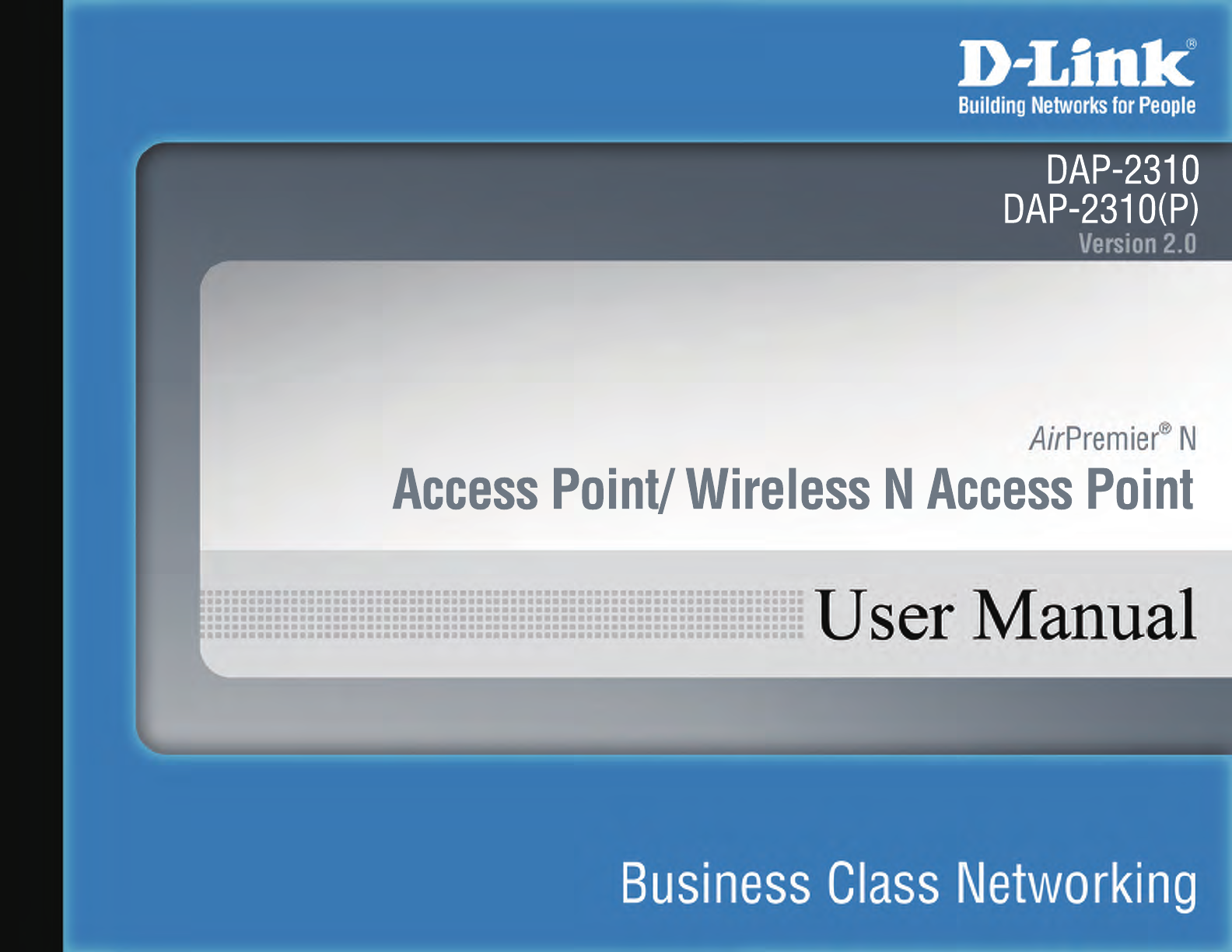
DAP-2310
(
P
)
DAP-2310
無線基地台

2D-Link DAP-2310 User Manual
Table of Contents
Product Overview .............................................................. 4
Package Contents ......................................................................... 4
System Requirements ................................................................. 4
Introduction ................................................................................... 5
Features ............................................................................................ 7
Wireless Basics ................................................................... 8
Standards-Based Technology ................................................... 9
Wireless Installation Considerations ....................................10
Hardware Overview ...................................................................11
LEDs .........................................................................................11
Hardware Overview ...................................................................12
Connections .........................................................................12
Five Operational Modes ..................................................13
Getting Started ................................................................14
Conguration ...................................................................15
Save and Activate Settings ......................................................16
Basic Settings ...............................................................................17
Wireless .................................................................................17
Access Point mode ........................................................17
WDS with AP mode ......................................................19
WDS mode .......................................................................21
Wireless Client mode ....................................................23
AP Repeater mode.........................................................25
Open System/Shared Key Authentication ...........26
WPA/WPA2-Personal Authentication ......................27
WPA/WPA2-Enterprise Authentication ..................28
802.1x Authentication ..................................................29
LAN .........................................................................................30
IPv6 ..........................................................................................31
Advanced Settings .....................................................................32
Performance .........................................................................32
Multi-SSID ..............................................................................34
VLAN ........................................................................................36
VLAN List ...........................................................................36
Port List ..............................................................................37
Add/Edit VLAN ................................................................38
PVID Setting .....................................................................39
Intrusion .................................................................................40
Schedule ................................................................................41
Internal RADIUS Server .....................................................42
ARP Spoong Prevention Settings ...............................43
Bandwidth Optimization .................................................44
AP Array ..................................................................................46
AP Array Scan ..................................................................47
Conguration Settings .................................................48
Auto-RF ..............................................................................49
Load Balance ...................................................................50
Captive Portal ......................................................................51
Authentication Settings - Ticket ...............................51
Authentication Settings - User/Password .............52
Table of Contents

3D-Link DAP-2310 User Manual
Table of Contents
Authentication Settings - Remote RADIUS ...........53
Authentication Settings - LDAP ................................54
Authentication Settings - POP3 ................................55
Login Page Upload .............................................................56
Web Redirection ..................................................................57
DHCP Server ........................................................................58
Dynamic Pool Settings .................................................58
Static Pool Setting .........................................................60
Current IP Mapping List ...............................................62
Filters .......................................................................................63
Wireless MAC ACL ..........................................................63
WLAN Partition ...............................................................64
Trac Control .......................................................................65
Uplink/Downlink Settings ..........................................65
QoS ......................................................................................66
Trac Manager ...............................................................67
Status .............................................................................................68
Device Information ............................................................68
Client Information ..............................................................69
WDS Information ................................................................70
Stats .........................................................................................71
Ethernet .............................................................................71
WLAN Trac ....................................................................72
Log ...........................................................................................73
View Log ............................................................................73
Log Settings .....................................................................74
Maintenance ...............................................................................75
Administration Settings ...................................................75
Limit Administrator .......................................................76
System Name Settings .................................................77
Login Settings .................................................................78
Console Settings ............................................................79
SNMP Settings ................................................................80
Central WiFiManager Settings ...................................81
Firmware and SSL Certication Upload ..............................82
Conguration File Upload .......................................................83
Time and Date .............................................................................84
System ....................................................................................85
System Settings ..............................................................85
Help .................................................................................................86
Troubleshooting ..............................................................87
Networking Basics ...........................................................87
Check your IP address ...............................................................87
Statically Assign an IP address ...............................................89
Technical Specications ..................................................92

4D-Link DAP-2310 User Manual
Section 1 - Product Overview
D-Link DAP-2310
D-Link DAP-2310(P) 無線基地台
AirPremier® Access Point / Wireless N Access Point
CAT5 Ethernet Cable
Two Detachable Antennas
Power Adapter
CD-ROM with User Manual
Install Guide
System Requirements
• Computers with Windows®, Macintosh®, or Linux-based operating systems with an installed Ethernet Adapter
• For conguration, the following web browsers are supported:
• Microsoft® Internet Explorer® 6.0 and higher
• Mozilla Firefox 3.0 and higher
• Google™ Chrome 2.0 and higher
• Apple Safari 3.0 and higher
Product Overview
Package Contents
Note: Using a power supply with a dierent voltage rating than the one included with the DAP-2310 will cause damage and
void the warranty for this product.

5D-Link DAP-2310 User Manual
Section 1 - Product Overview
Introduction
The DAP-2310 802.11n AP increases productivity by allowing you to work faster and more eciently. With the DAP-2310,
bandwidth-intensive applications like graphics or multimedia will benet signicantly because large les are now able to move
across the network quickly.
The DAP-2310 is capable of operating in one of four dierent wireless networking modes: Access Point, WDS (Wireless Distribution
System) with AP, WDS, Wireless Client mode or AP Repeater mode.
An ideal solution for quickly creating and extending a wireless local area network (WLAN) in oces or other workplaces, trade
shows, and special events, the DAP-2310 provides data transfer rates up to 300Mbps. (The 802.11n standard is backwards
compatible with 802.11g and 802.11b devices.)
WPA/WPA2 is oered in two options: Enterprise (used for corporations) and Personal (used for home users). WPA-Personal and
WPA2-Personal are directed towards home users who do not have the server-based equipment required for user authentication.
This method of authentication is similar to WEP because you dene a “Pre-Shared Key” on the wireless router/AP. Once the
pre-shared key is conrmed and satised at both the client and access point, access is then granted. The encryption method
used is referred to as the Temporal Key Integrity Protocol (TKIP), which oers per-packet dynamic hashing. It also includes an
integrity checking feature which ensures that the packets were not tampered with during wireless transmission.
WPA-Enterprise and WPA2-Enterprise are ideal for businesses that already have existing security infrastructures established.
Management and security implementation can now be centralized on a server participating on the network. Utilizing 802.1X
with a RADIUS (Remote Authentication Dial-in User Service) server, a network administrator can dene a list of authorized
users who can access the wireless LAN. When attempting to access a wireless LAN with WPA-Enterprise congured, the new
client will be requested to enter a username with a password. If the new client is authorized by the administration, and enters
the correct username and password, then access is granted. In the case where an employee leaves the company, the network
administrator is able to remove the previous employee from the authorized list to avoid compromising the network.

6D-Link DAP-2310 User Manual
Section 1 - Product Overview
EAP (Extensible Authentication Protocol) is available through the Windows® XP operating system. You will need to use the same
type of EAP protocol on all devices in your network when using the 802.1X feature.
*Maximum wireless signal rate derived from IEEE Standard 802.11n and 802.11g specications. Actual data throughput may vary. Network conditions
and environmental factors, including volume of network trac, building materials and construction, and network overhead can lower actual data
throughout rate.

7D-Link DAP-2310 User Manual
Section 1 - Product Overview
• Five dierent operation modes - Capable of operating in one of four dierent operation modes to meet your wireless
networking needs: Access Point, WDS with AP, WDS, Wireless Client or AP Repeater mode.
• Faster wireless networking with the 802.11n standard to provide a maximum wireless signal rate of up to 300 Mbps*.
• Compatible with the 802.11b standard to provide a wireless data rate of up to 11Mbps, allowing you to migrate your
system to the 802.11n and 802.11g standards on your own schedule without sacricing connectivity.
• Compatible with the 802.11g standard to provide a wireless data rate of up to 54Mbps in the 2.4GHz frequency range.
• Better security with WPA - The DAP-2310 can securely connect wireless clients on the network using WPA (Wi-Fi Protected
Access) to provide a much higher level of security for your data and communications than its previous versions.
• Central WiFiManager management software - The real-time display of the network's topology and AP’s information
makes network conguration and management quick and simple.
• SNMP for management - The DAP-2310 is not just fast, but also supports SNMP v.3 for better network management.
Superior wireless AP manager software is bundled with the DAP-2310 for network conguration and rmware upgrade.
Systems administrators can also set up the DAP-2310 easily with the Web-based conguration.
• Utilizes OFDM technology (Orthogonal Frequency Division Multiplexing).
• Supports one 10/100/1000M Ethernet port.
• Operates in the 2.4 ~ 2.4835GHz frequency ranges.
• Web-based interface for managing and conguring.
*Maximum wireless signal rate derived from IEEE Standard 802.11n and 802.11g specications. Actual data throughput may vary. Network conditions and environmental factors,
including volume of network trac, building materials and construction, and network overhead can lower actual data throughout rate.
Features

8D-Link DAP-2310 User Manual
Section 2 - Installation
Wireless Basics
D-Link wireless products are based on industry standards to provide high-speed wireless connectivity that is easy to use within
your home, business or public access wireless networks. D-Link wireless products provides you with access to the data you
want, whenever and wherever you want it. Enjoy the freedom that wireless networking can bring to you.
WLAN use is not only increasing in both home and oce environments, but in public areas as well, such as airports, coee
shops and universities. Innovative ways to utilize WLAN technology are allowing people to work and communicate more
eciently. Increased mobility and the absence of cabling and other types of xed infrastructure have proven to be benecial
to many users.
Wireless adapter cards used on laptop and desktop systems support the same protocols as Ethernet adapter cards, allowing
wireless users to use the same applications as those used on a wired network.
People use WLAN technology for many dierent purposes:
Mobility - productivity increases when people can have access to data in any location within the operating range of
their WLAN. Management decisions based on real-time information can signicantly improve the eciency of a worker.
Low implementation costs - WLANs are easy to set up, manage, change and relocate. Networks that frequently change
can benet from WLAN's ease of implementation. WLANs can operate in locations where installation of wiring may be
impractical.
Installation and network expansion - by avoiding the complications of troublesome cables, a WLAN system can be fast
and easy during installation, especially since it can eliminate the need to pull cable through walls and ceilings. Wireless
technology provides more versatility by extending the network beyond the home or oce.
Inexpensive solution - wireless network devices are as competitively priced as conventional Ethernet network devices.
The DAP-2310 saves money by providing users with multi-functionality congurable in four dierent modes.
Scalability - Congurations can be easily changed and range from Peer-to-Peer networks, suitable for a small number
of users to larger Infrastructure networks to accommodate hundreds or thousands of users, depending on the number
of wireless devices deployed.

9D-Link DAP-2310 User Manual
Section 2 - Installation
Standards-Based Technology
The DAP-2310 Wireless Access Point utilizes the 802.11b, 802.11g, and 802.11n standards.
The IEEE 802.11n standard is an extension of the 802.11b and 802.11g standards that came before it. It increases the maximum
wireless signal rate up to 300Mbps* within the 2.4GHz bands, utilizing OFDM technology.
This means that in most environments - within the specied range of this device - you will be able to transfer large les quickly,
or even watch a movie in MPEG format over your network without noticeable delays. This technology works by transmitting
high-speed digital data over a radio wave utilizing OFDM (Orthogonal Frequency Division Multiplexing) technology. OFDM
works by splitting the radio signal into multiple smaller sub-signals that are then simultaneously transmitted at dierent
frequencies to the receiver. OFDM reduces the amount of crosstalk (interference) in signal transmissions.
The D-Link DAP-2310 will automatically sense the best possible connection speed to ensure the greatest possible speed and
range.
IEEE 802.11n oers the most advanced network security features available today, including WPA.
*Maximum wireless signal rate derived from IEEE Standard 802.11n and 802.11g specications. Actual data throughput may vary. Network conditions and environmental factors, including volume of network trac, building
materials and construction, and network overhead can lower actual data throughout rate.

10D-Link DAP-2310 User Manual
Section 2 - Installation
Wireless Installation Considerations
The D-Link AirPremier® N wireless access point lets you access your network using a wireless connection from virtually anywhere
within the operating range of your wireless network. Keep in mind, however, that the number, thickness and location of walls,
ceilings, or other objects that the wireless signals must pass through, may limit the range. Typical ranges vary depending on
the types of materials and background RF (radio frequency) noise in your home or business. The key to maximizing wireless
range is to follow these basic guidelines:
1. Keep the number of walls and ceilings between the access point and other network devices to a minimum.
Each wall or ceiling can reduce your adapter’s range from 3-90 feet (1-30 meters). Position your devices so that
the number of walls or ceilings is minimized.
2. Be aware of the direct line between network devices. A wall that is 1.5 feet thick (.5 meters), at a 45-degree
angle appears to be almost 3 feet (1 meter) thick. At a 2-degree angle, it looks over 42 feet (14 meters) thick!
Position devices so that the signal will travel straight through a wall or ceiling (instead of at an angle) for better
reception.
3. Building Materials make a dierence. A solid metal door or aluminum studs may have a negative eect on the
range. Try to position access points, wireless routers, and computers so that the signal passes through drywall
or open doorways. Materials and objects such as glass, steel, metal, walls with insulation, water (sh tanks),
mirrors, le cabinets, brick, and concrete will degrade your wireless signal.
4. Keep your product away (at least 3-6 feet or 1-2 meters) from electrical devices or appliances that generate RF
noise.
5. If you are using 2.4GHz cordless phones or X-10 (wireless products such as ceiling fans, lights, and home security
systems), your wireless connection may degrade dramatically or drop completely. Make sure your 2.4GHz phone
base is as far away from your wireless devices as possible. The base transmits a signal even if the phone in not
in use.
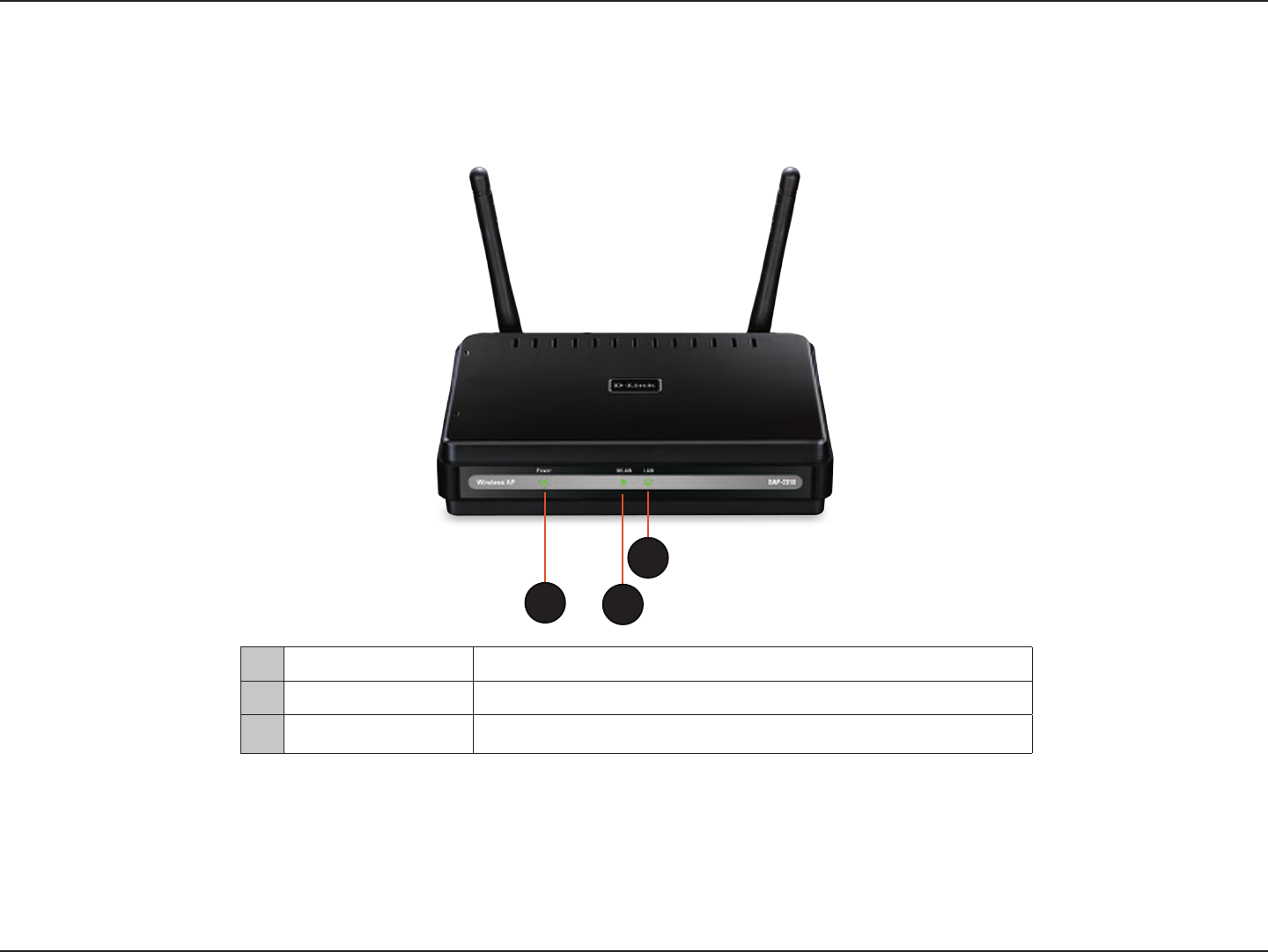
11D-Link DAP-2310 User Manual
Section 2 - Installation
Hardware Overview
LEDs
1Power LED This light will be solid green when the unit is powered on.
2WLAN LED This light will be ickering green when the 2.4GHz frequency is in use.
3LAN LED This light will be ickering green when there is active LAN trac.
12
3
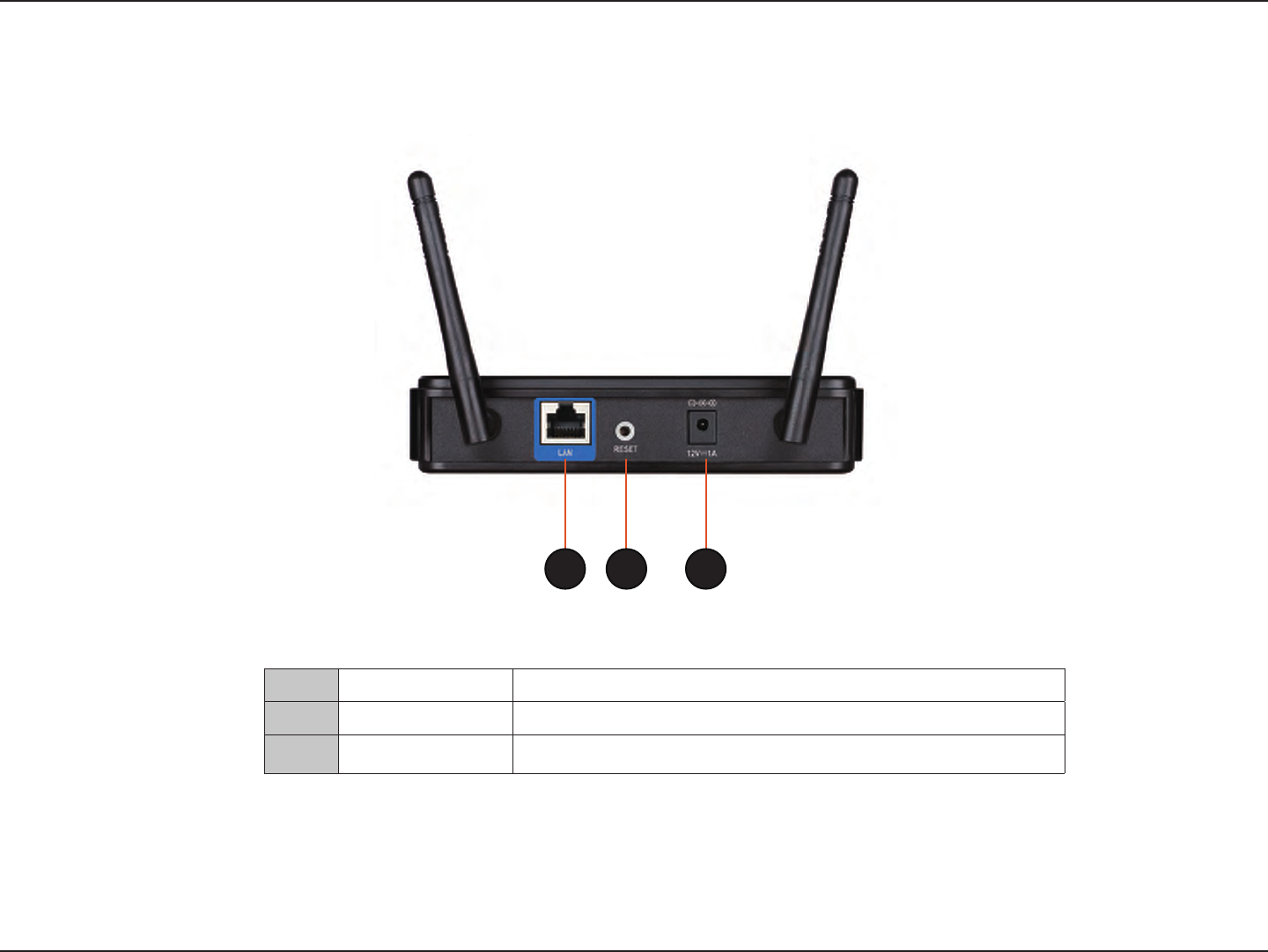
12D-Link DAP-2310 User Manual
Section 2 - Installation
Connections
Hardware Overview
1 2 3
1LAN Port Connects the DAP-2310 to a switch or PC.
2Reset Reset the Access Point.
3Power Receptor Receptor for Power Adapter.
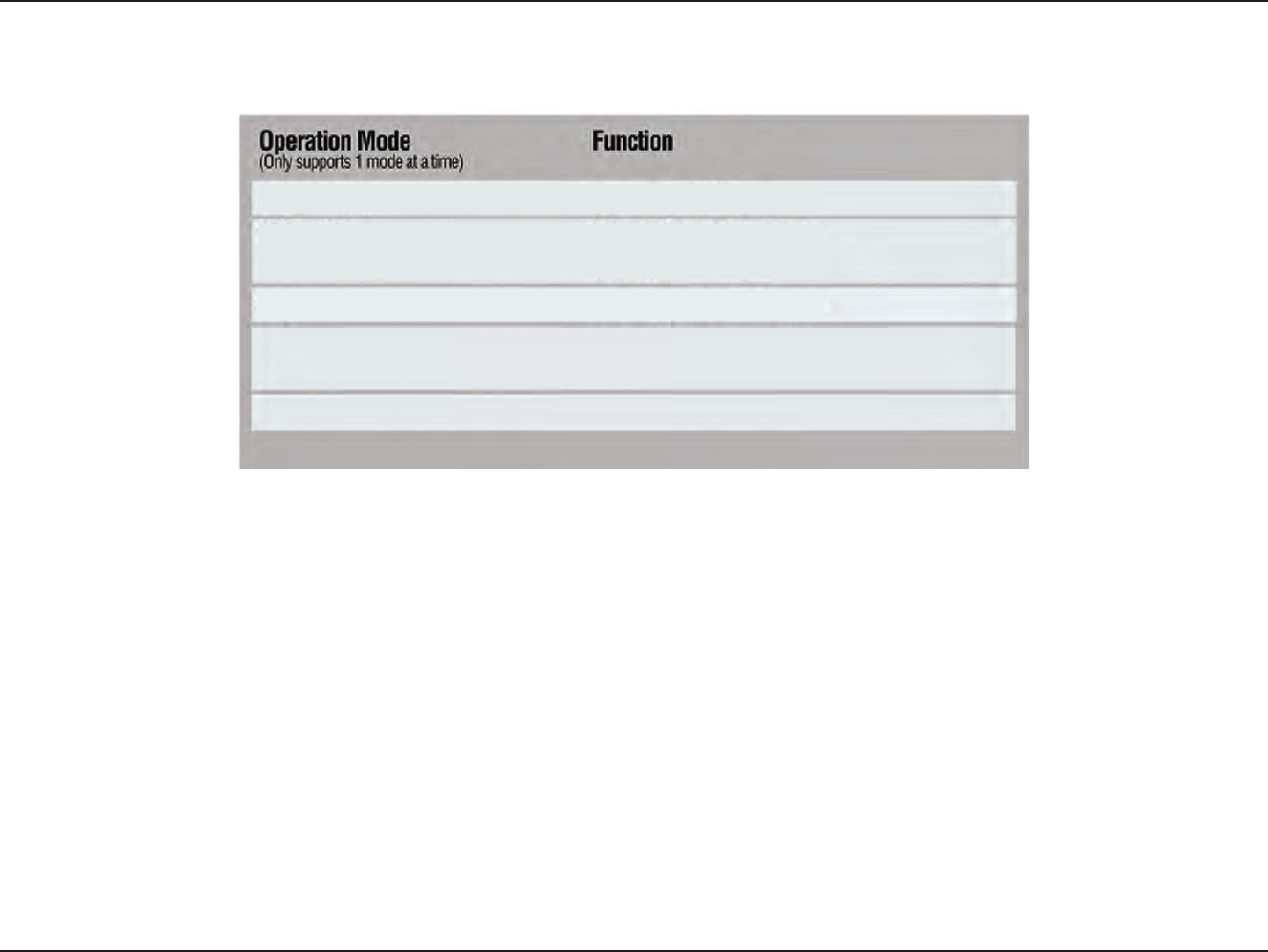
13D-Link DAP-2310 User Manual
Section 2 - Installation
Five Operational Modes
Wireless Client
AP Repeater
AP acts as a wireless network adapter for your Ethernet-
enabled device
AP acts as repeater to extend to wireless coverage.
Access Point (AP) Create a wireless LAN
WDS with AP Wirelessly connect multiple networks while still
functioning as a wireless AP
WDS Wirelessly connect multiple networks
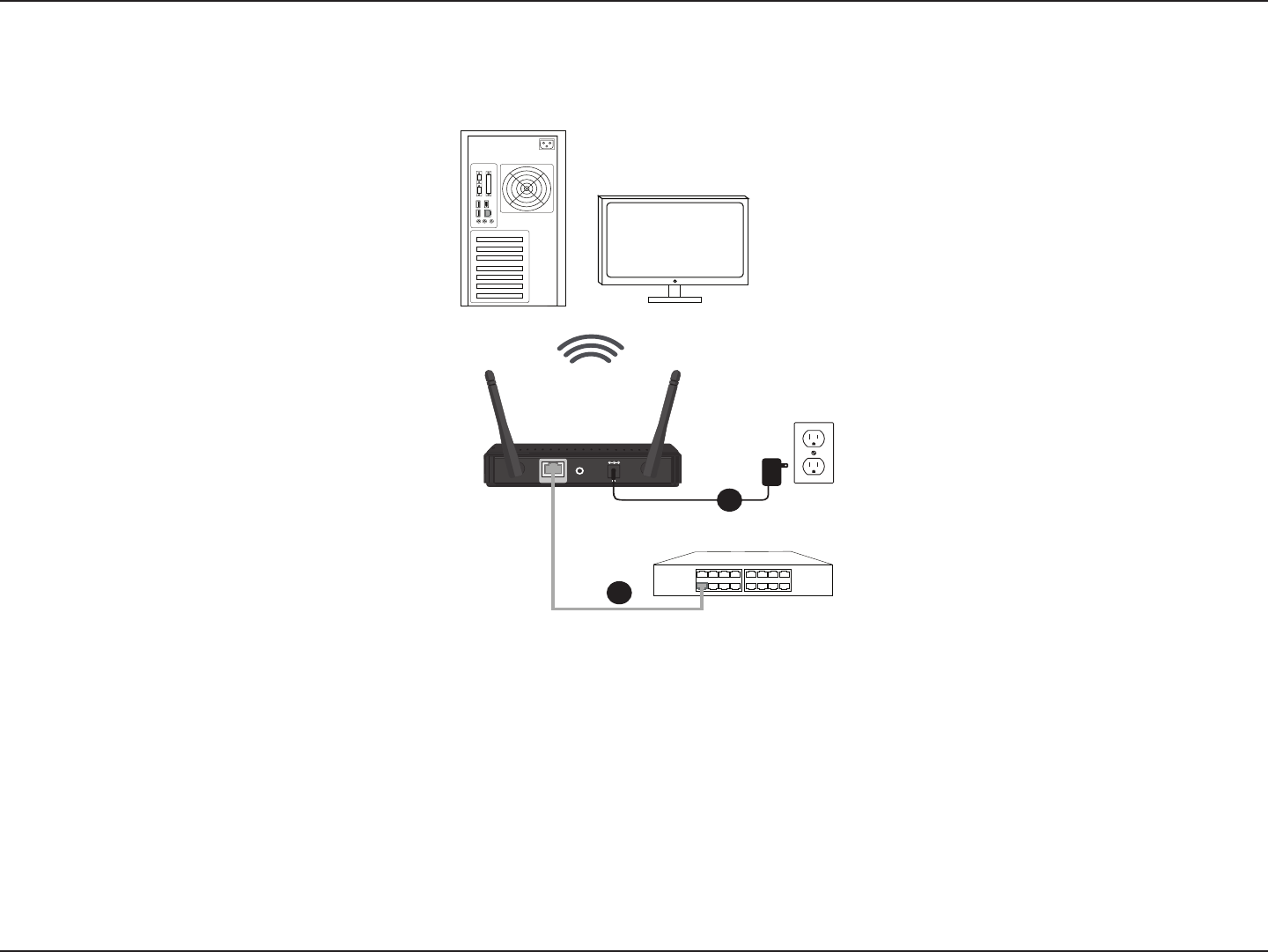
14D-Link DAP-2310 User Manual
Section 2 - Installation
Getting Started
1. Connect the power adapter to the receptor on the rear panel of the DAP-2310 and then plug the other end of the
power adapter to a wall outlet or power strip. The power LED will turn ON to indicate proper operation.
2. Using an Ethernet cable, insert one end of the cable to the LAN port on the rear panel of the DAP-2310 and the other
end of the cable to a switch or router’s LAN port .
Note: You can also connect the DAP-2310 directly to the computer that will be used for conguration. The LAN LED
will illuminate to indicate a proper Ethernet connection.
3. Computers with 802.11 b/g/n wireless adapters can connect to the DAP-2310.
LAN
RESET
12V
1A
1
2
LAN
RESET
12V
1A
or
DAP-2310
Switch
Monitor
Desktop
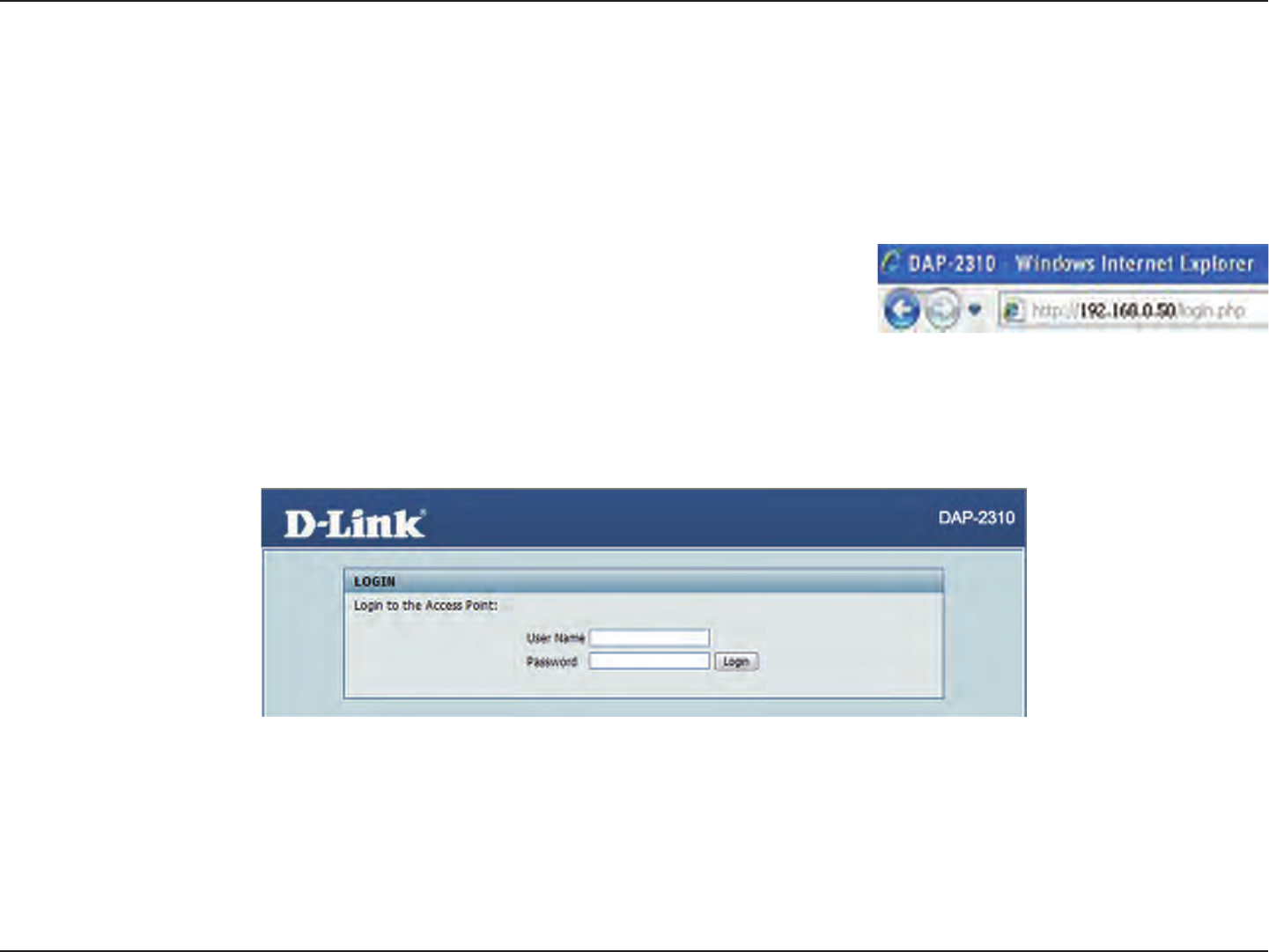
15D-Link DAP-2310 User Manual
Section 3 - Conguration
Conguration
To congure the DAP-2310, use a computer that is connected to the DAP-2310 with an Ethernet cable (see the
Network Layout
diagram
).
Launch your web browser.
Type the IP address of the DAP-2310 in the address eld (http://192.168.0.50) and
press Enter. Make sure that the IP addresses of the DAP-2310 and your computer are
in the same subnet.
Note: If you have changed the default IP address assigned to the DAP-2310, make sure to enter the correct IP address.
Enter the user name (admin) and your password. Leave the password eld blank by default and click Login.
Note: If you have changed the password, make sure to enter the correct password.
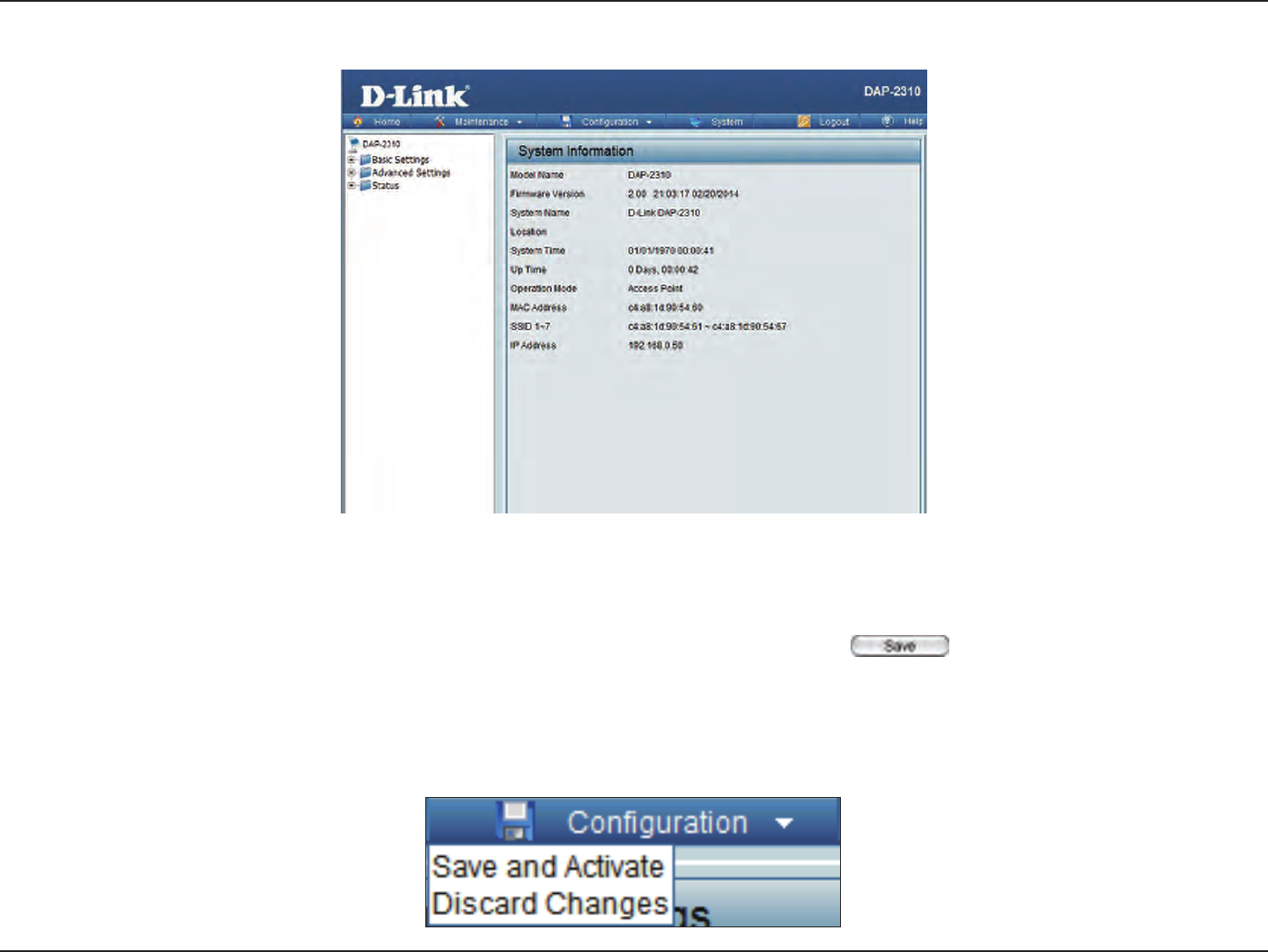
16D-Link DAP-2310 User Manual
Section 3 - Conguration
After successfully logging into the DAP-2310, the following screen will appear:
When making changes on most of the conguration screens in this section, use the button at the bottom of each
screen to save (not activate) your conguration changes.
You may change settings to multiple pages before activating. Once you are nished, click the Conguration button located
at the top of the page and then click Save and Activate.
Save and Activate Settings
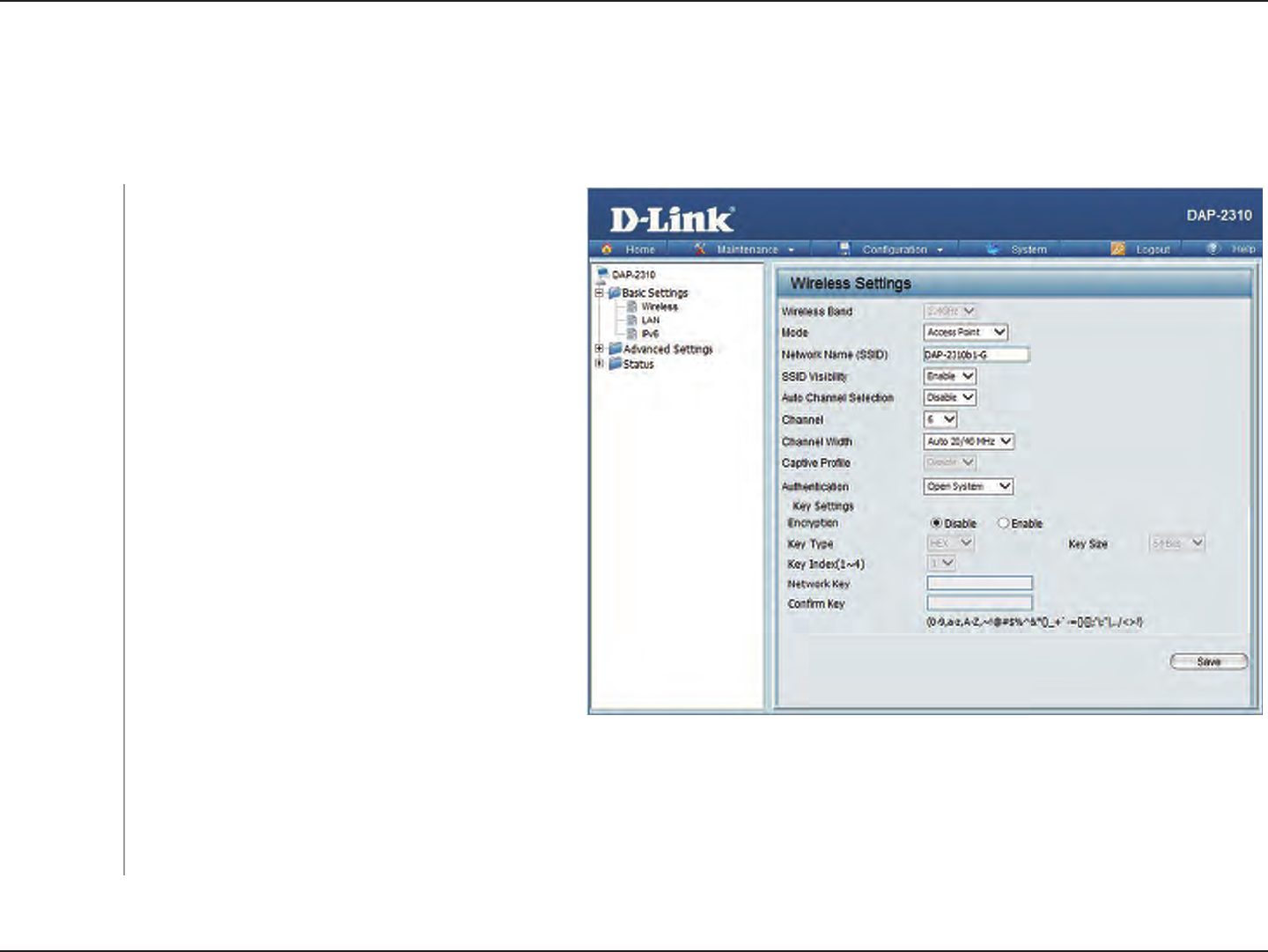
17D-Link DAP-2310 User Manual
Section 3 - Conguration
Basic Settings
Wireless
Access Point mode
Select Access Point from the drop-down menu.
The other three choices are WDS with AP, WDS,
and Wireless Client.
Service Set Identier (SSID) is the name designated
for a specic wireless local area network (WLAN).
The SSID’s factory default setting is dlink. The SSID
can be easily changed to connect to an existing
wireless network or to establish a new wireless
network. The SSID can be up to 32 characters and
is case-sensitive.
Enable or Disable SSID visibility. Enabling this
feature broadcasts the SSID across the network,
thus making it visible to all network users. This
feature is enabled by default.
Enabling this feature automatically selects
the channel that provides the best wireless
performance. Enable is set by default. The channel selection process only occurs when the AP is booting up.
All devices on the network must share the same channel. To change the channel, rst toggle the Auto Channel Selection setting to
Disable, and then use the drop-down menu to make the desired selection.
Note: The wireless adapters will automatically scan and match the wireless settings.
Mode:
Network Name
(SSID):
SSID Visibility:
Auto Channel
Selection:
Channel:
Wireless Band: Select 2.4GHz from the drop-down menu.

18D-Link DAP-2310 User Manual
Section 3 - Conguration
Channel Width:
Authentication:
Allows you to select the channel width you would like to operate in. Select 20 MHz if you are not using any 802.11n wireless clients.
Auto 20/40 MHz allows you to connect to both 802.11n and 802.11b/g wireless devices on your network.
Use the drop-down menu to choose Open System, Shared Key, WPA-Personal, WPA-Enterprise, or 802.11x.
Select Open System to communicate the key across the network.
Select Shared Key to limit communication to only those devices that share the same WEP settings. If multi-SSID is enabled, this
option is not available.
Select WPA-Personal to secure your network using a password and dynamic key changes. No RADIUS server is required.
Select WPA-Enterprise to secure your network with the inclusion of a RADIUS server.
Select 802.1x to secure your network using 802.1x authentication.
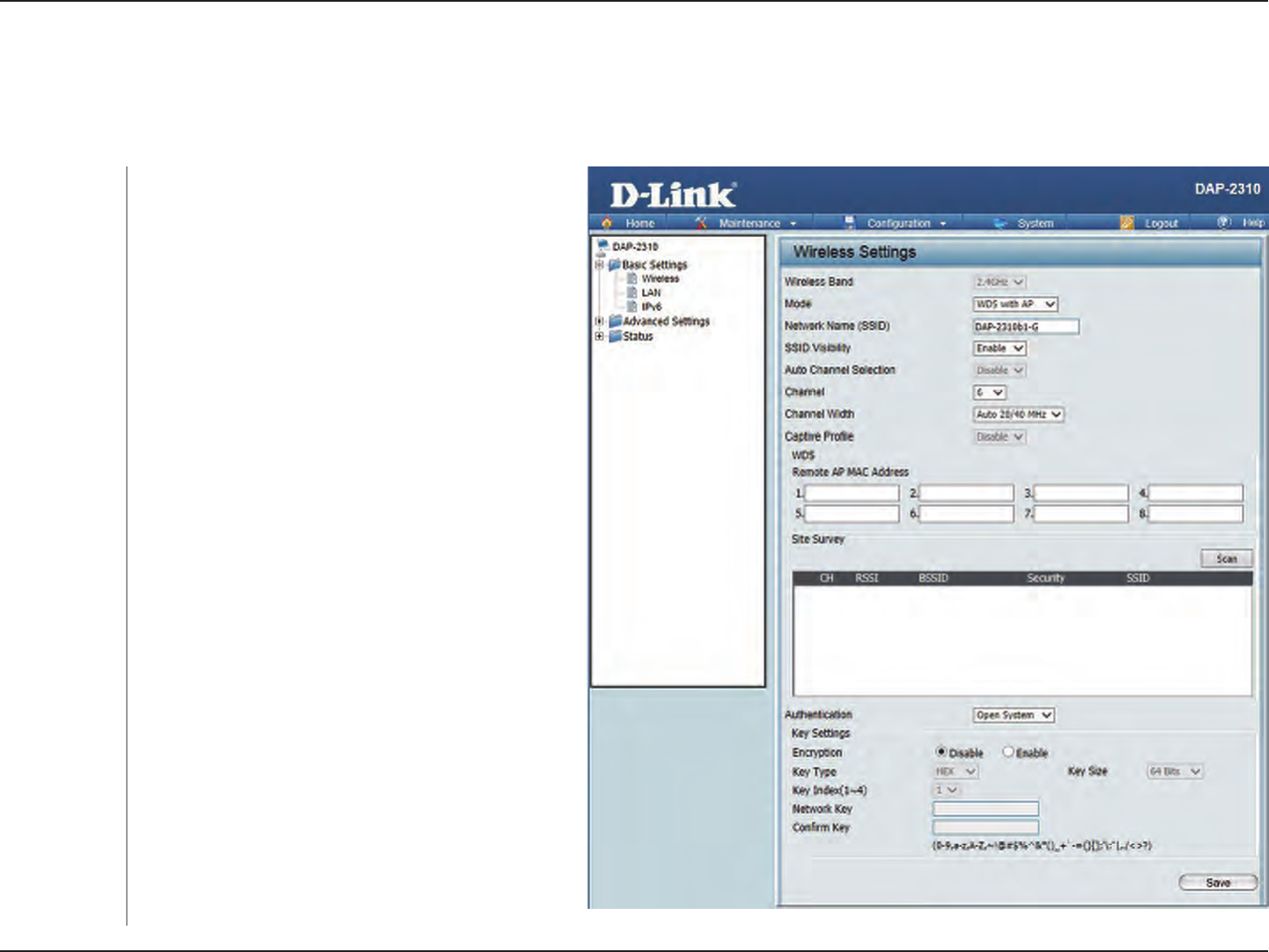
19D-Link DAP-2310 User Manual
Section 3 - Conguration
WDS with AP mode
Select 2.4GHz from the drop-down menu.
WDS with AP mode is selected from the drop-
down menu.
Service Set Identier (SSID) is the name designated
for a specic wireless local area network (WLAN).
The SSID’s factory default setting is dlink. The SSID
can be easily changed to connect to an existing
wireless network or to establish a new wireless
network.
Enable or Disable SSID visibility. Enabling this
feature broadcasts the SSID across the network,
thus making it visible to all network users.
Enabling this feature automatically selects
the channel that will provide the best wireless
performance. This feature is not supported
in WDS with AP mode. The channel selection
process only occurs when the AP is booting up.
To change the channel, use the drop-down menu
to make the desired selection. (Note: The wireless
adapters will automatically scan and match the
wireless settings.)
Indicates whether the device is capable of 20MHz
operation only or both 20MHz and 40MHz
operation.
Wireless Band:
Mode:
Network Name
(SSID):
SSID Visibility:
Auto Channel
Selection:
Channel:
Channel Width:
In WDS with AP mode, the DAP-2310 wirelessly connects multiple networks while still functioning as a wireless AP.

20D-Link DAP-2310 User Manual
Section 3 - Conguration
Enter the MAC addresses of the APs on your network that will serve as bridges to wirelessly connect multiple networks.
Click on the Scan button to search for available wireless networks, then click on the available network that you want to connect with.
Use the drop-down menu to choose Open System, Shared Key, or WPA-Personal.
Select Open System to communicate the key across the network.
Select Shared Key to limit communication to only those devices that share the same WEP settings. If multi-SSID is enabled, this
option is not available.
Select WPA-Personal to secure your network using a password and dynamic key changes. No RADIUS server is required.
Remote AP MAC
Address:
Site Survey:
Authentication:
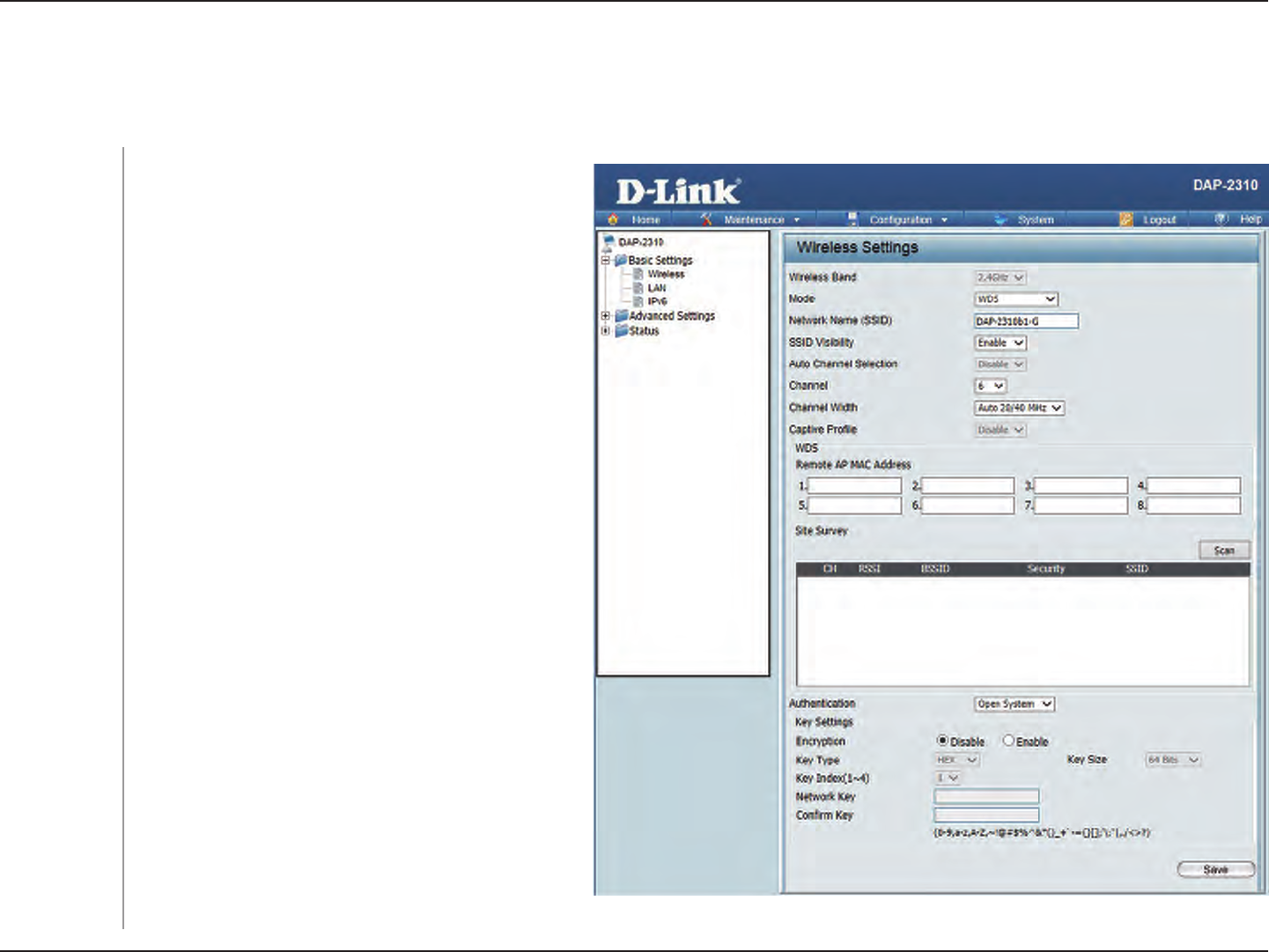
21D-Link DAP-2310 User Manual
Section 3 - Conguration
WDS mode
In WDS mode, the DAP-2310 wirelessly connects multiple networks, without functioning as a wireless AP.
WDS is selected from the drop-down menu.
Service Set Identier (SSID) is the name designated
for a specic wireless local area network (WLAN).
The SSID’s factory default setting is dlink. The SSID
can be easily changed to connect to an existing
wireless network or to establish a new wireless
network.
Enable or Disable SSID visibility. Enabling this
feature broadcasts the SSID across the network,
thus making it visible to all network users.
Enabling this feature automatically selects
the channel that will provide the best wireless
performance. This feature is not supported in
WDS mode.
All devices on the network must share the
same channel. To change the channel, use the
drop-down menu to make the desired selection.
Use the drop-down menu to choose 20 MHz or
Auto 20/40 MHz.
Enter the MAC addresses of the APs on your
network that will serve as bridges to wirelessly
connect multiple networks.
Mode:
Network Name
(SSID):
SSID Visibility:
Auto Channel
Selection:
Channel:
Channel Width:
Remote AP
MAC Address:
Wireless Band: Select 2.4GHz from the drop-down menu.

22D-Link DAP-2310 User Manual
Section 3 - Conguration
Click on the Scan button to search for available wireless networks, then click on the available network that you want to connect with.
Use the drop-down menu to choose Open System, Shared Key, or WPA-Personal.
Select Open System to communicate the key across the network.
Select Shared Key to limit communication to only those devices that share the same WEP settings.
Select WPA-Personal to secure your network using a password and dynamic key changes. No RADIUS server is required.
Site Survey:
Authentication:
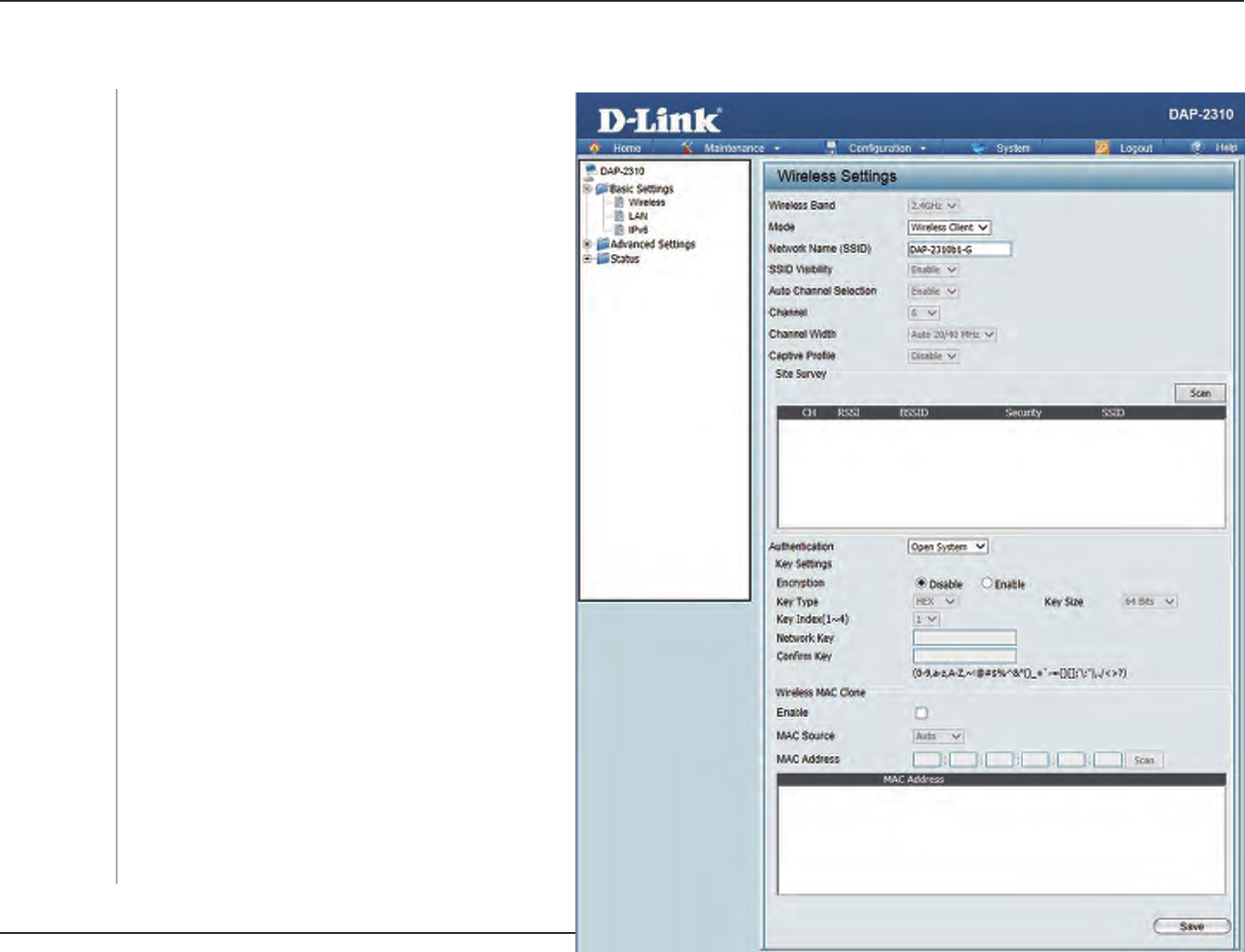
23D-Link DAP-2310 User Manual
Section 3 - Conguration
Wireless Client mode
Wireless Band:
Mode:
Network Name
(SSID):
SSID Visibility:
Auto Channel
Selection:
Channel:
Channel Width:
Site Survey:
Select 2.4GHz from the drop-down menu.
Wireless Client is selected from the drop-down
menu.
Service Set Identier (SSID) is the name
designated for a specic wireless local area
network (WLAN). The SSID’s factory default
setting is dlink. The SSID can be easily changed
to connect to an existing wireless network.
This option is unavailable in Wireless Client
mode.
Enabling this feature automatically selects
the channel that will provide the best wireless
performance. This feature is not supported in
Wireless Client mode.
The channel used will be displayed, and
matches the AP that the DAP-2310 is connected
to when set to Wireless Client mode.
Use the drop-down menu to choose 20 MHz or
Auto 20/40 MHz.
Click on the Scan button to search for available
wireless networks, then click on the available
network that you want to connect with.
Use the drop-down menu to choose Open
System or WPA-Personal.

24D-Link DAP-2310 User Manual
Section 3 - Conguration
Select Open System to communicate the key across the network.
Select WPA-Personal to secure your network using a password and dynamic key changes. No RADIUS server is required.
Check to enable clone MAC. This feature will allow you to change the MAC address of the access point to the MAC address of a
client.
Select the MAC source from the drop-down menu.
Enter the MAC address that you would like to assign to the access point.
Authentication:
Enable:
MAC Source:
MAC Address:
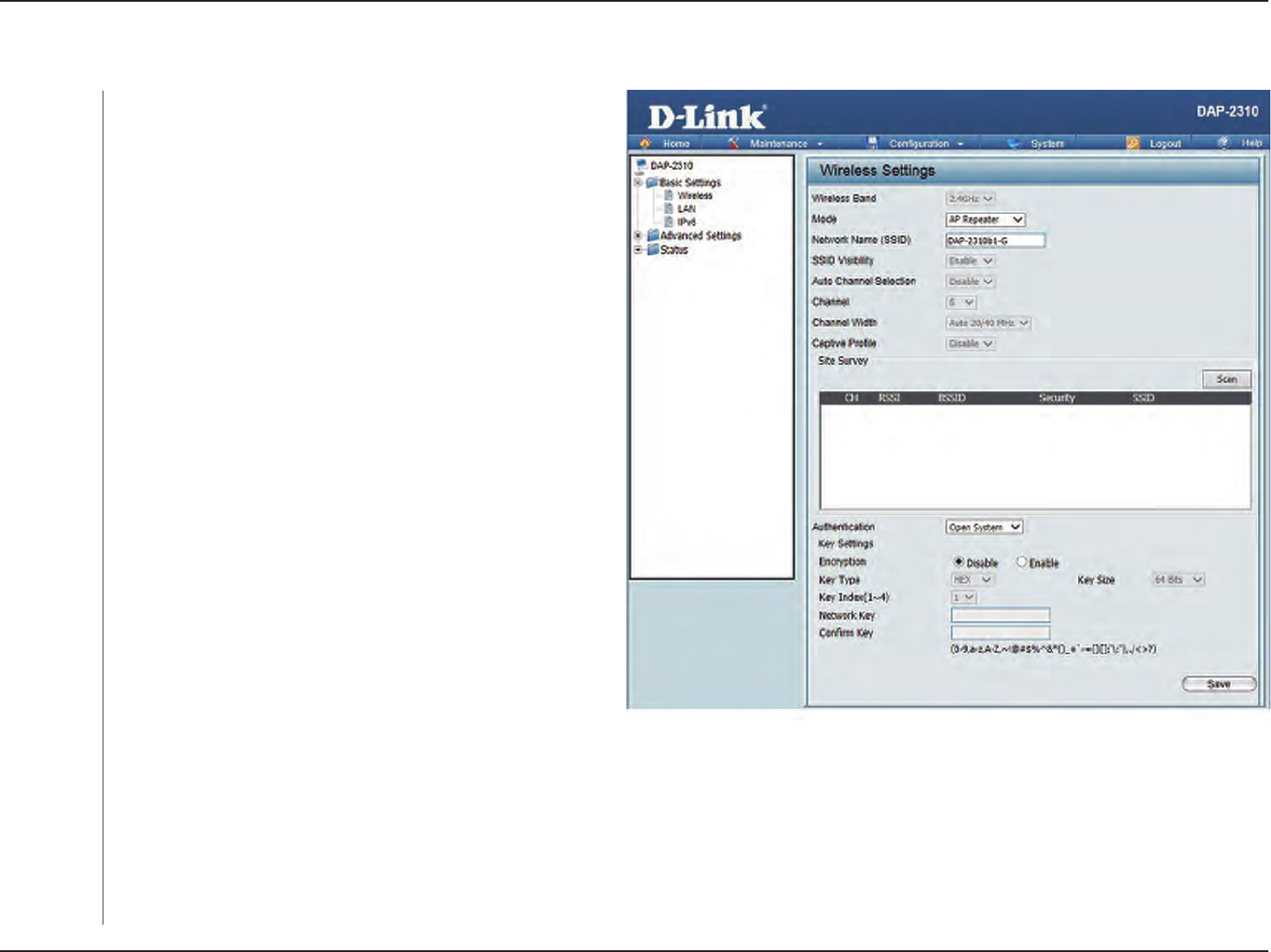
25D-Link DAP-2310 User Manual
Section 3 - Conguration
AP Repeater mode
Mode:
Network Name
(SSID):
SSID Visibility:
Auto Channel
Selection:
Channel:
Channel Width:
Site Survey:
Authentication:
Wireless Band: 2.4 GHz
AP Repeater is selected from the pull-down menu.
Service Set Identier (SSID) is the name designated for
a specic wireless local area network (WLAN). The SSID’s
factory default setting is dlink. The SSID can be easily
changed to connect to an existing wireless network.
This option is unavailable in AP Repeater mode.
Enabling this feature automatically selects the channel
that will provide the best wireless performance. This
feature is not supported in AP Repeater mode.
The channel used will be displayed, and matches the
AP that the DAP-2310 is connected to when set to AP
Repeater mode.
Use the pull-down menu to choose 20 MHz or Auto
20/40 MHz.
Click on the Scan button to search for available wireless
networks, then click on the available network that you
want to connect with.
Use the pull-down menu to choose Open System or WPA-Personal.
Select Open System to communicate the key across the network.
Select WPA-Personal to secure your network using a password and dynamic key changes. No RADIUS server is required.
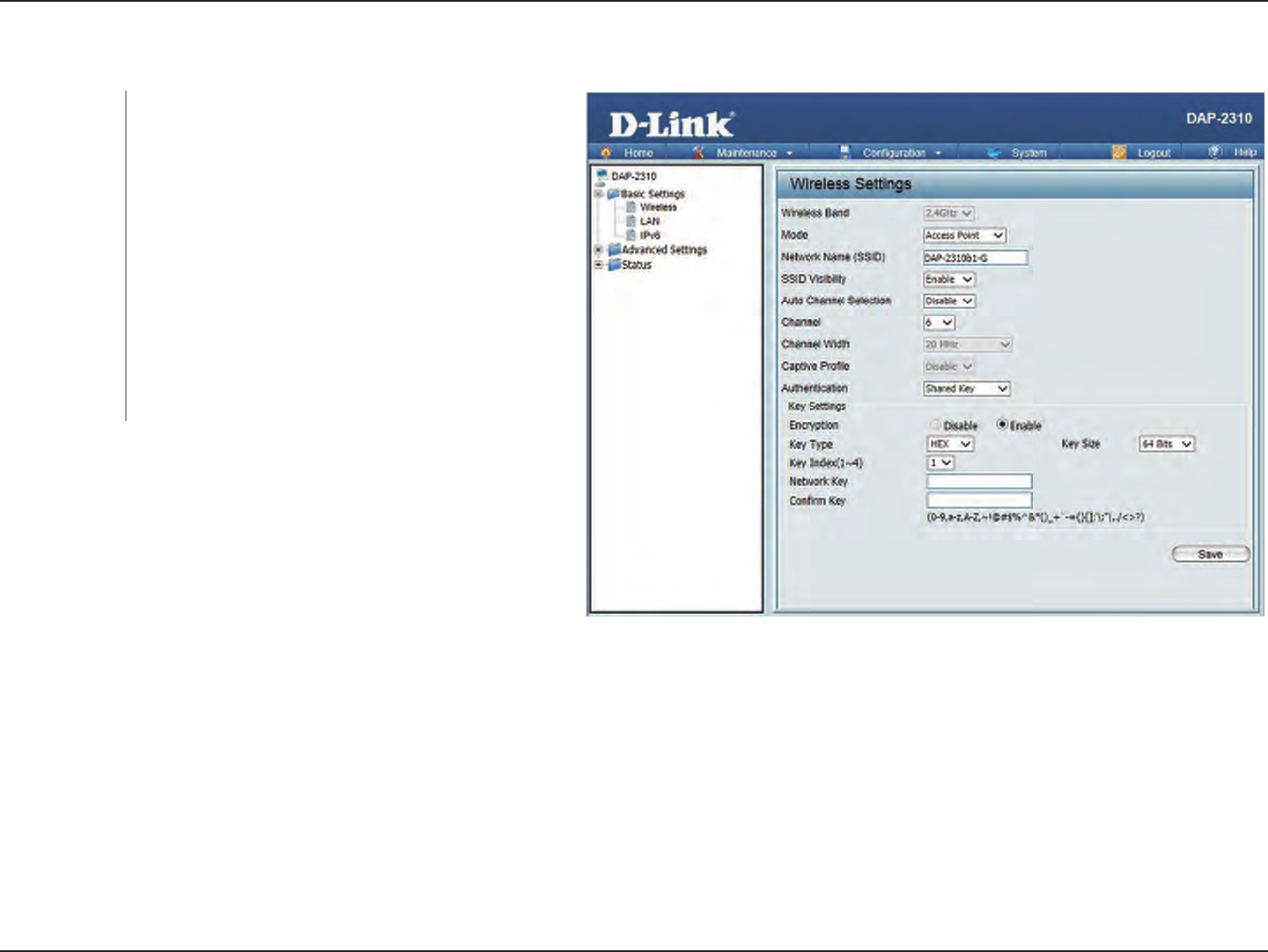
26D-Link DAP-2310 User Manual
Section 3 - Conguration
Open System/Shared Key Authentication
Encryption:
Key Type*:
Key Size:
Key Index (1-4):
Key:
Use the radio button to disable or enable
encryption.
Select HEX or ASCII.
Select 64 Bits or 128 Bits.
Select the 1st through the 4th key to be the active
key.
Input up to four keys for encryption. You will
select one of these keys in the Key Index drop-
down menu.
**Hexadecimal (HEX) digits consist of the numbers 0-9 and the letters A-F.
*ASCII (American Standard Code for Information Interchange) is a code that represents English letters using numbers ranging from 0-127.
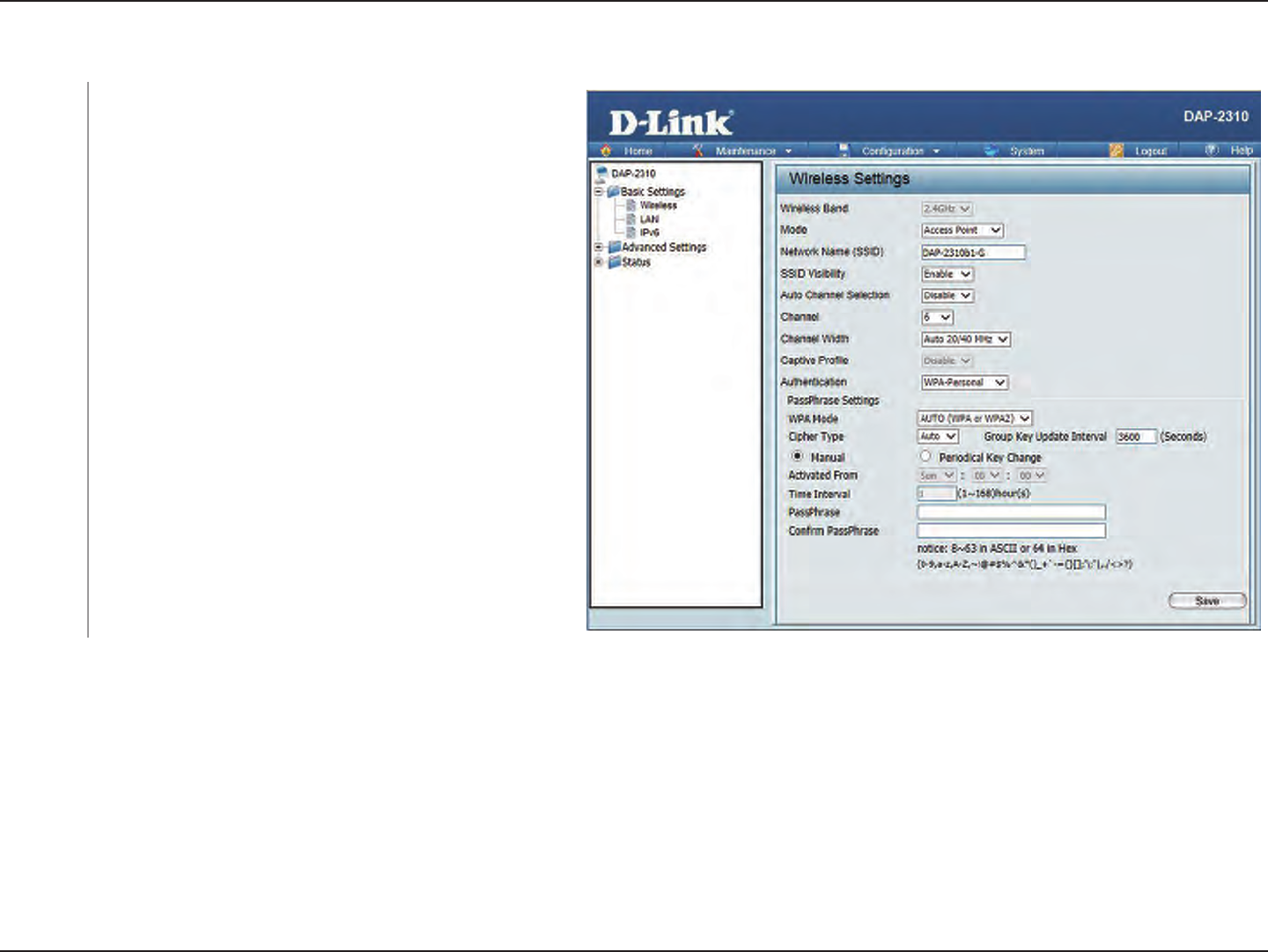
27D-Link DAP-2310 User Manual
Section 3 - Conguration
WPA/WPA2-Personal Authentication
When WPA-Personal is selected for Authentication
type, you must also select a WPA mode from the drop-
down menu: AUTO (WPA or WPA2), WPA2 Only, or
WPA Only. WPA and WPA2 use dierent algorithms.
AUTO (WPA or WPA2) allows you to use both WPA
and WPA2.
When you select WPA-Personal, you must also select
AUTO, AES, or TKIP from the drop-down menu.
Select the interval during which the group key will
be valid. The default value of 1800 is recommended.
Select Manual to enter your key (PassPhrase).
You can select Periodical Key Change to have the
access point automatically change your PassPhrase.
Enter the Activate From time and the time in hours to
change the key.
When you select WPA-Personal, please enter a
PassPhrase in the corresponding eld.
WPA Mode:
Cipher Type:
Group Key
Update:
Periodical Key
Change:
PassPhrase:
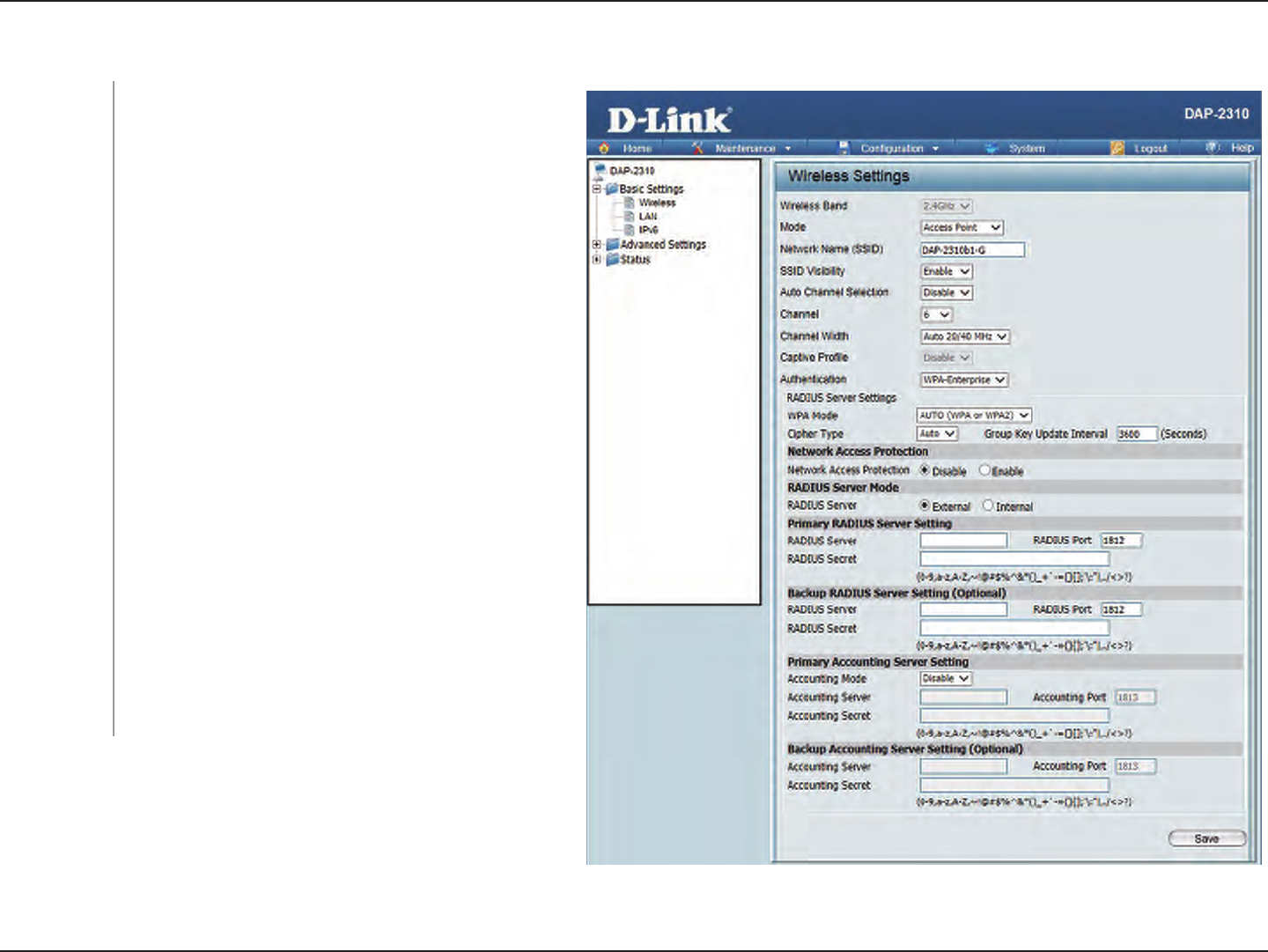
28D-Link DAP-2310 User Manual
Section 3 - Conguration
WPA/WPA2-Enterprise Authentication
When WPA-Enterprise is selected, you must also
select a WPA mode from the drop-down menu:
AUTO (WPA or WPA2), WPA2 Only, or WPA Only.
WPA and WPA2 use dierent algorithms. AUTO
(WPA or WPA2) allows you to use both WPA and
WPA2.
When WPA-Enterprise is selected, you must also
select a cipher type from the drop-down menu:
Auto, AES, or TKIP.
Select the interval during which the group key will
be valid. The recommended value is 1800. A lower
interval may reduce data transfer rates.
Enable or disable Microsoft Network Access
Protection.
Enter the IP address of the RADIUS server.
Enter the RADIUS port.
Enter the RADIUS secret.
WPA Mode:
Cipher Type:
Group Key
Update
Interval:
Network Access
Protection:
RADIUS Server:
RADIUS Port:
RADIUS Secret:
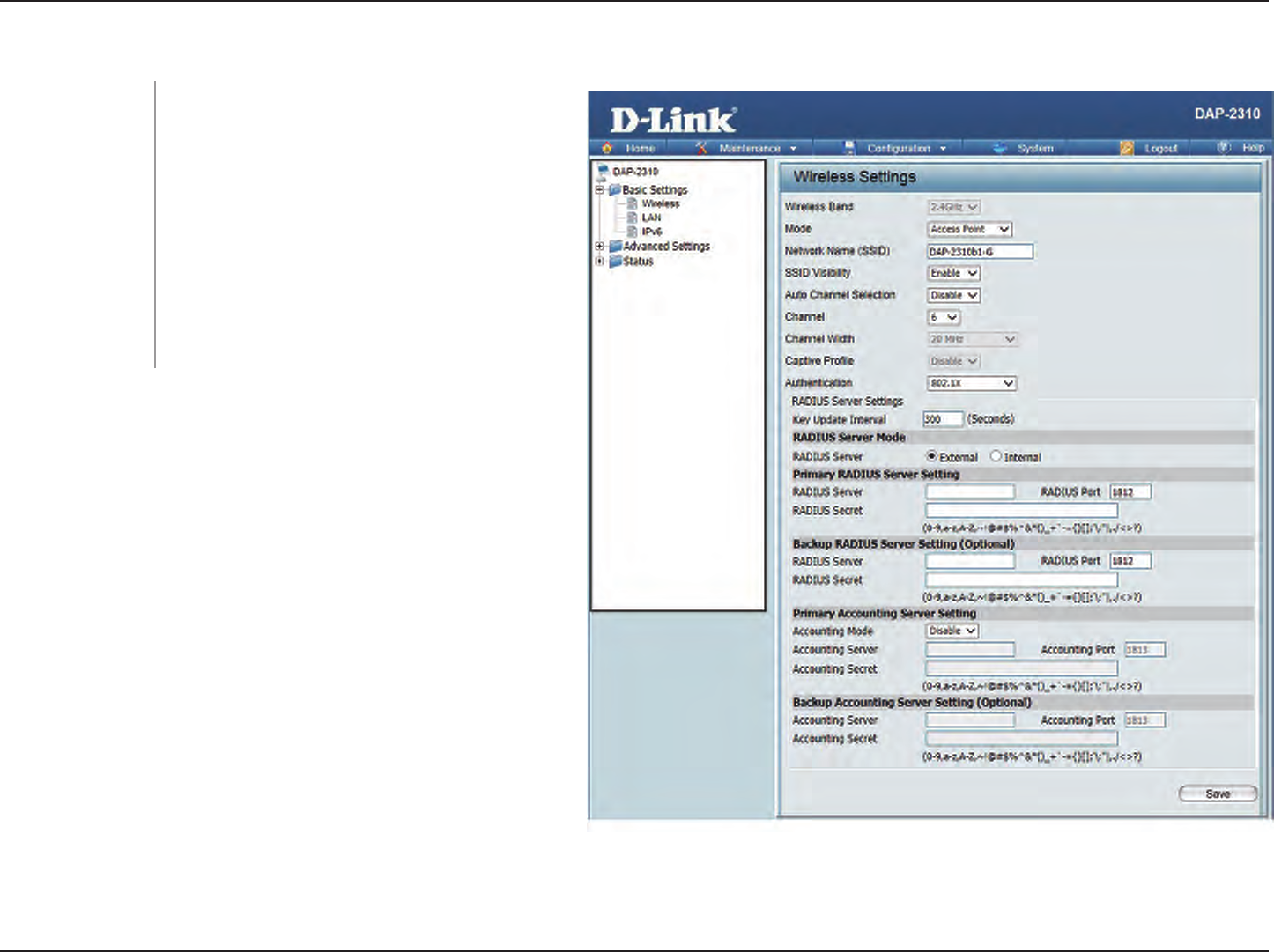
29D-Link DAP-2310 User Manual
Section 3 - Conguration
802.1x Authentication
Select the interval during which the group
key will be valid (300 is the recommended
value). A lower interval may reduce data
transfer rates.
Enter the IP address of the RADIUS server.
Enter the RADIUS port.
Enter the RADIUS secret.
Key Update Interval:
RADIUS Server:
RADIUS Port:
RADIUS Secret:
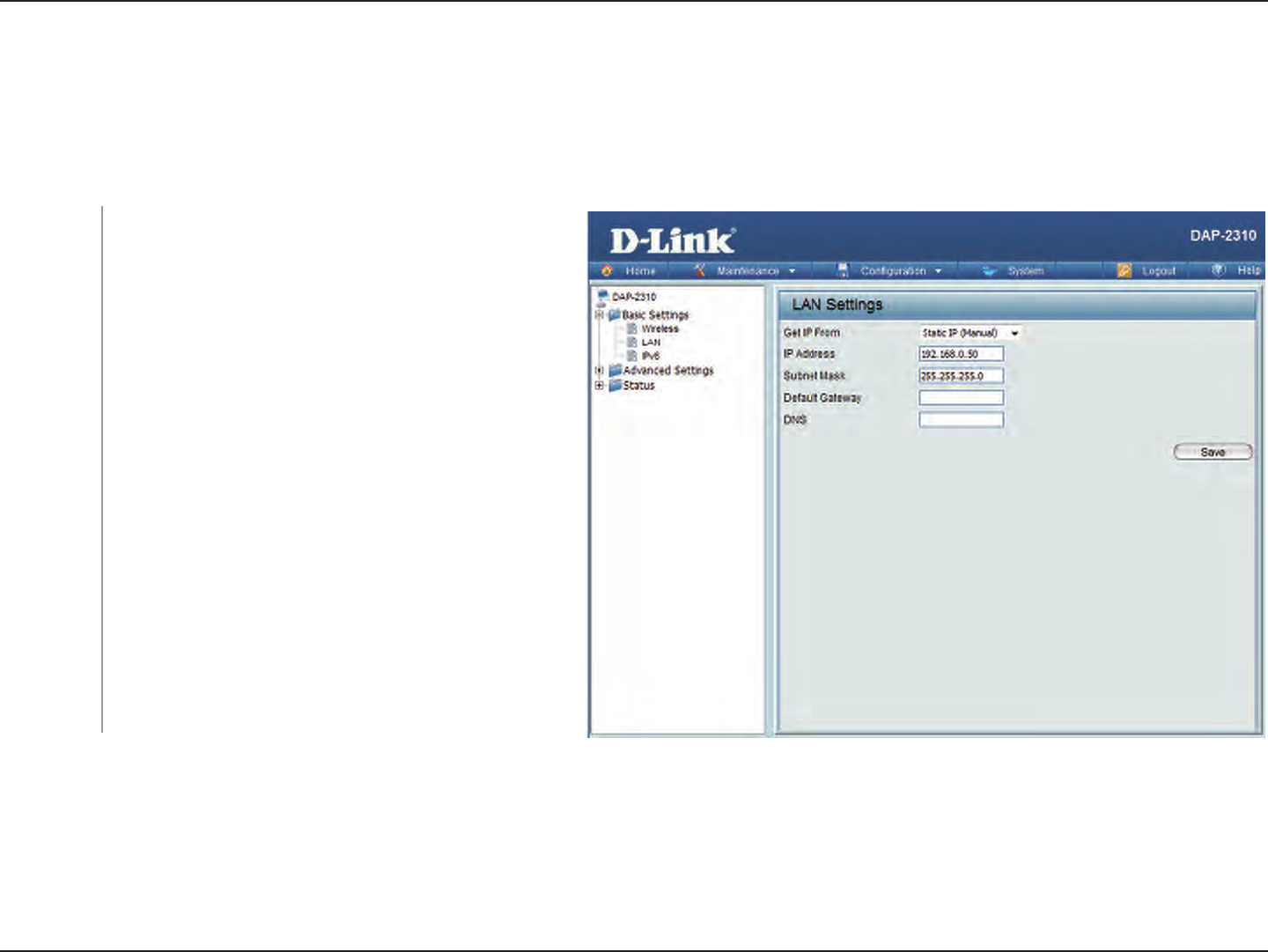
30D-Link DAP-2310 User Manual
Section 3 - Conguration
Static IP (Manual) is chosen here. Choose this option
if you do not have a DHCP server in your network,
or if you wish to assign a static IP address to the
DAP-2310. When Dynamic IP (DHCP) is selected,
the other fields here will be grayed out. Please
allow about two minutes for the DHCP client to be
functional once this selection is made.
The default IP address is 192.168.0.50. Assign a static
IP address that is within the IP address range of your
network.
Enter the subnet mask. All devices in the network
must share the same subnet mask.
Enter the IP address of the gateway in your network.
If there is a gateway in your network, please enter an
IP address within the range of your network.
Enter the DNS IP address used here.
LAN
Get IP From:
IP Address:
Subnet Mask:
Default
Gateway:
DNS:
LAN is short for Local Area Network. This is considered your internal network. These are the IP settings of the LAN interface for
the DAP-2310. These settings may be referred to as private settings. You may change the LAN IP address if needed. The LAN IP
address is private to your internal network and cannot be seen on the Internet.
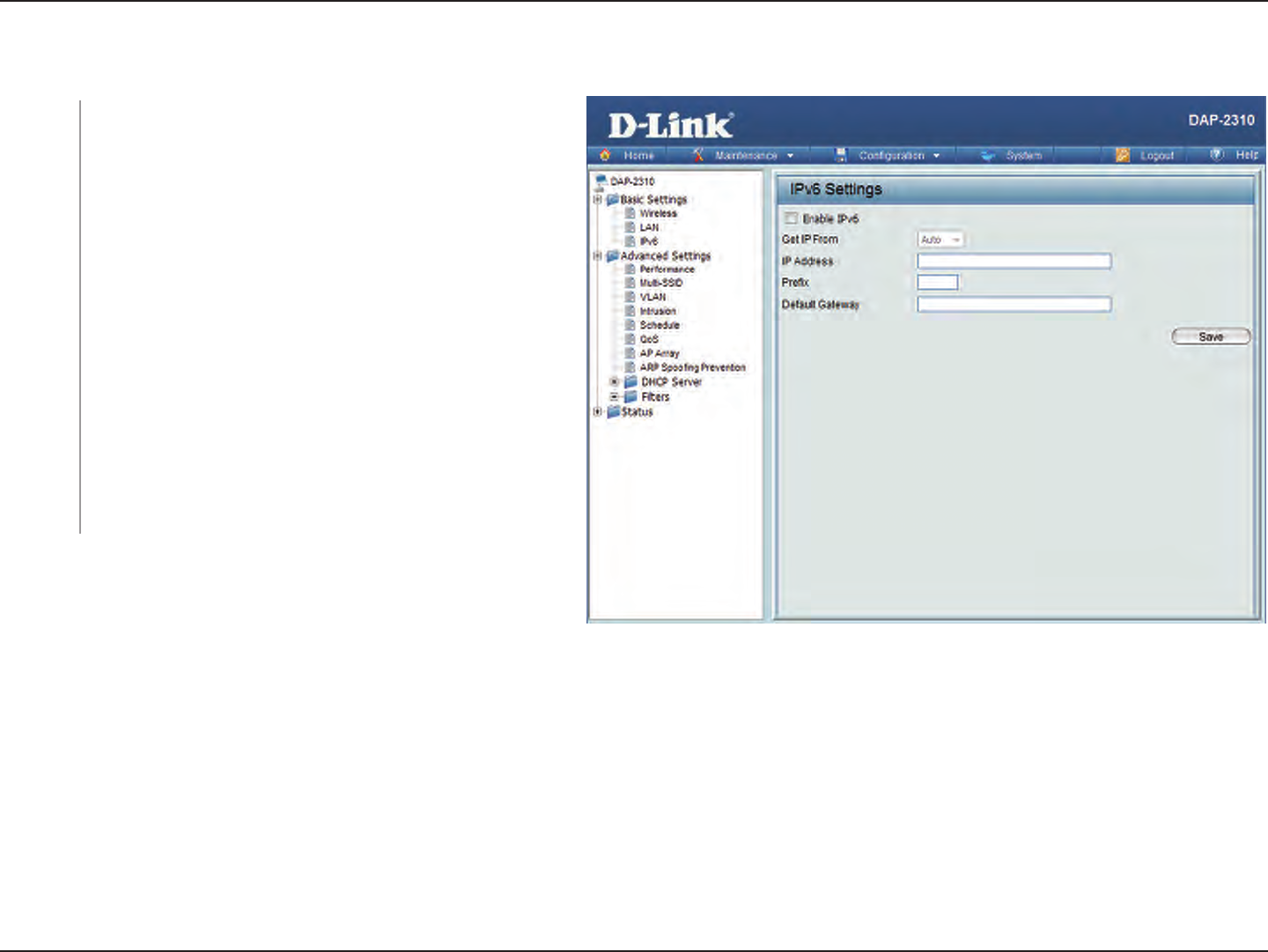
31D-Link DAP-2310 User Manual
Section 3 - Conguration
Check to enable the IPv6.
Auto is chosen here. Choose this option the
DAP-2310 can get IPv6 address automatically
or use Static to set IPv6 address manually.
DAP-2310. When Auto is selected, the other elds here
will be grayed out.
Enter the LAN IPv6 address used here.
Enter the LAN subnet prefix length value used
here.
Enter the LAN default gateway IPv6 address used
here.
Enable
IPv6:
Get IP
From:
IP Address:
Prex:
Default
Gateway:
IPv6
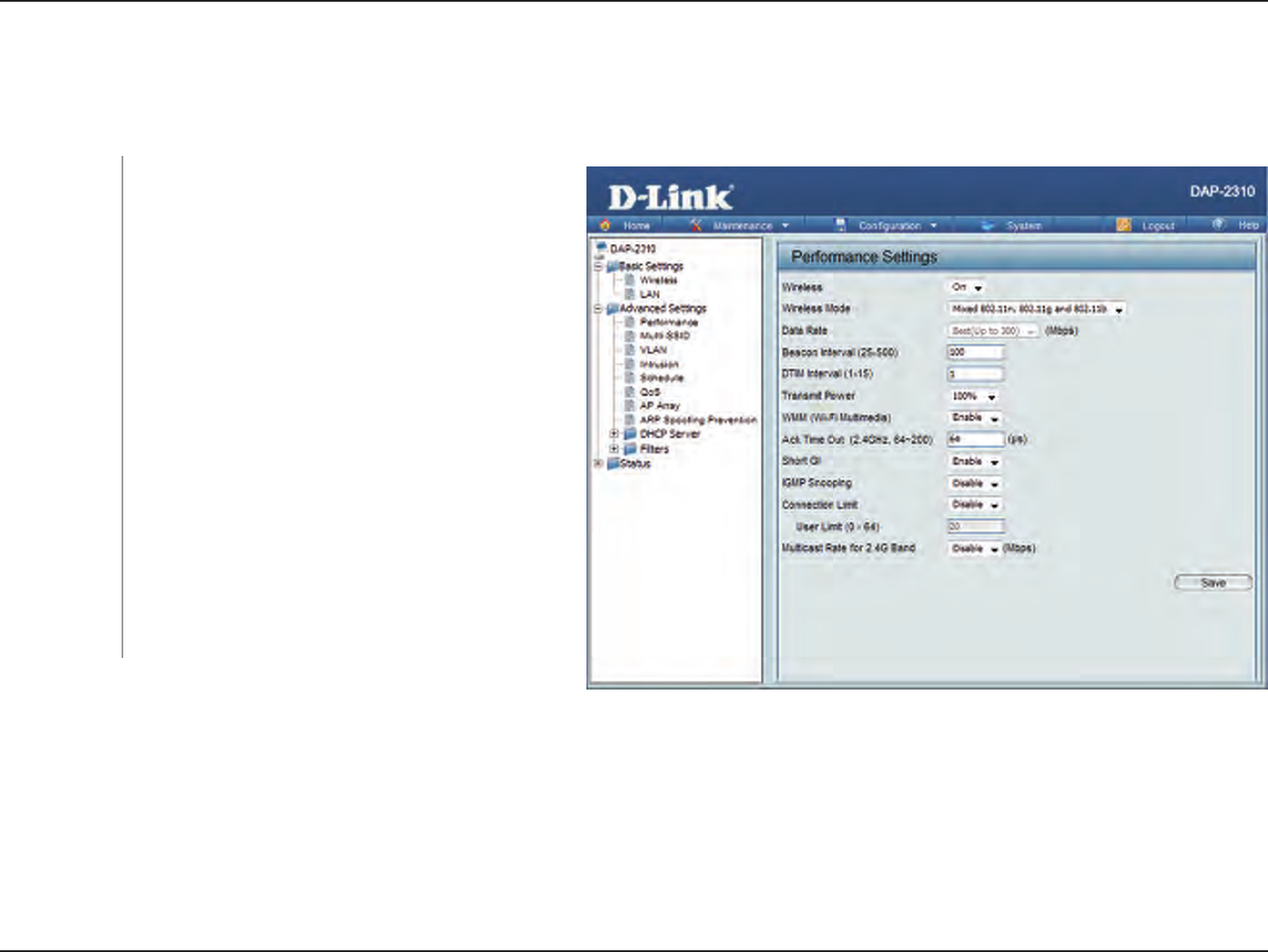
32D-Link DAP-2310 User Manual
Section 3 - Conguration
Advanced Settings
Performance
*Maximum wireless signal rate derived from IEEE Standard 802.11n and 802.11g specications. Actual data throughput may vary. Network conditions and environmental factors,
including volume of network trac, building materials and construction, and network overhead can lower actual data throughout rate.
Wireless:
Wireless Mode:
Data Rate*:
Use the drop-down menu to turn the wireless
function On or O.
The different combination of clients that can
be supported include Mixed 802.11n, 802.11g
and 802.11b, Mixed 802.11g and 802.11b
and 802.11n Only. Please note that when
backwards compatibility is enabled for legacy
(802.11g/b) clients, degradation of 802.11n
wireless performance is expected.
Indicate the base transfer rate of wireless adapters
on the wireless LAN. The AP will adjust the base
transfer rate depending on the base rate of
the connected device. If there are obstacles or
interference, the AP will step down the rate. This
option is enabled in Mixed 802.11g and 802.11b
mode. The choices available are Best (Up to 54),
54, 48, 36, 24, 18, 12, 9, 6, 11, 5.5, 2 or 1.

33D-Link DAP-2310 User Manual
Section 3 - Conguration
Beacons are packets sent by an access point to synchronize a wireless network. Specify a value in milliseconds. The default (100)
is recommended. Setting a higher beacon interval can help to save the power of wireless clients, while setting a lower one can
help a wireless client connect to an access point faster.
Select a Delivery Trac Indication Message setting between 1 and 15. The default value is 1. DTIM is a countdown informing
clients of the next window for listening to broadcast and multicast messages.
This setting determines the power level of the wireless transmission. Transmitting power can be adjusted to eliminate
overlapping of wireless area coverage between two access points where interference is a major concern. For example, if wireless
coverage is intended for half of the area, then select 50% as the option. Use the drop-down menu to select 100%, 50%, 25%, or
12.5%.
WMM stands for Wi-Fi Multimedia. Enabling this feature will improve the user experience for audio and video applications over
a Wi-Fi network.
To eectively optimize throughput over long distance links, enter a value for Acknowledgement Time Out from 64 to 200
microseconds in the 2.4 GHz in the eld provided.
Select Enable or Disable. Enabling a short guard interval can increase throughput. However, be aware that it can also increase
the error rate in some installations due to increased sensitivity to radio-frequency installations.
Select Enable or Disable. Internet Group Management Protocol allows the AP to recognize IGMP queries and reports sent
between routers and an IGMP host (wireless STA). When IGMP snooping is enabled, the AP will forward multicast packets to an
IGMP host based on IGMP messages passing through the AP.
Select Enable or Disable. This is an option for load balancing. This determines whether to limit the number of users accessing
this device. The exact number is entered in the User Limit eld below. This feature allows the user to share the wireless network
trac and the client using multiple APs. If this function is enabled, when the number of users exceeds this value, the DAP-2310
will not allow clients to associate with the AP.
Set the maximum amount of users that are allowed access (0-64 users). To use this feature, the Connection Limit above must be
enabled. For most users, a limit of 10 is recommended. The default setting is 20.
Select the multicast rate for 2.4G band. The choices available are 130,117,78,65,58.5,54, 52,48, 39,36, 26,24, 19.5,18, 13,12, 9, 6.5,6,
11, 5.5, 2 or 1.
Beacon Interval (25-
500):
DTM Interval
(1-15):
Transmit Power:
WMM (Wi-Fi
Multimedia):
Ack Time Out
(2.4 GHZ, 64~200) :
Short GI:
IGMP Snooping:
Connection Limit:
User Limit (0-64):
Multicast Rate for
2.4G Band
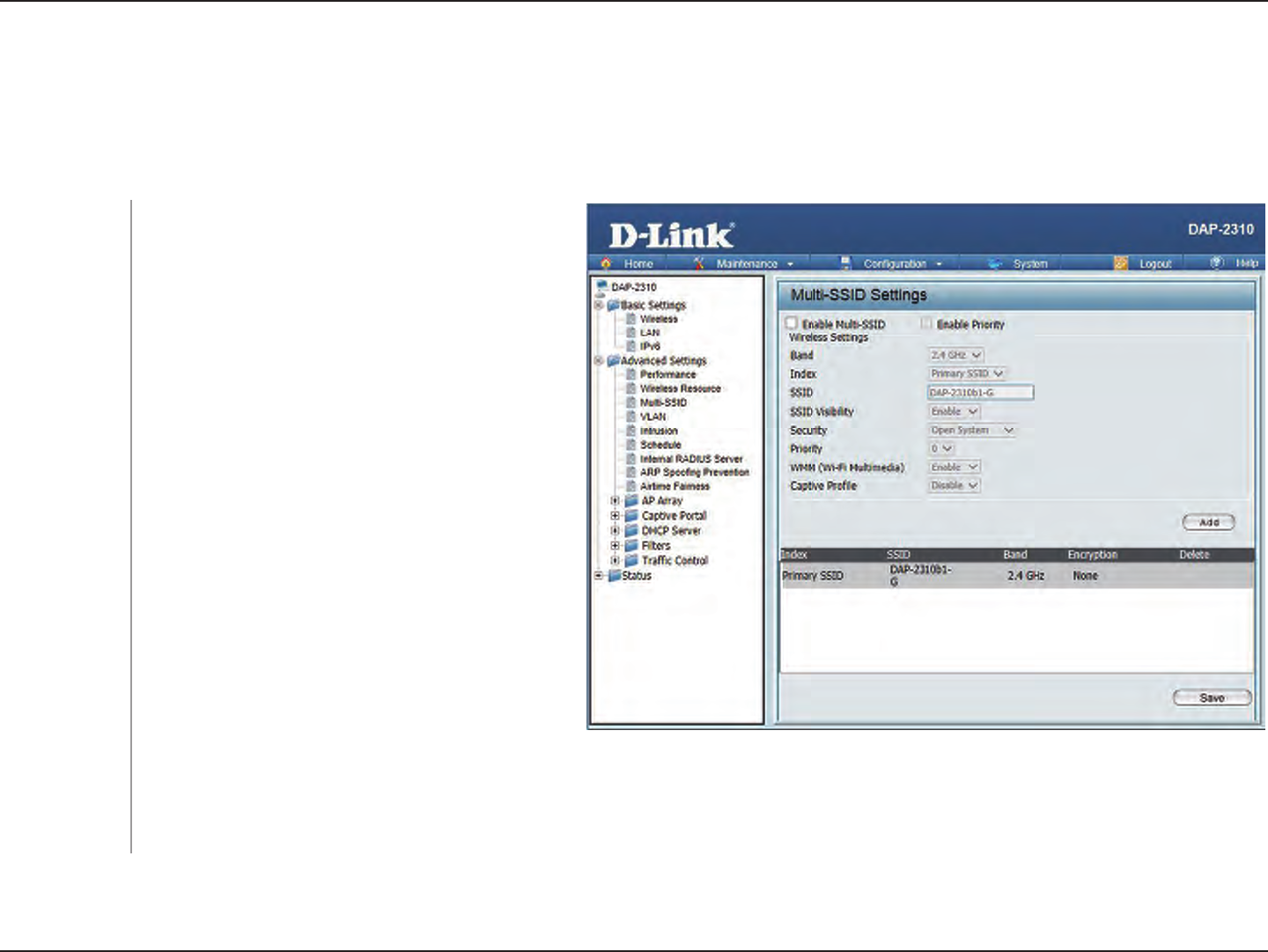
34D-Link DAP-2310 User Manual
Section 3 - Conguration
The device supports up to four multiple Service Set Identiers. In the Basic > Wireless section, you can set the Primary SSID.
The SSID’s factory default setting is dlink. The SSID can be easily changed to connect to an existing wireless network or to
establish a new wireless network.
Check to enable support for multiple SSIDs.
This read-only value is the current band setting.
You can select up to three multi-SSIDs. With
the Primary SSID, you have a total of four
multi-SSIDs.
Service Set Identifier (SSID) is the name
designated for a specific wireless local area
network (WLAN). The SSID’s factory default
setting is dlink. The SSID can be easily changed
to connect to an existing wireless network or to
establish a new wireless network.
Enable or Disable SSID visibility. Enabling this
feature broadcasts the SSID across the network,
thus making it visible to all network users.
The Multi-SSID security can be Open System, WPA-Personal, WPA-Enterprise, or 802.1x. For a detailed description of the Open
System parameters, please go to page 25. For a detailed description of the WPA-Personal parameters, please go to page 26.
For a detailed description of the WPA-Enterprise parameters, please go to page 27. For a detailed description of the O802.1x
parameters, please go to page 28.
Enable
Multi-SSID:
Band:
Index:
SSID:
SSID Visibility:
Security:
Multi-SSID

35D-Link DAP-2310 User Manual
Section 3 - Conguration
Check the Enable Priority box at the top of this window to enable. Select the priority from the drop-down menu.
Select Enable or Disable.
When you select Open System, toggle between Enable and Disable. If Enable is selected, the Key Type, Key Size, Key Index (1~4),
Key, and Conrm Keys must also be congured.
Select HEX or ASCII.
Select 64 Bits or 128 Bits.
Select from the 1st to 4th key to be set as the active key.
Input up to four keys for encryption. You will select one of these keys in the Key Index drop-down menu.
When you select either WPA-Personal or WPA-Enterprise, you must also choose a WPA mode from the drop-down menu: AUTO
(WPA or WPA2), WPA2 Only, or WPA Only. WPA and WPA2 use dierent algorithms. AUTO (WPA or WPA2) allows you to use both
WPA and WPA2. In addition, you must congure Cipher Type and Group Key Update Interval.
Select Auto, AES, or TKIP from the drop-down menu.
Select the interval during which the group key will be valid. The default value of 1800 seconds is recommended.
When you select WPA-Personal, please enter a PassPhrase in the corresponding eld.
When you select WPA-Personal, please re-enter the PassPhrase entered in the previous item in the corresponding eld.
When you select WPA-Enterprise, enter the IP address of the RADIUS server. In addition, you must congure RADIUS Port and
RADIUS Secret.
Enter the RADIUS port.
Enter the RADIUS secret.
Priority:
WMM (Wi-Fi
Multimedia):
Encryption:
Key Type:
Key Size:
Key Index (1-4):
Key:
WPA Mode:
Cipher Type:
Group Key
Update Interval:
PassPhrase:
Conrm
PassPhrase:
RADIUS Server:
RADIUS Port:
RADIUS Secret:
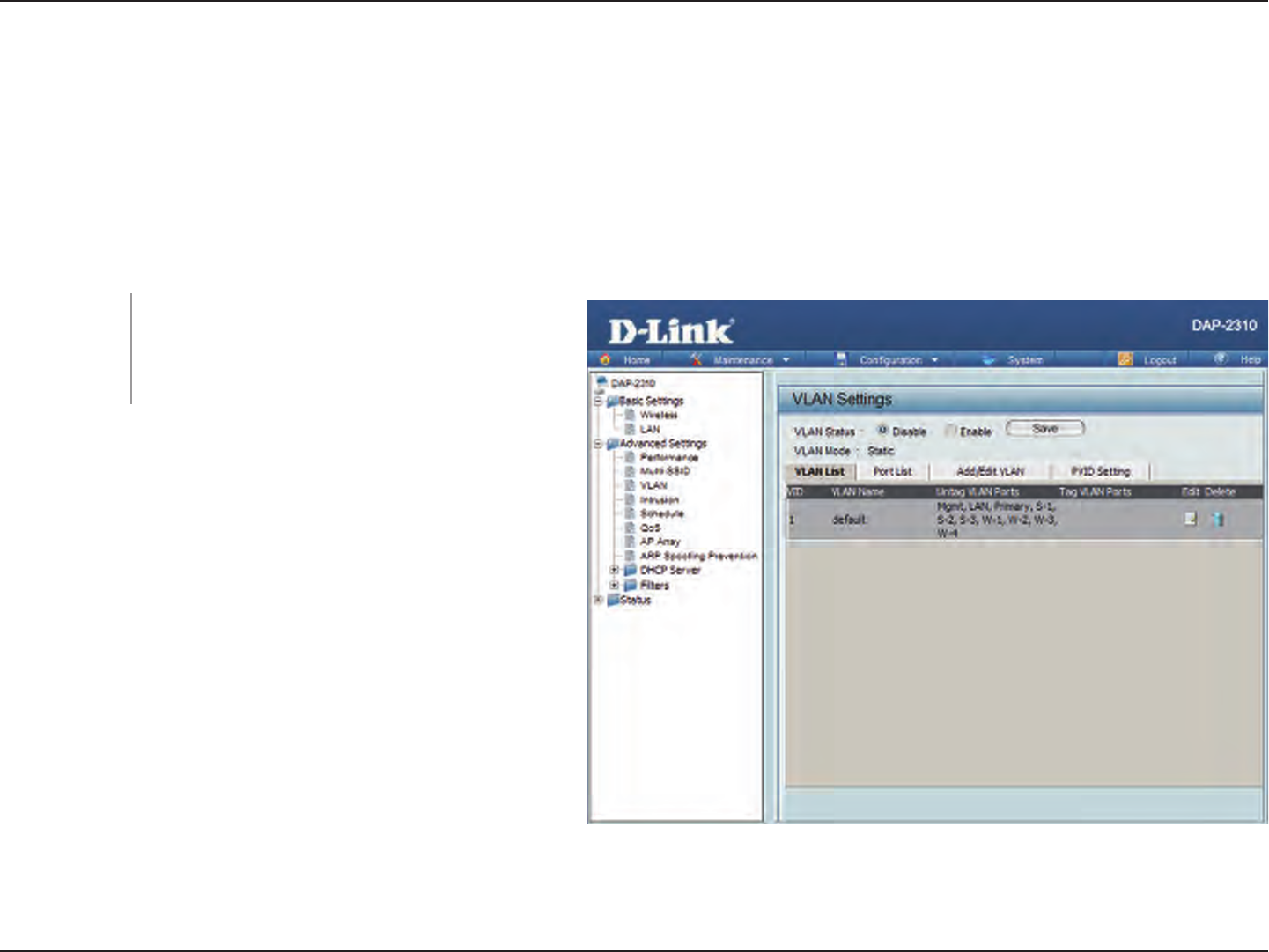
36D-Link DAP-2310 User Manual
Section 3 - Conguration
VLAN
VLAN List
The DAP-2310 supports VLANs. VLANs can be created with a Name and VID. Mgmt (TCP stack), LAN, Primary Multiple SSID, and
WDS connection can be assigned to VLANs as they are physical ports. Any packet which enters the DAP-2310 without a VLAN
tag will have a VLAN tag inserted with a PVID.
The VLAN List tab displays the current VLANs.
Use the radio button to toggle between Enable
or Disable. Next, go to the Add/Edit VLAN tab
to add or modify an item on the VLAN List tab.
VLAN Status:
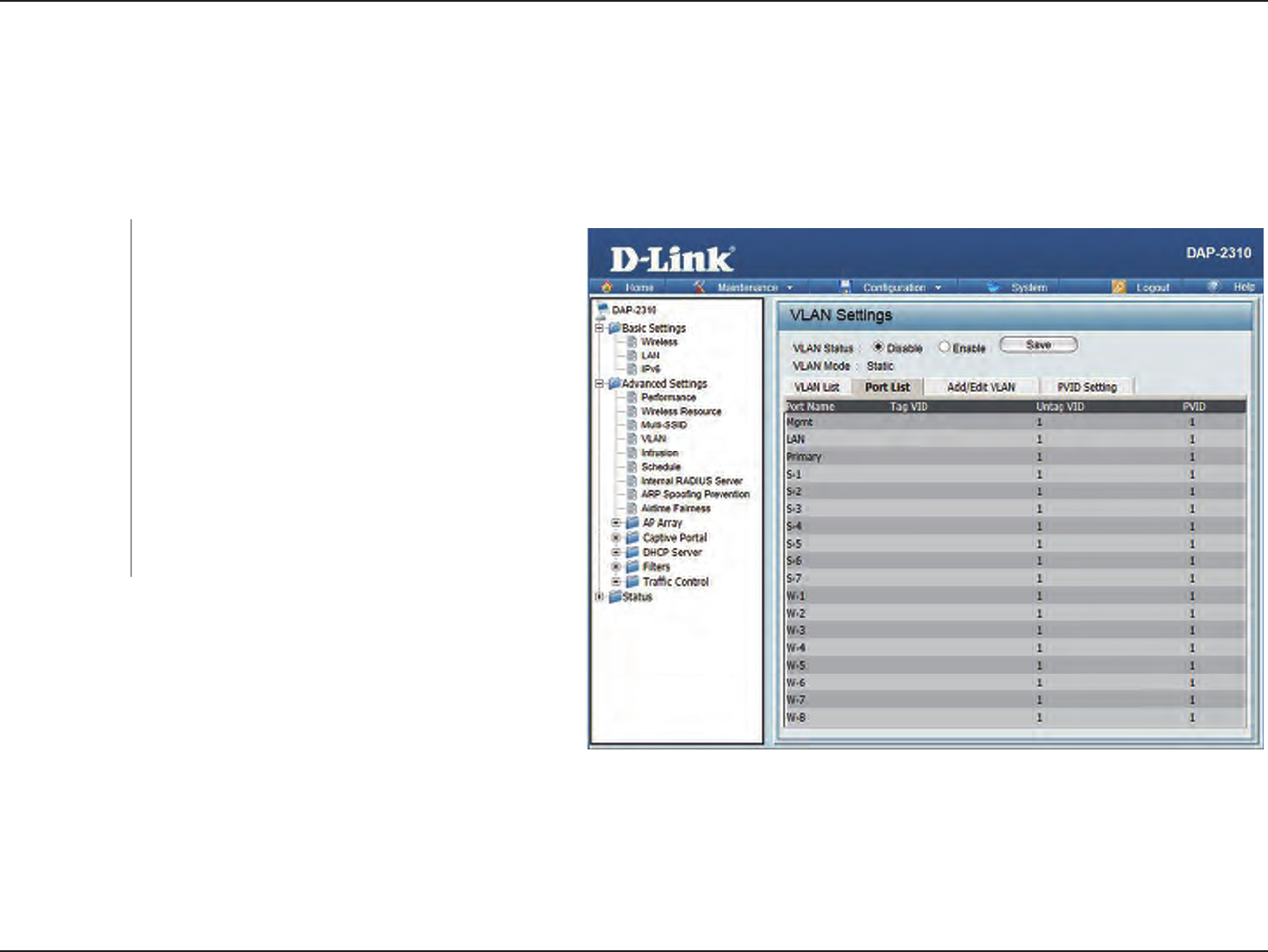
37D-Link DAP-2310 User Manual
Section 3 - Conguration
Port List
The Port List tab displays the current ports. If you want to congure the guest and internal networks on a Virtual LAN (VLAN),
the switch and DHCP server you are using must also support VLANs. As a prerequisite step, congure a port on the switch for
handling VLAN tagged packets as described in the IEEE 802.1Q standard.
Use the radio button to toggle to Enable. Next,
go to the Add/Edit VLAN tab to add or modify
an item on the VLAN List tab.
The name of the port is displayed in this column.
The Tagged VID is displayed in this column.
The Untagged VID is displayed in this column.
The Port VLAN Identifier is displayed in this
column.
VLAN Status:
Port Name:
Tag VID:
Untag VID:
PVID:
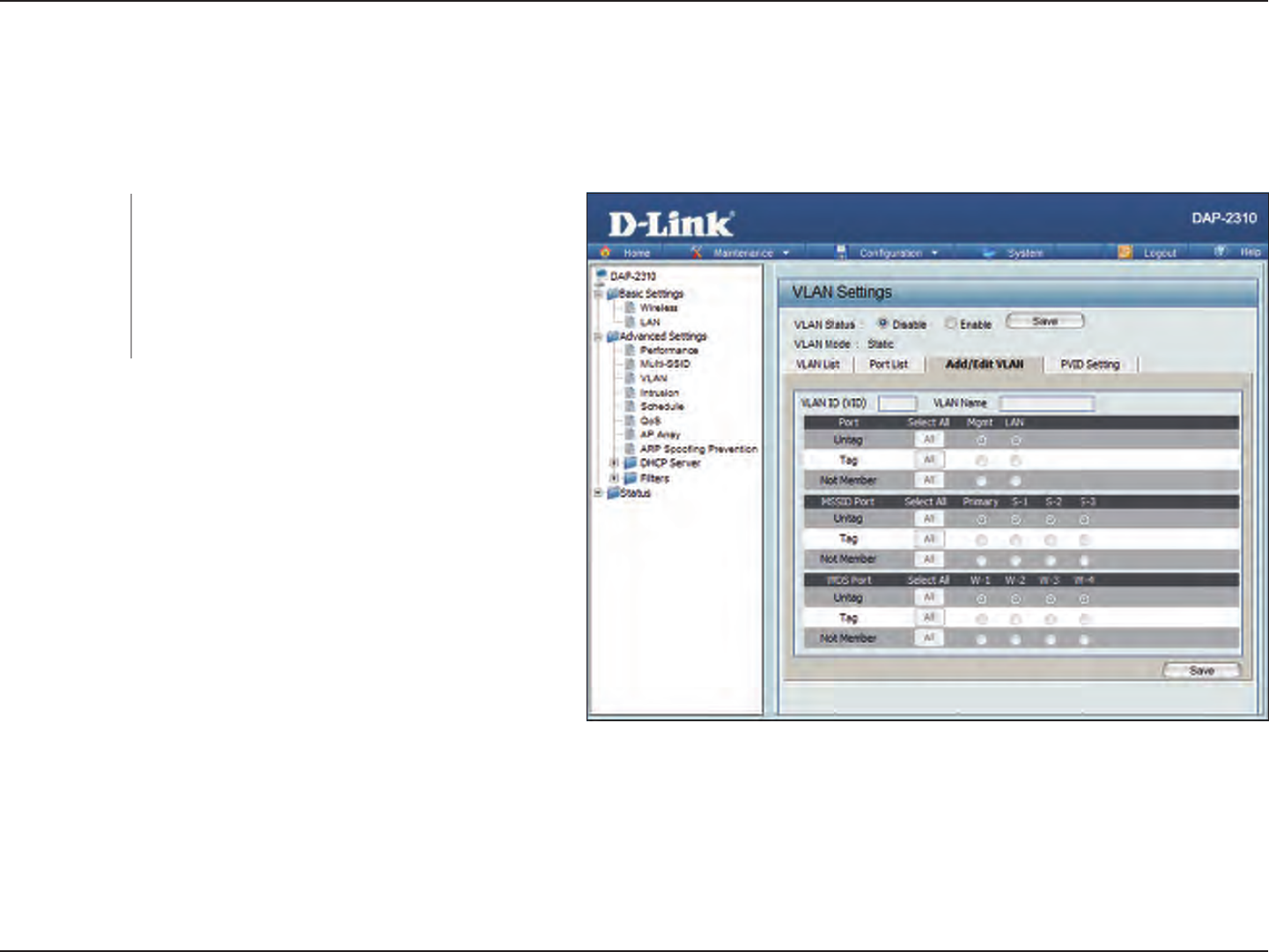
38D-Link DAP-2310 User Manual
Section 3 - Conguration
Add/Edit VLAN
The Add/Edit VLAN tab is used to congure VLANs. Once you have made the desired changes, click the Save button to let
your changes take eect.
Use the radio button to toggle to Enable.
Provide a number between 1 and 4094 for
the Internal VLAN.
Enter the VLAN to add or modify.
VLAN Status:
VLAN ID:
VLAN Name:
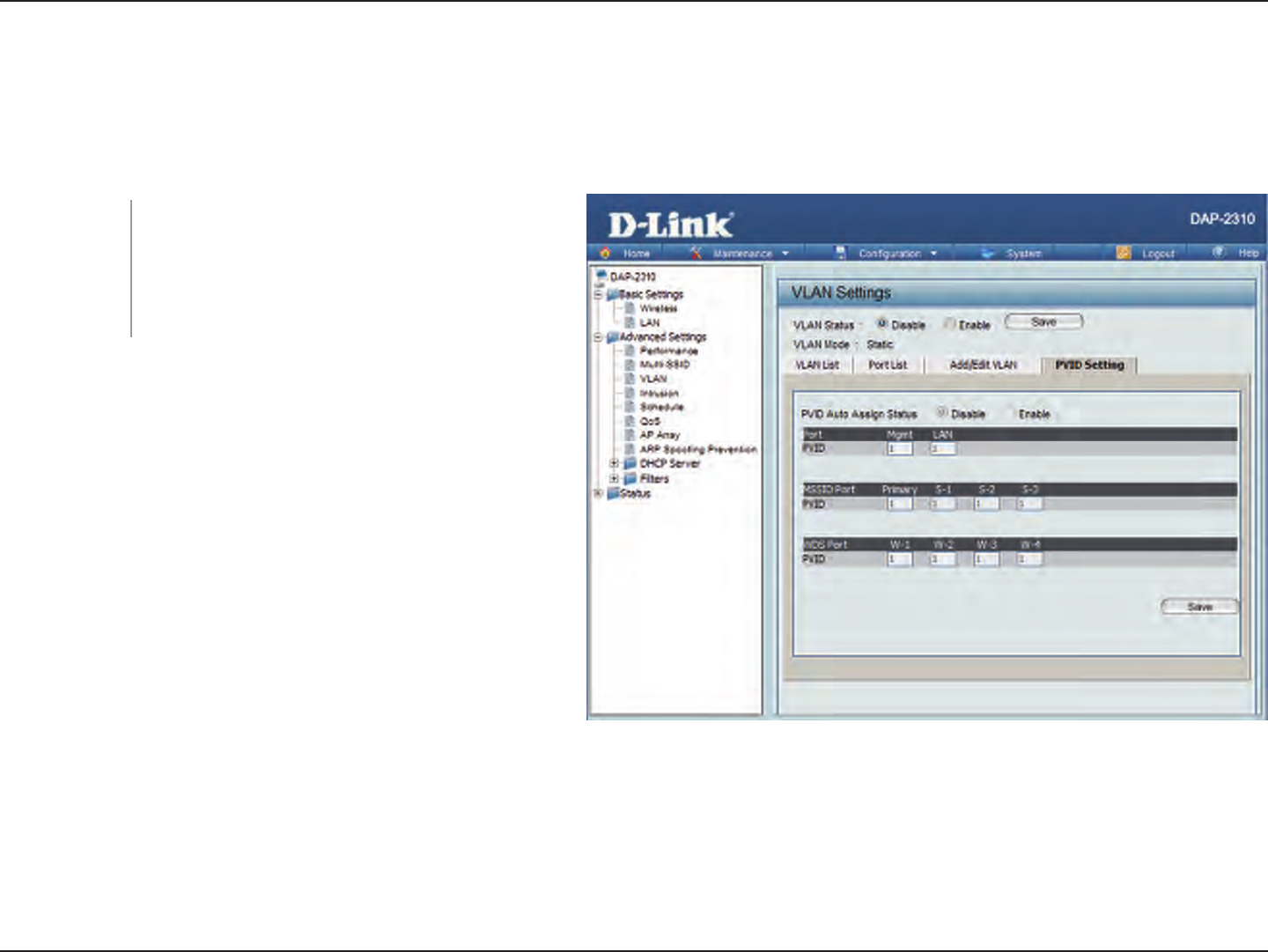
39D-Link DAP-2310 User Manual
Section 3 - Conguration
PVID Setting
The PVID Setting tab is used to enable/disable the Port VLAN Identier Auto Assign Status as well as to congure various types
of PVID settings. Click the Save button to let your changes take eect.
Use the radio button to toggle between Enable
and Disable.
Use the radio button to toggle PVID auto assign
status to Enable.
VLAN Status:
PVID Auto
Assign Status:
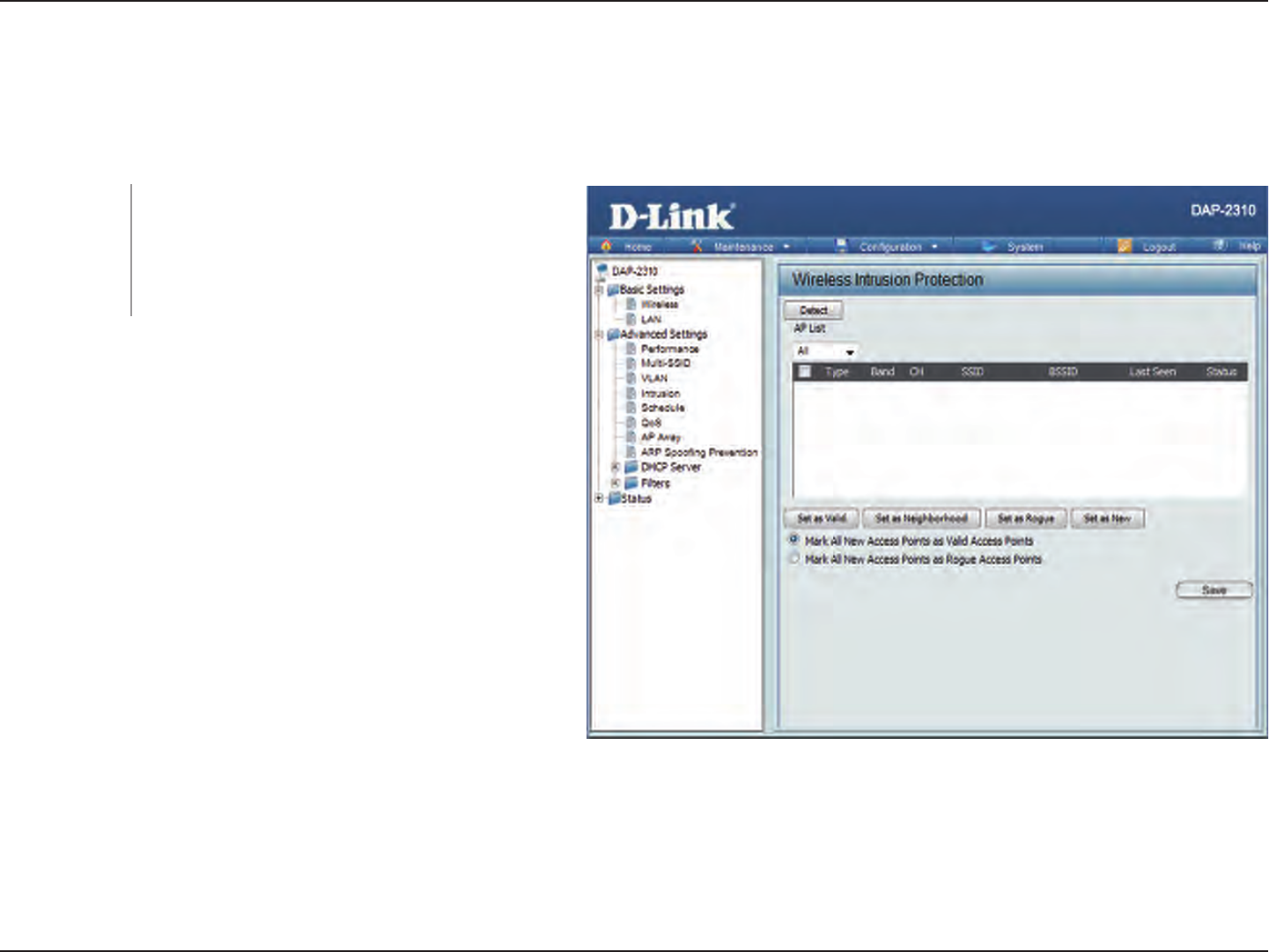
40D-Link DAP-2310 User Manual
Section 3 - Conguration
Intrusion
The Wireless Intrusion Protection window is used to set APs as All, Valid, Neighborhood, Rogue, and New. Click the Save
button to let your changes take eect.
The choices include All, Valid, Neighbor, Rogue,
and New.
Click this button to initiate a scan of the network.
AP List:
Detect:
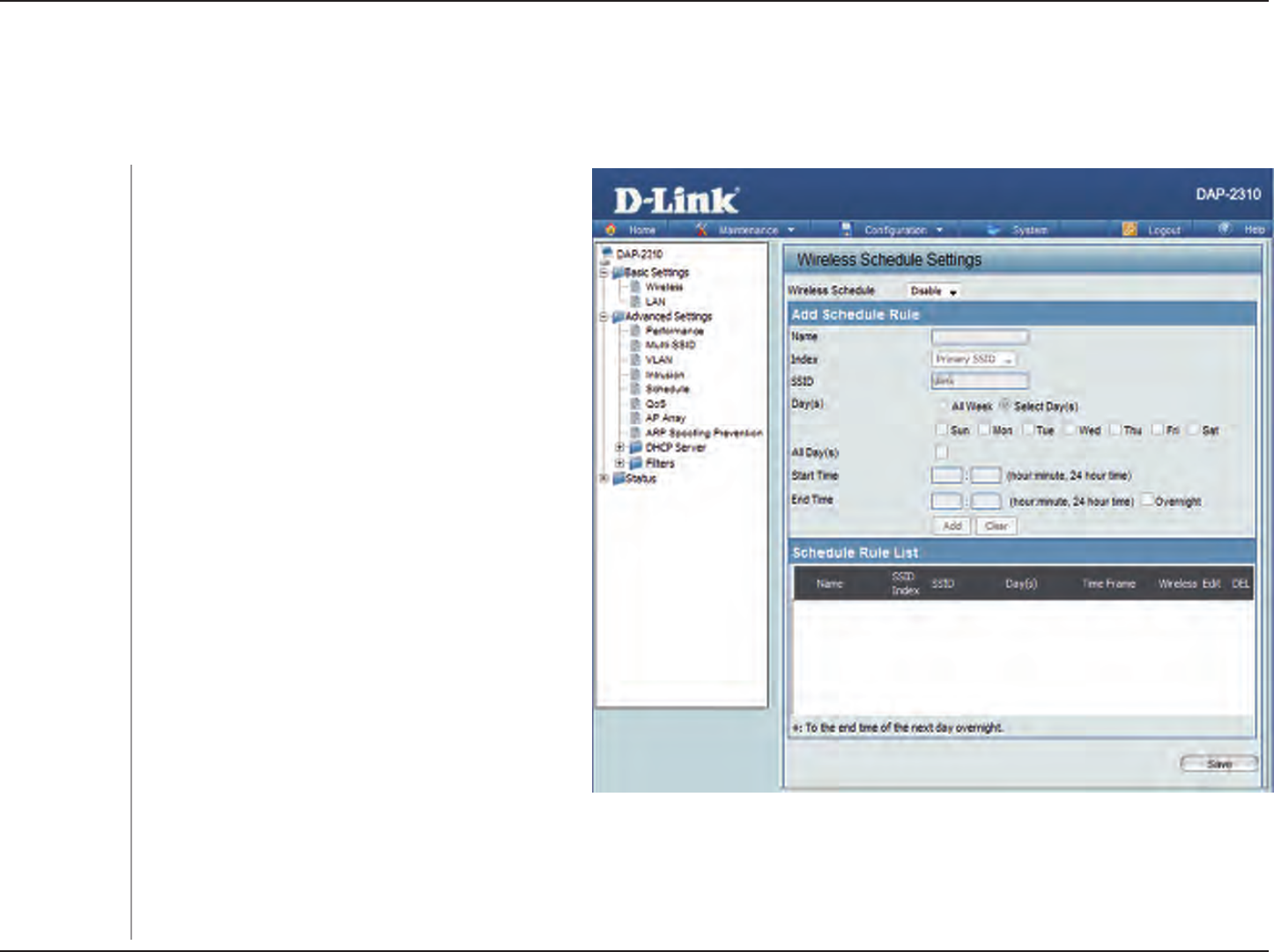
41D-Link DAP-2310 User Manual
Section 3 - Conguration
Schedule
The Wireless Schedule Settings window is used to add and modify scheduling rules on the device. Click the Save button to let
your changes take eect.
Use the drop-down menu to enable the device’s
scheduling feature.
Enter a name for the new scheduling rule in the
eld provided.
Select the index from the drop-down menu.
Enter the name of your wireless network (SSID).
Toggle the radio button between All Week and
Select Day(s). If the second option is selected,
check the specic days you want the rule to be
eective on.
Check this box to have your settings apply 24
hours a day.
Enter the start time for your rule. If you selected
All Day, this option will be greyed out.
Enter the end time for your rule.
Click to add the rule to the list.
This section will display the list of created
schedules.
Click the Save button to save your created rules.
Wireless
Schedule:
Name:
Index:
SSID:
Day(s):
All Day(s):
Start Time:
End Time:
Add:
Schedule Rule
List:
Save:
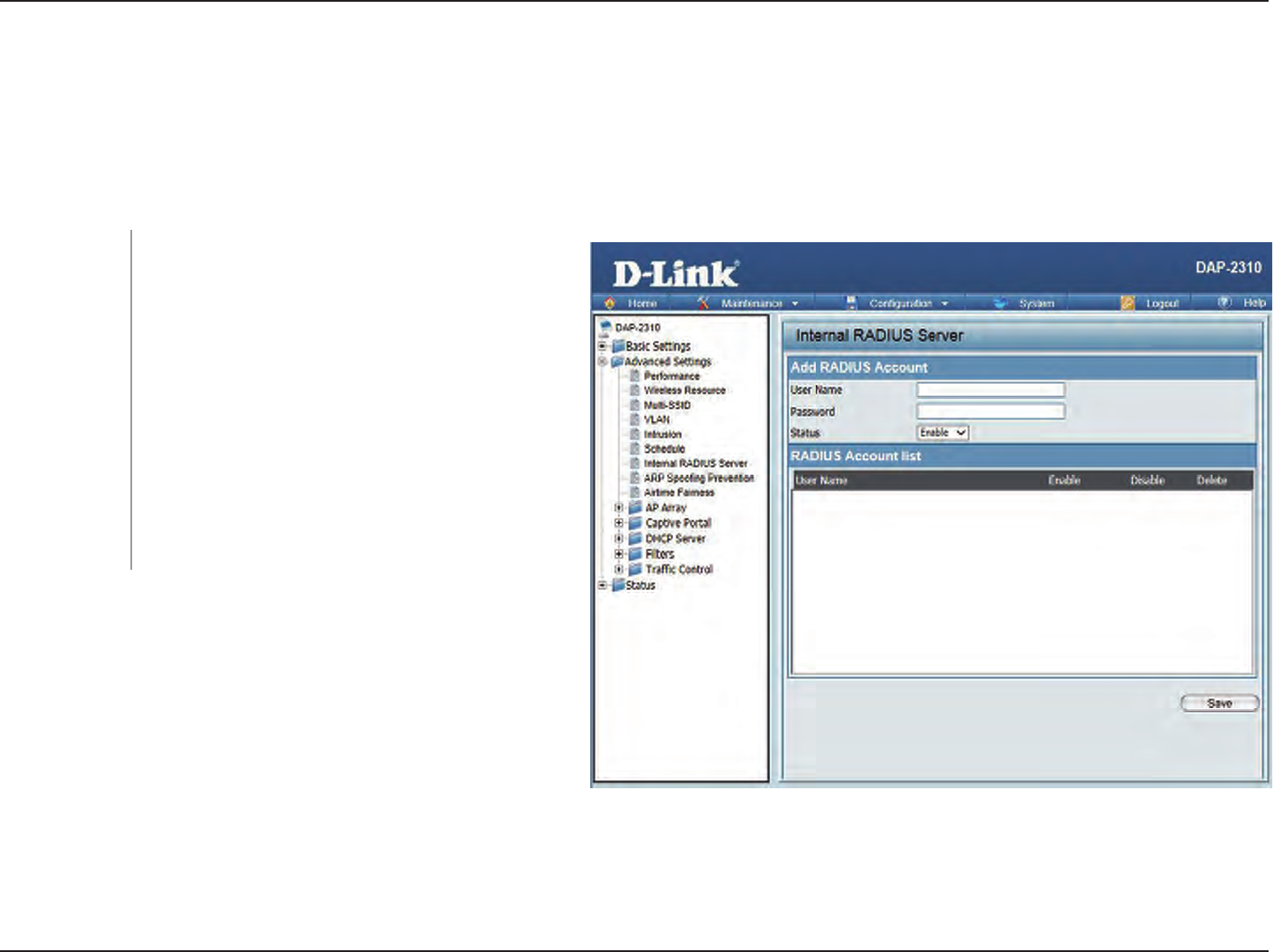
42D-Link DAP-2310 User Manual
Section 3 - Conguration
Internal RADIUS Server
The DAP-2310 features a built-in RADIUS server. Once you have nished adding a RADIUS account, click the Save button to let
your changes take eect. The newly-created account will appear in this RADIUS Account List. The radio buttons allow the user
to enable or disable the RADIUS account. Click the icon in the delete column to remove the RADIUS account. We suggest you
limit the number of accounts below 30.
Enter a name to authenticate user access to the
internal RADIUS server.
Enter a password to authenticate user access to
the internal RADIUS server. The length of your
password should be 8~64.
Toggle the drop-down menu between Enable
and Disable.
Displays the list of users.
User Name:
Password:
Status:
RADIUS
Account List:
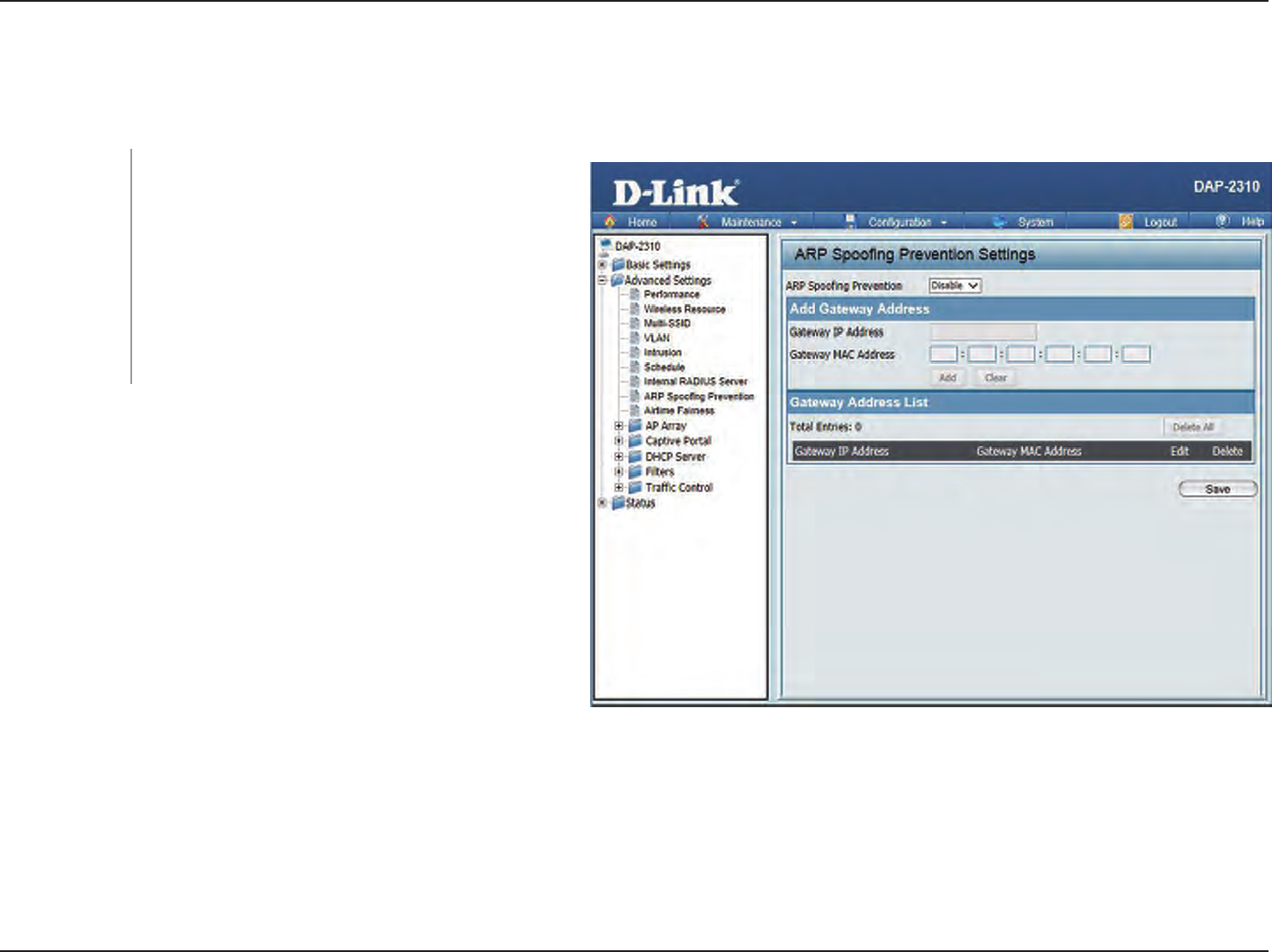
43D-Link DAP-2310 User Manual
Section 3 - Conguration
ARP Spoong Prevention Settings
The ARP Spoong Prevention feature allows users to add IP/MAC address mapping to prevent arp spoong attack.
This check box allows you to enable the arp
spoong prevention function.
Enter a gateway IP address.
Enter a gateway MAC address.
ARP Spoong
Prevention:
Gateway IP
Address:
Gateway MAC
Address:
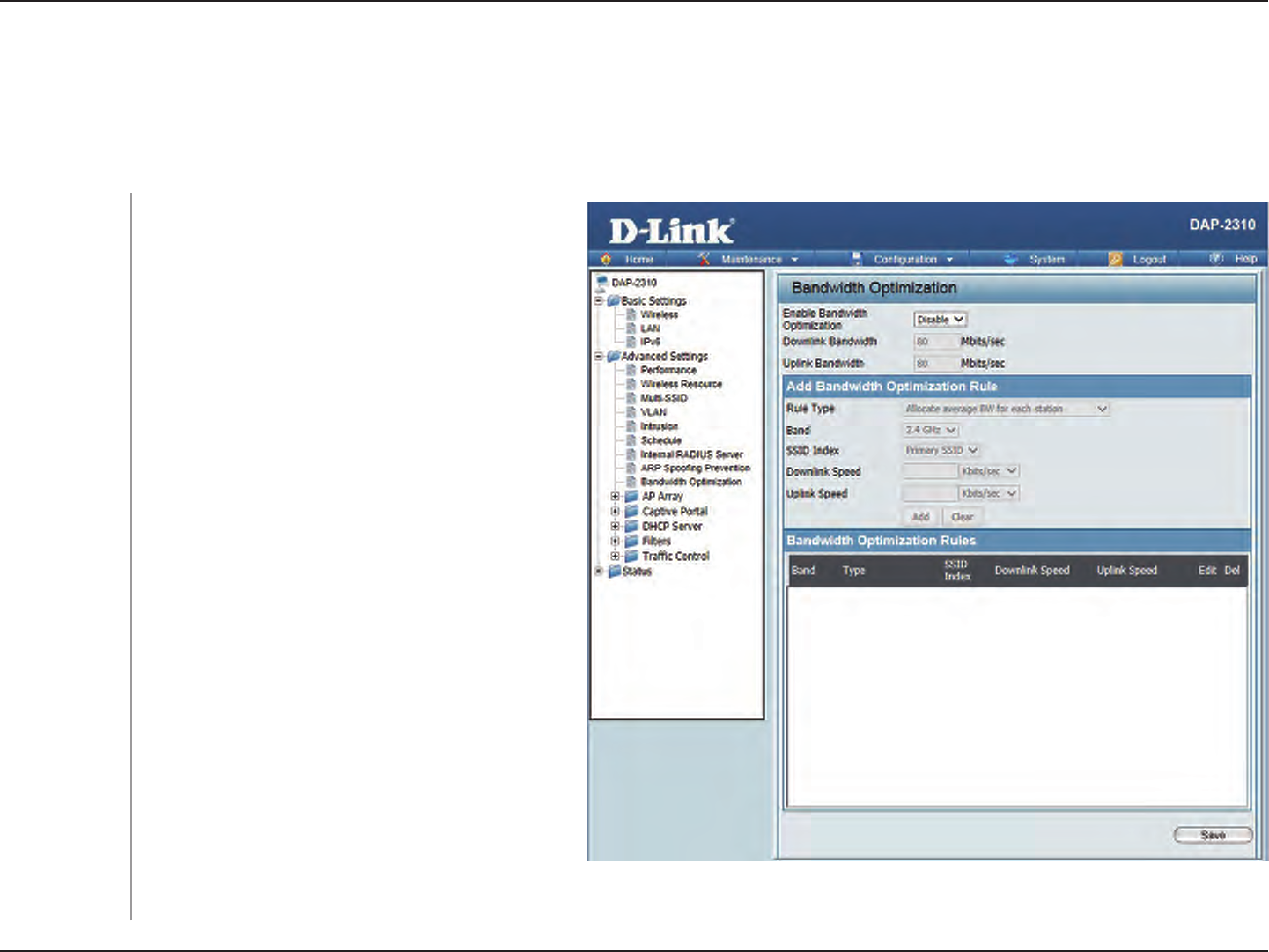
44D-Link DAP-2310 User Manual
Section 3 - Conguration
Bandwidth Optimization
The Bandwidth Optimization window allows the user to manage the bandwidth of the device and arrange the bandwidth for
various wireless clients. When the Bandwidth Optimization ruile is nished, click the Add button. To discard the Add Bandwidth
Optimization Rule settings, click the Clear button. Click the Save button to let your changes take eect.
Use the drop-down menu to Enable the
Bandwidth Optimization function.
Enter the downlink bandwidth of the device in
Mbits per second.
Enter the uplink bandwidth of the device in
Mbits per second.
Use the drop-down menu to select the type
that is applied to the rule. Available options are:
Allocate average BW for each station, Allocate
maximum BW for each station, Allocate dierent
BW for 1a/b/g/n stations, and Allocte specic
BW for SSID.
AP will distribute average bandwidth for each
client.
Specify the maximum bandwidth for each
connected client. Reserve certain bandwidth
for future clients.
The weight of 11b/g/n and 11a/n client are
10%/20%/70% ; 20%/80%. AP will distribute
dierent bandwidth for 11a/b/g/n clients.
Enable
Bandwidth
Optimization:
Downlink
Bandwidth:
Uplink
Bandwidth:
Rule Type:
Allocate
average BW for
each station:
Allocate
maximum BW
for each station:
Allocate
dierent BW
for a/b/g/n
stations:
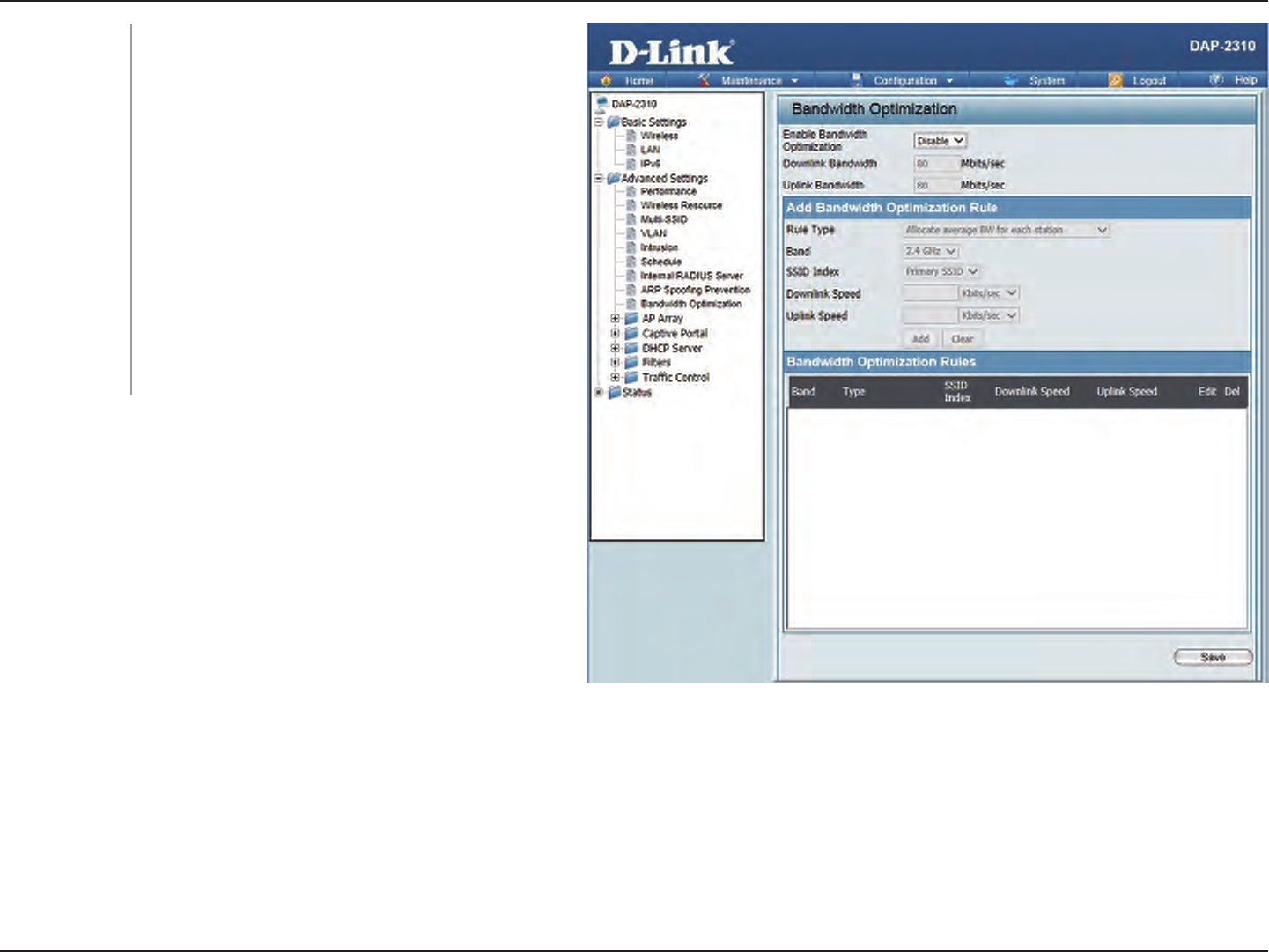
45D-Link DAP-2310 User Manual
Section 3 - Conguration
Allocate specic
BW for SSID:
Band:
SSID Index:
Downlink
Speed:
Uplink Speed:
All clients share the total bandwidth.
Use the drop-down menu to toggle the wireless
band between 2.4GHz and 5GHz.
Use the drop-down menu to select the SSID for
the specied wireless band.
Enter the limitation of the downloading speed in
either Kbits/sec or Mbits/sec for the rule.
Enter the limitation of the uploading speed in
either Kbits/sec or Mbits/sec for the rule.
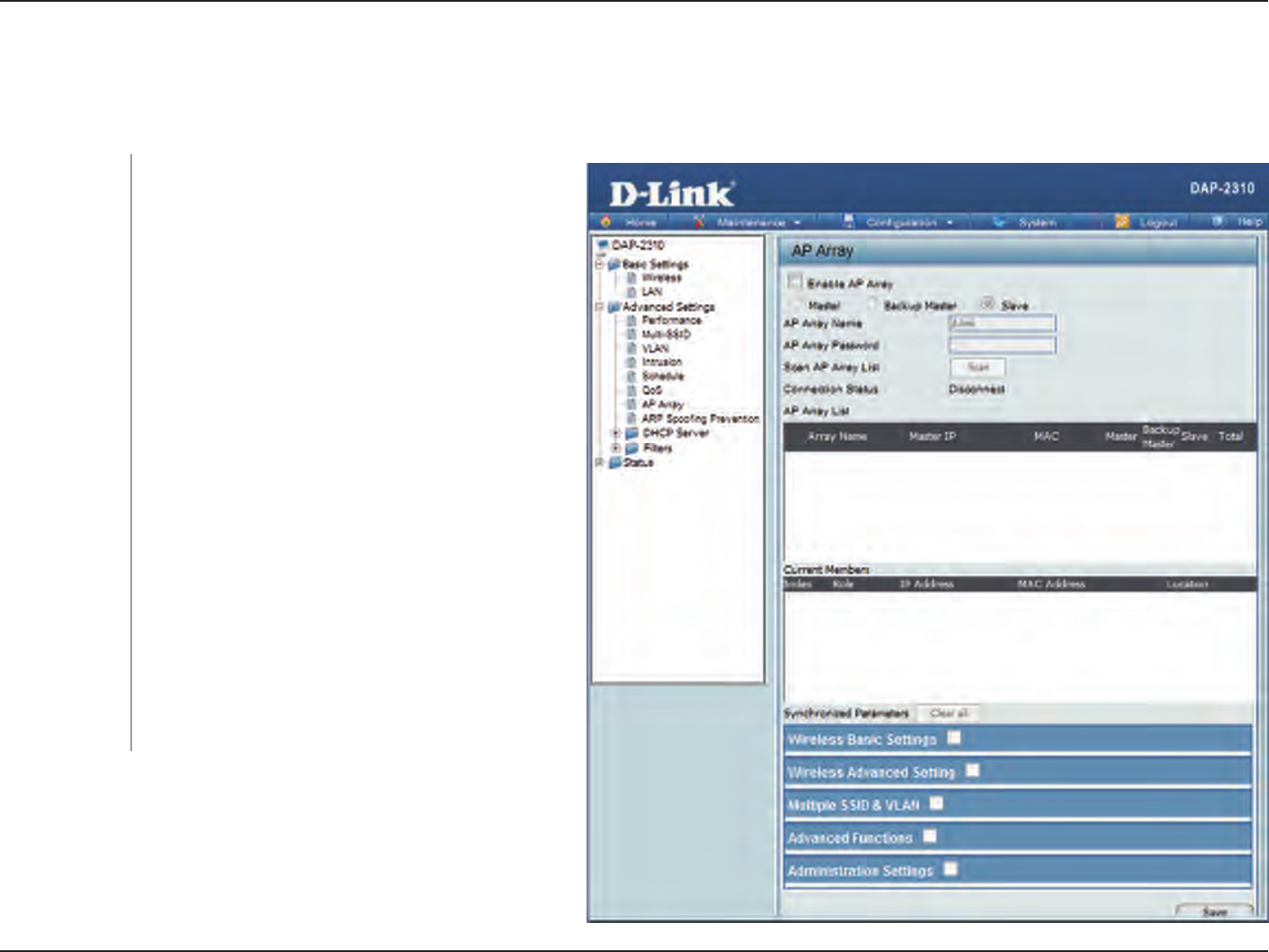
46D-Link DAP-2310 User Manual
Section 3 - Conguration
AP Array
An AP array is a set of devices on a network that are organized into a single group to increase ease of management.
This check box allows the user to enable the AP
array function. The three modes that are available
are Master, Backup Master, and Slave. APs in the
same array will use the same conguration. The
conguration will sync the Master AP to the Slave
AP and the Backup Master AP when a Slave AP
and a Backup Master AP join the AP array.
Enter a name for the AP array you have created.
Enter a password that will be used to access the
AP array you have created.
Click this button to initiate a scan of all the
available APs currently on the network.
This table displays the current AP array status for
the following parameters: Array Name, Master
IP, MAC, Master, Backup Master, Slave, and Total.
This table displays all the current array members.
The DAP-2310 AP array feature supports up to
eight AP array members.
Enable Array:
AP Array Name:
AP Array
Password:
Scan AP Array
List:
AP Array List:
Current Array
Members:
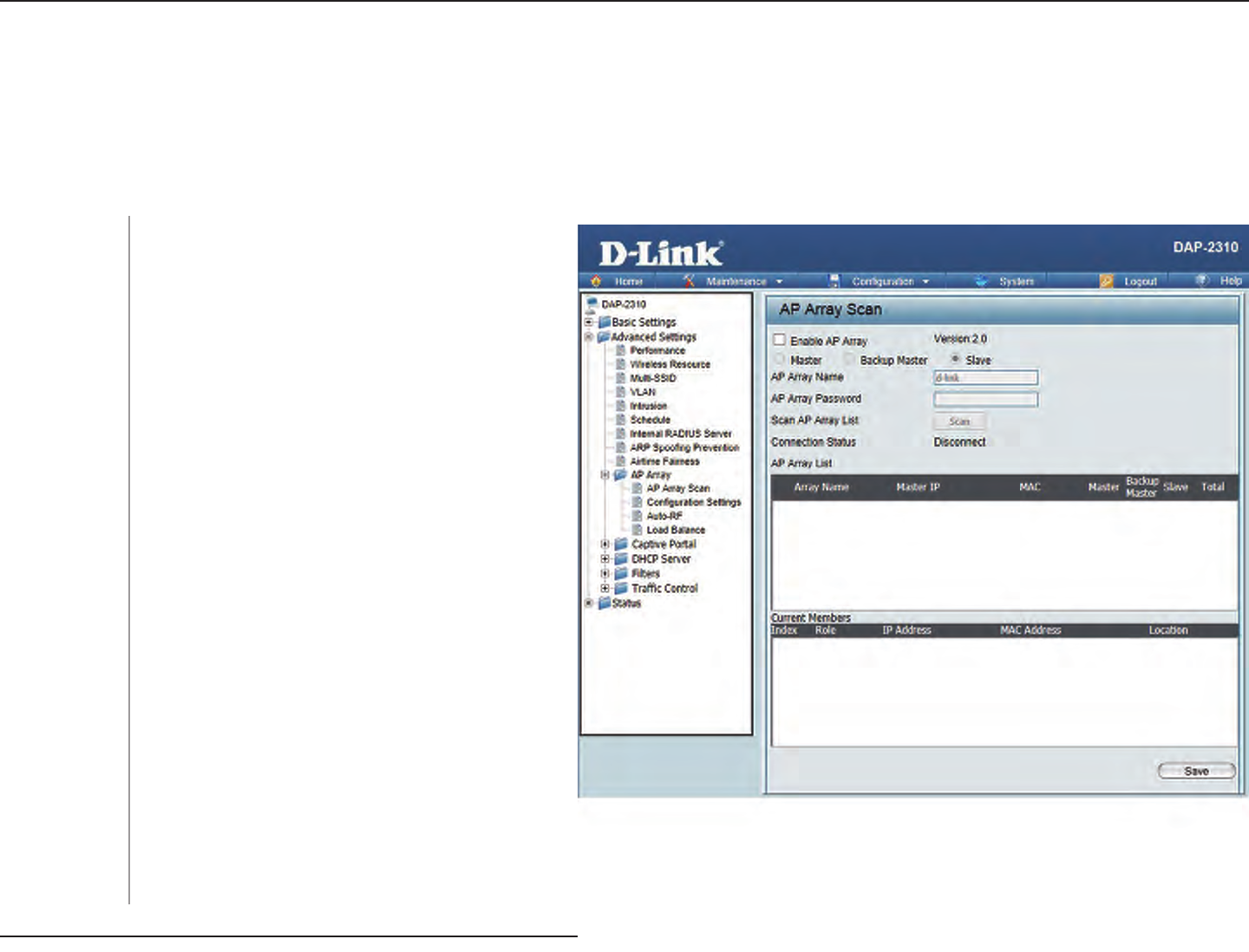
47D-Link DAP-2310 User Manual
Section 3 - Conguration
AP Array Scan
The AP Array window is used to create up to 32 APs on a local network to be organized into a single group in order to increase
ease of management. Click the Save button to let your changes take eect. Central WiFiManager and AP Array are mutually
exclusive functions.
Select the check box to enable the AP array
function. The three modes that are available
are Master, Backup Master, and Slave. APs in the
same array will use the same conguration. The
conguration will sync the Master AP to the Slave
AP and the Backup Master AP when a Slave AP
and a Backup Master AP join the AP array.
Enter an AP array name for the group here.
Enter an AP array password for the group here.
This password must be the same on all the APs
in the group.
Click this button to initiate a scan of all the
available APs currently on the network.
Display the AP array connection status.
This table displays the current AP array status for
the following parameters: Array Name, Master
IP, MAC, Master, Backup Master, Slave, and Total.
This table displays all the current array members.
The DAP-2660 AP array feature supports up to
eight AP array members.
Enable AP
Array:
AP Array Name:
AP Array
Password:
Scan AP Array
List:
Connection
Status:
AP Array List:
Current
Members:
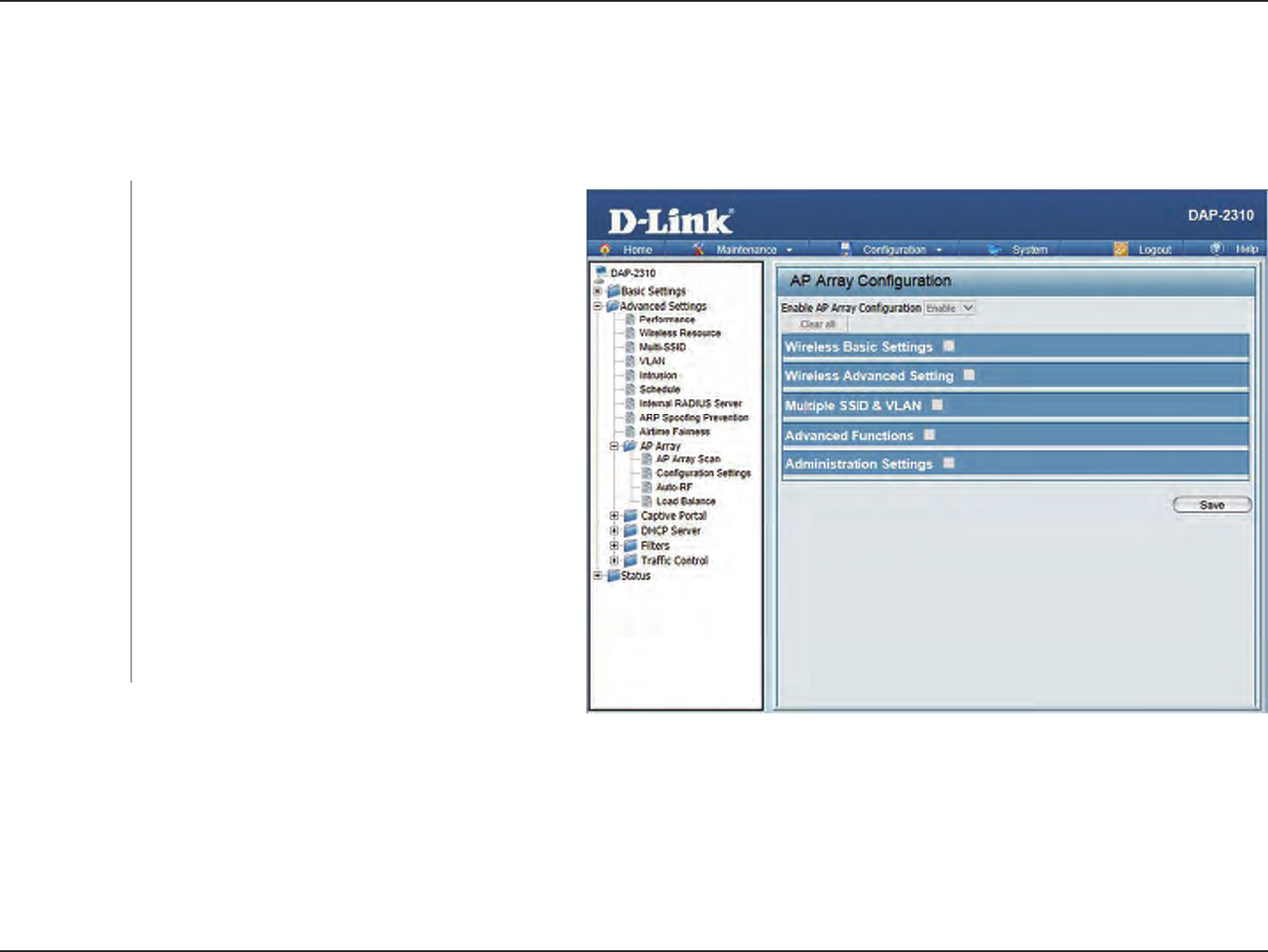
48D-Link DAP-2310 User Manual
Section 3 - Conguration
Conguration Settings
In the AP array conguration settings windows, users can specify which settings all the APs in the group will inherit from the
master AP. Make the required selection in this window and click the Save button to accept the changes made.
Select to Enable or Disable the AP array congure
feature here.
Select this option to specify the basic wireless
settings that the APs in the group will inherit.
Select this option to specify the advanced
wireless settings that the APs in the group will
inherit.
Select this option to specify the multiple SSIDs
and VLAN settings that the APs in the group will
inherit.
Select this option to specify the other advanced
settings that the APs in the group will inherit.
Select this option to specify the administrative
settings that the APs in the group will inherit.
Enable AP Array
Conguration:
Wireless Basic
Settings:
Wireless
Advanced
Settings:
Multiple SSID &
VLAN:
Advanced
Functions:
Administration
Settings:
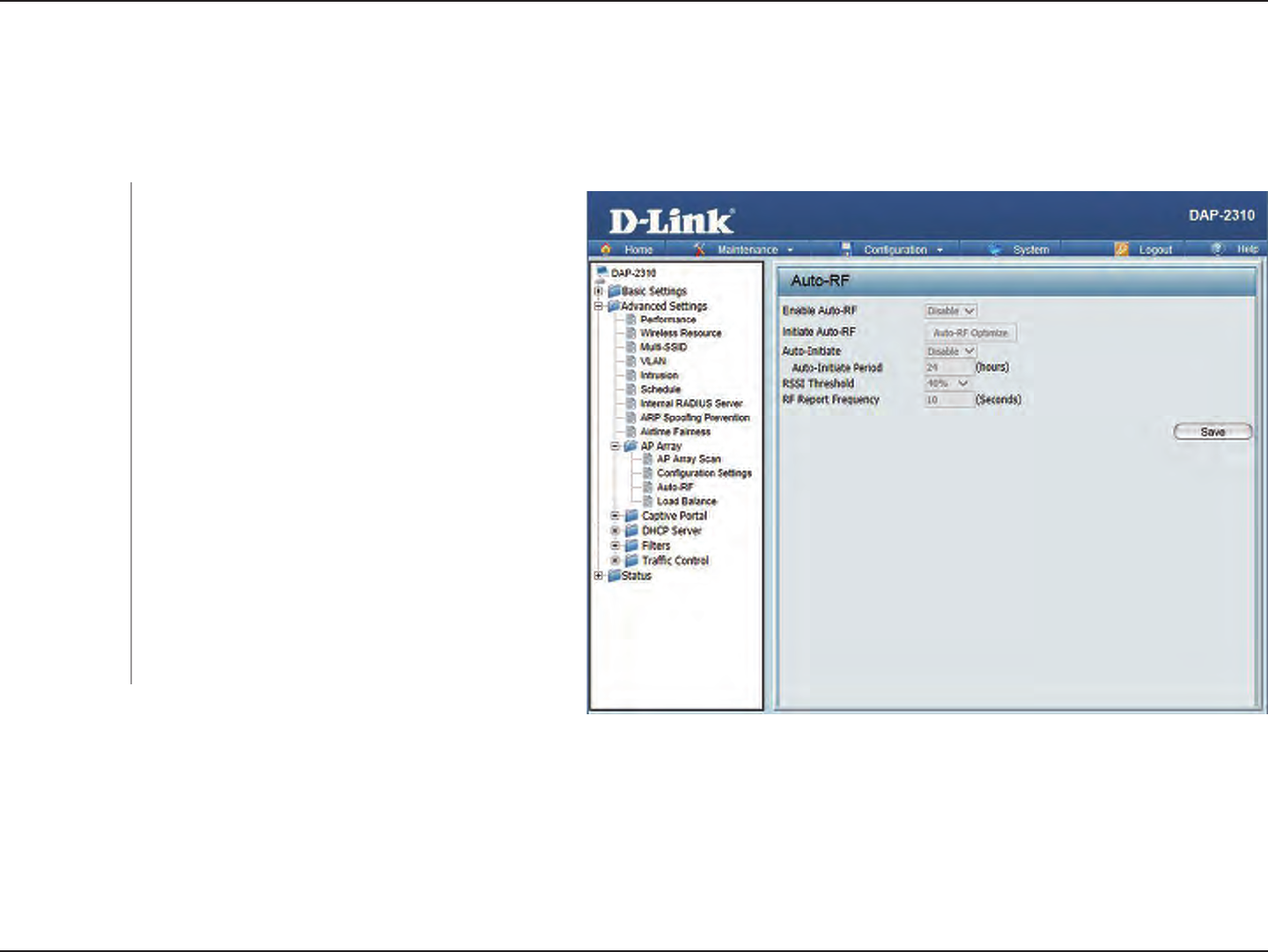
49D-Link DAP-2310 User Manual
Section 3 - Conguration
Auto-RF
In this windows, users can view and congure the automatic radio frequency settings as well as congure the the auto-initiate
period and threshold values. Click the Save button to accept the changes made.
Select to Enable or Disable the auto-RF feature
here.
Click the Auto-RF Optimize button to initiate
the auto-RF optimization feature.
Select the Enable or Disable the auto-initiate
feature here.
After enabling the auto-initiate option, the
auto-initiate period value can be entered here.
This value must be between 1 and 24 hours.
Select the RSSI threshold value here. This value
is listed in the drop-down menu in increments
of 10% from 10% to 100%.
Enter the RF report frequency value here.
Enable: Auto-
RF:
Initiate Auto-RF:
Auto-Initiate:
Auto-Initiate
Period:
RSSI Threshold:
RF Report
Frequency:
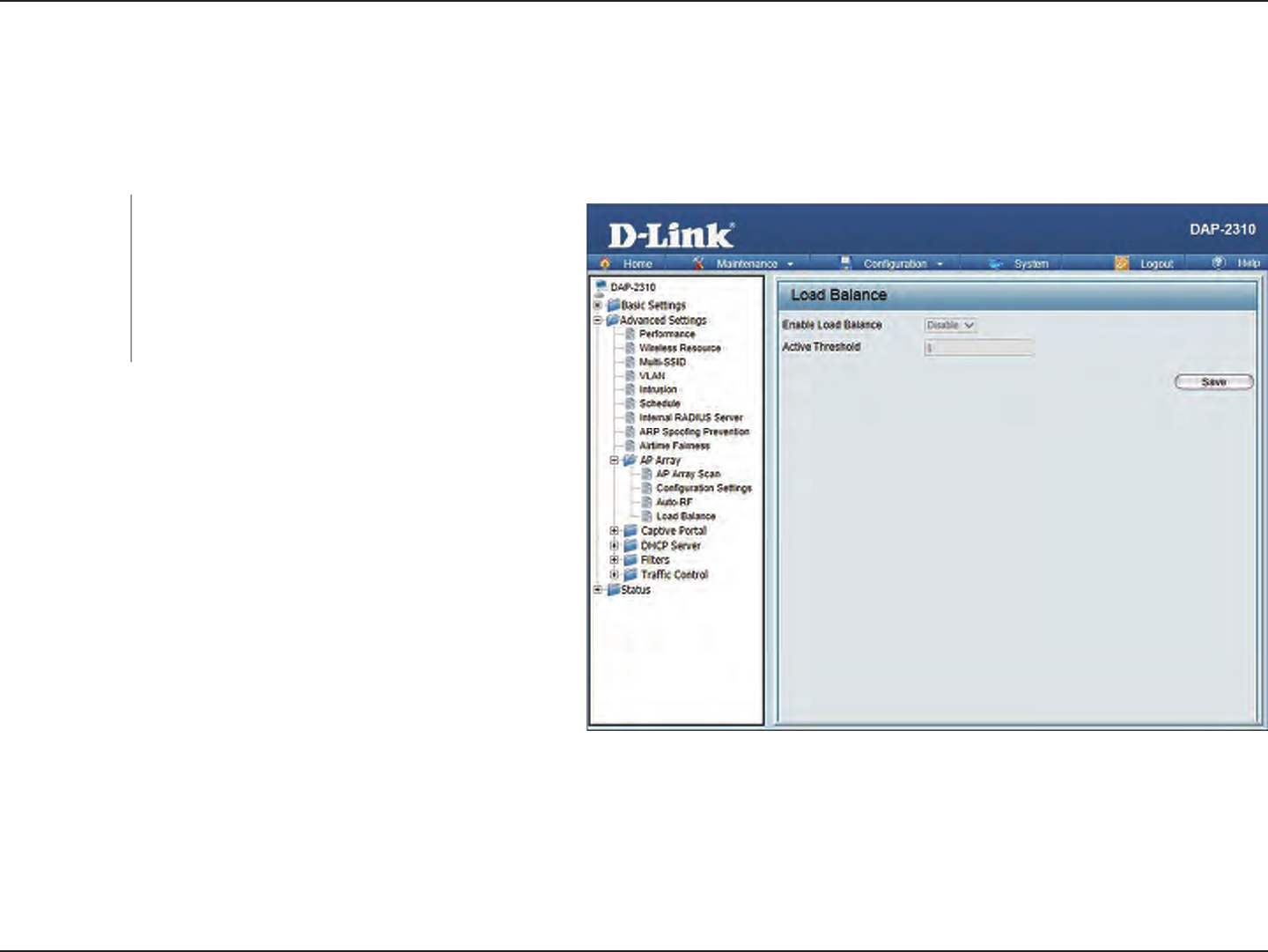
50D-Link DAP-2310 User Manual
Section 3 - Conguration
Load Balance
In this window, users can view and congure the AP array’s load balancing settings. Click the Save button to accept the changes
made.
Select to Enable or Disable the load balance
feature here.
Enter the active threshold value here.
Enable Load
Balance:
Active
Threshold:
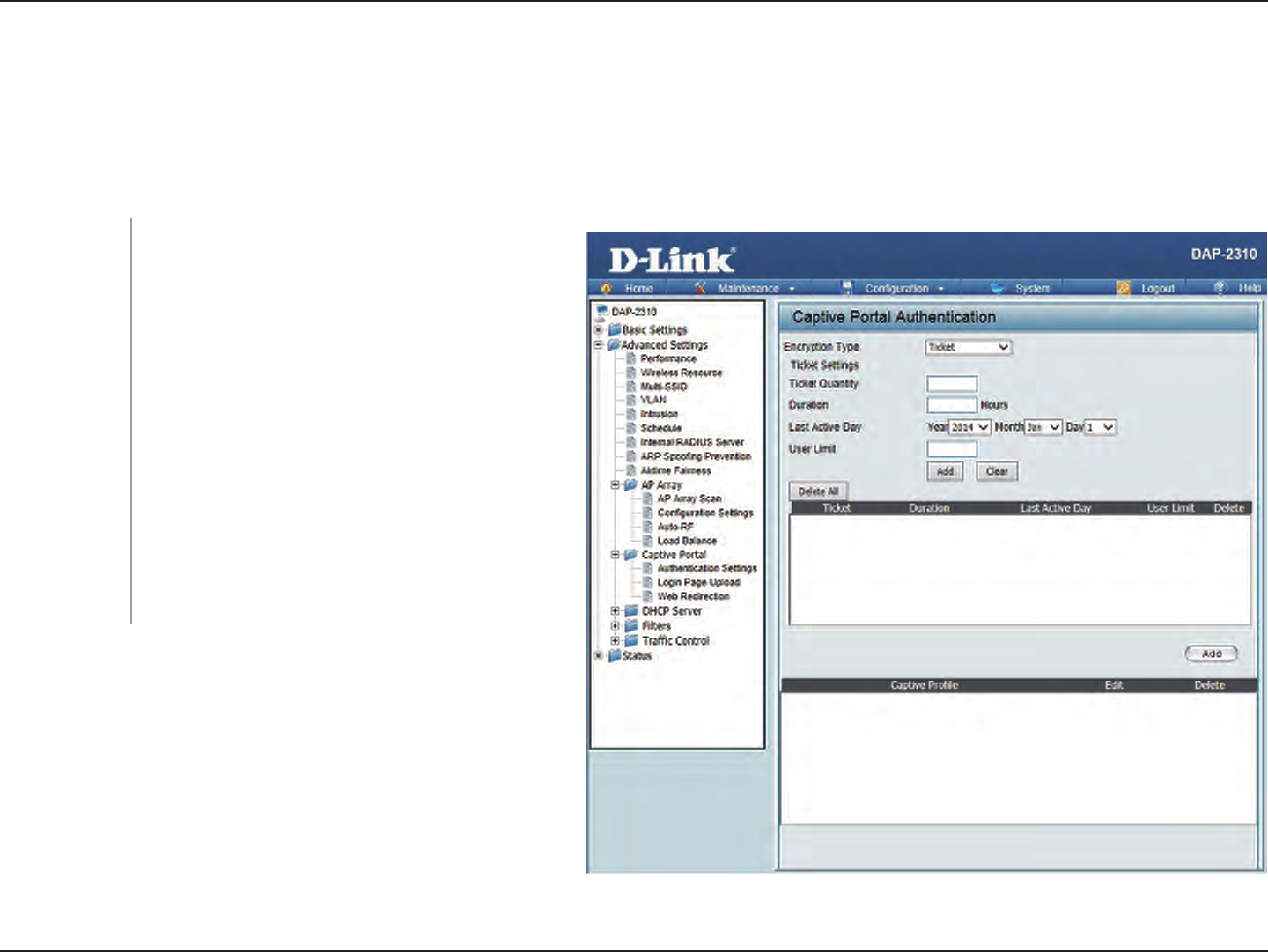
51D-Link DAP-2310 User Manual
Section 3 - Conguration
Captive Portal
Authentication Settings - Ticket
The Captive Portal is a built-in web authentication server. When a station connects to an AP, the web brower will be redirected to a web authentication
page. In this windows, user can view and congure the Captive Portal settings. Click the Add button to add a new entry. Click the Delete or Delete
All button to remove a specic entry or all the entries congured.
Select the captive portal encryption type here.
Options to choose from are Ticket, User/Password,
Remote Radius, LDAP and POP3. In this section
we’ll discuss the Ticket option.
Enter the number of ticket that will be used here.
Enter the duration value, in hours, for this ticket.
Select the last active date for this ticket here. Year,
Month and Day selections can be made.
Enter the maximum amount of users that can use
this ticket at the same time.
Encryption
Type:
Ticket Quantity:
Duration:
Last Active Day:
User Limit:
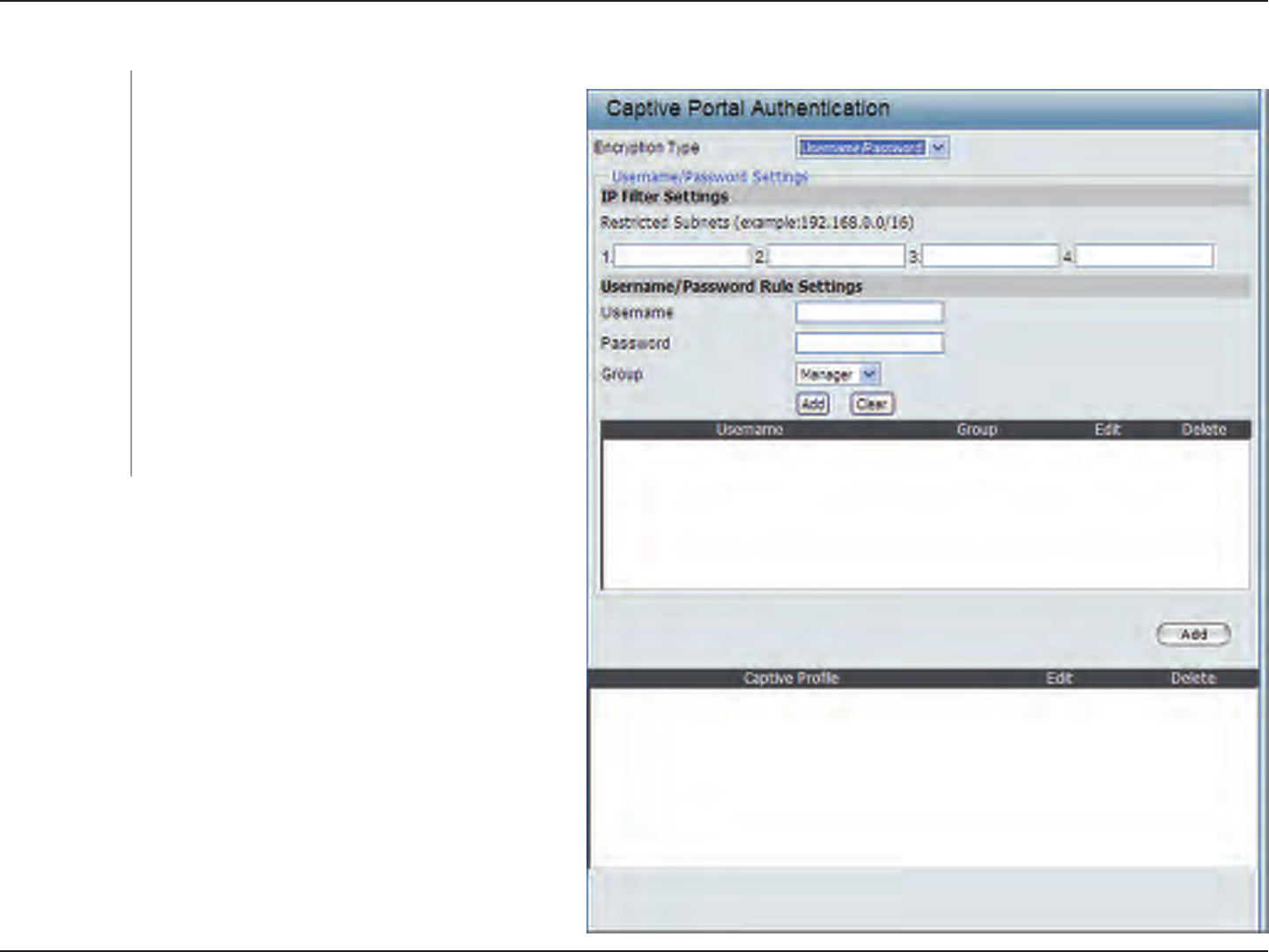
52D-Link DAP-2310 User Manual
Section 3 - Conguration
Authentication Settings - User/Password
Select the captive portal encryption type here.
Options to choose from are Ticket, User/Password,
Remote Radius, LDAP and POP3. In this section
we’ll discuss the User/Password option.
Enter the restricted subnets here. Access to these
subnets will denied to guest accounts. Up to four
restricted subnet entries can be dened.
Enter the username for the new account here.
Enter the password for the new account here.
Select the group for the new account here. Options
to choose from are Manager and Guest. Guest
accounts will have limited access.
Encryption
Type:
Restricted
Subnets:
Username:
Password:
Group:
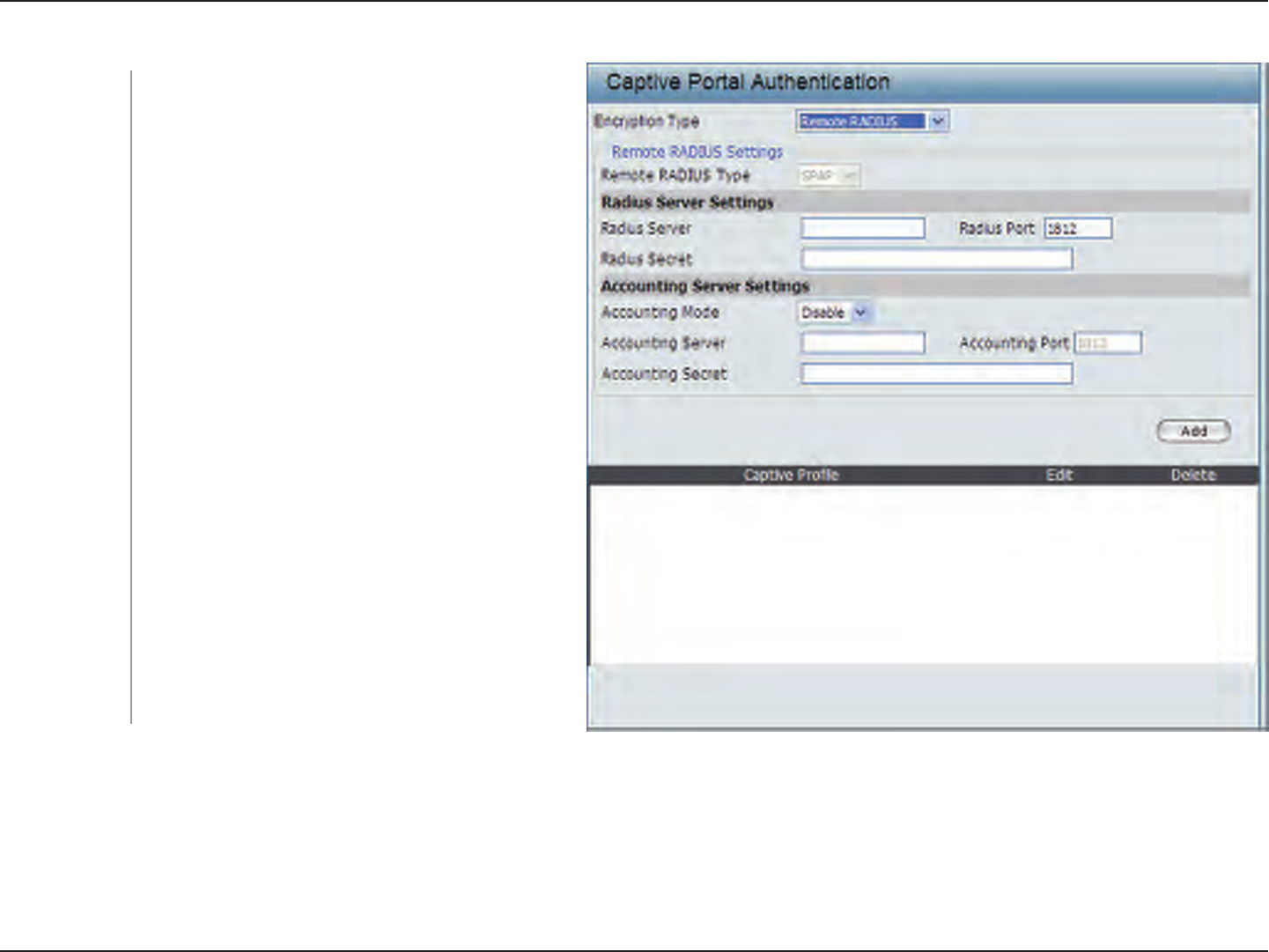
53D-Link DAP-2310 User Manual
Section 3 - Conguration
Authentication Settings - Remote RADIUS
Select the captive portal encryption type here.
Options to choose from are Ticket, User/Password,
Remote Radius, LDAP and POP3. In this section
we’ll discuss the Remote Radius option.
Select the remote RADIUS server type here.
Currently, only SPAP will be used.
Enter the RADIUS server’s IP address here.
Enter the RADIUS server’s port number here.
Enter the RADIUS server’s shared secret here.
Select to Enable or Disable the accounting mode
here.
Enter the accounting server’s IP address here.
Enter the accounting server’s port number here.
Enter the accounting server’s shared serect here.
Encryption
Type:
Remote Radius
Type:
Radius Server:
Radius Port:
Radius Secret:
Accounting
Mode:
Accounting
Server:
Accounting
Port:
Accounting
Secret:
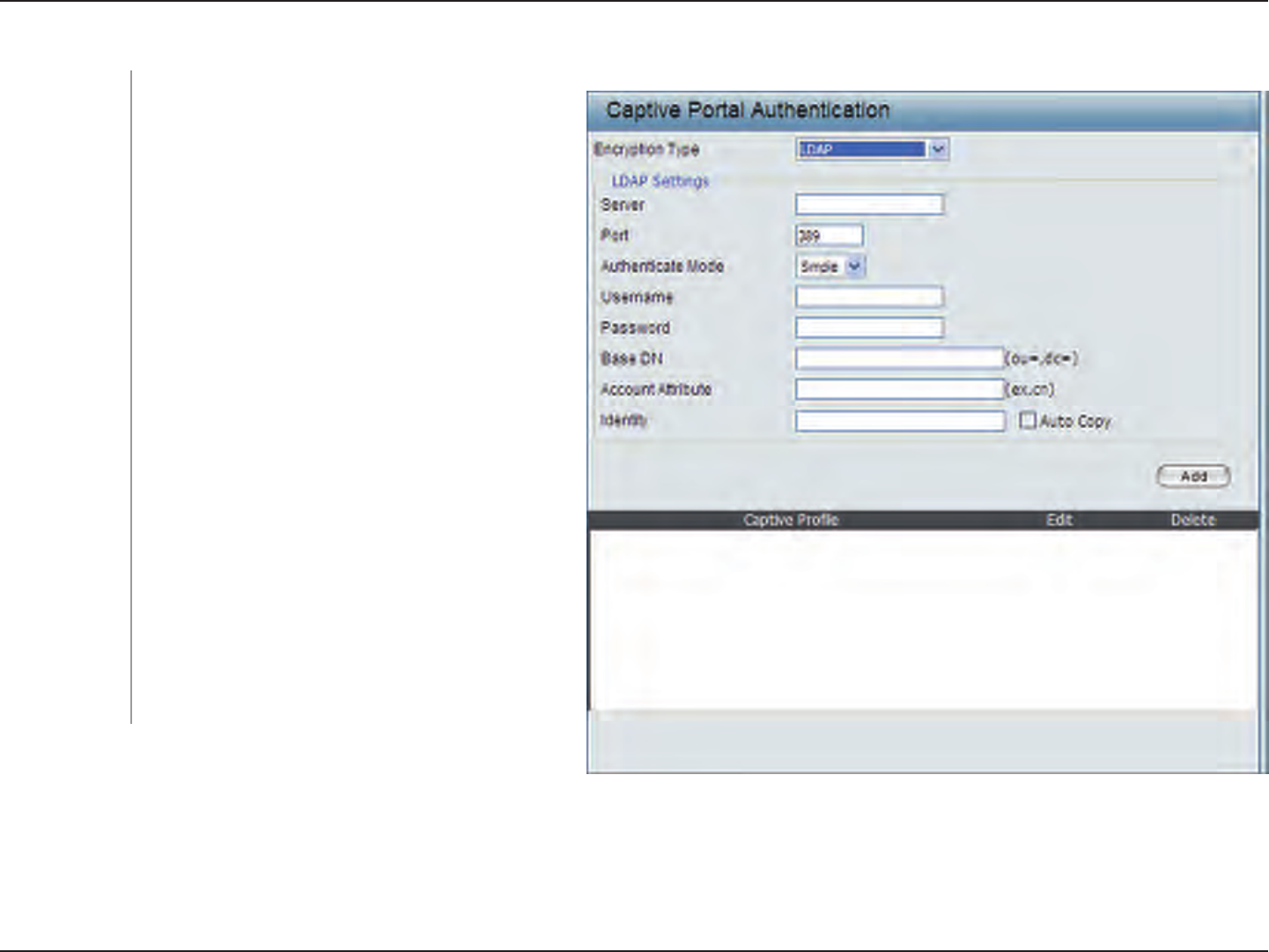
54D-Link DAP-2310 User Manual
Section 3 - Conguration
Authentication Settings - LDAP
Select the captive portal encryption type here.
Options to choose from are Ticket, User/Password,
Remote Radius, LDAP and POP3. In this section
we’ll discuss the LDAP option.
Enter the LDAP server’s IP address or domain name
here.
Enter the LDAP server’s port number here.
Select the authentication mode here. Options to
choose from are Simple and TLS.
Enter the LDAP server account’s username here.
Enter the LDAP server account’s password here.
Enter the administrator’s domain name here.
Enter the LDAP account attribute string here. This
string will be used to search for clients.
Enter the identity’s full path string here. Alternatively,
select the Auto Copy checkbox to automatically
add the generic full path of the web page in the
identity eld.
Encryption
Type:
Server:
Port:
Authenticate
Mode:
Username:
Password:
Base DN:
Account
Attribute:
Identity:
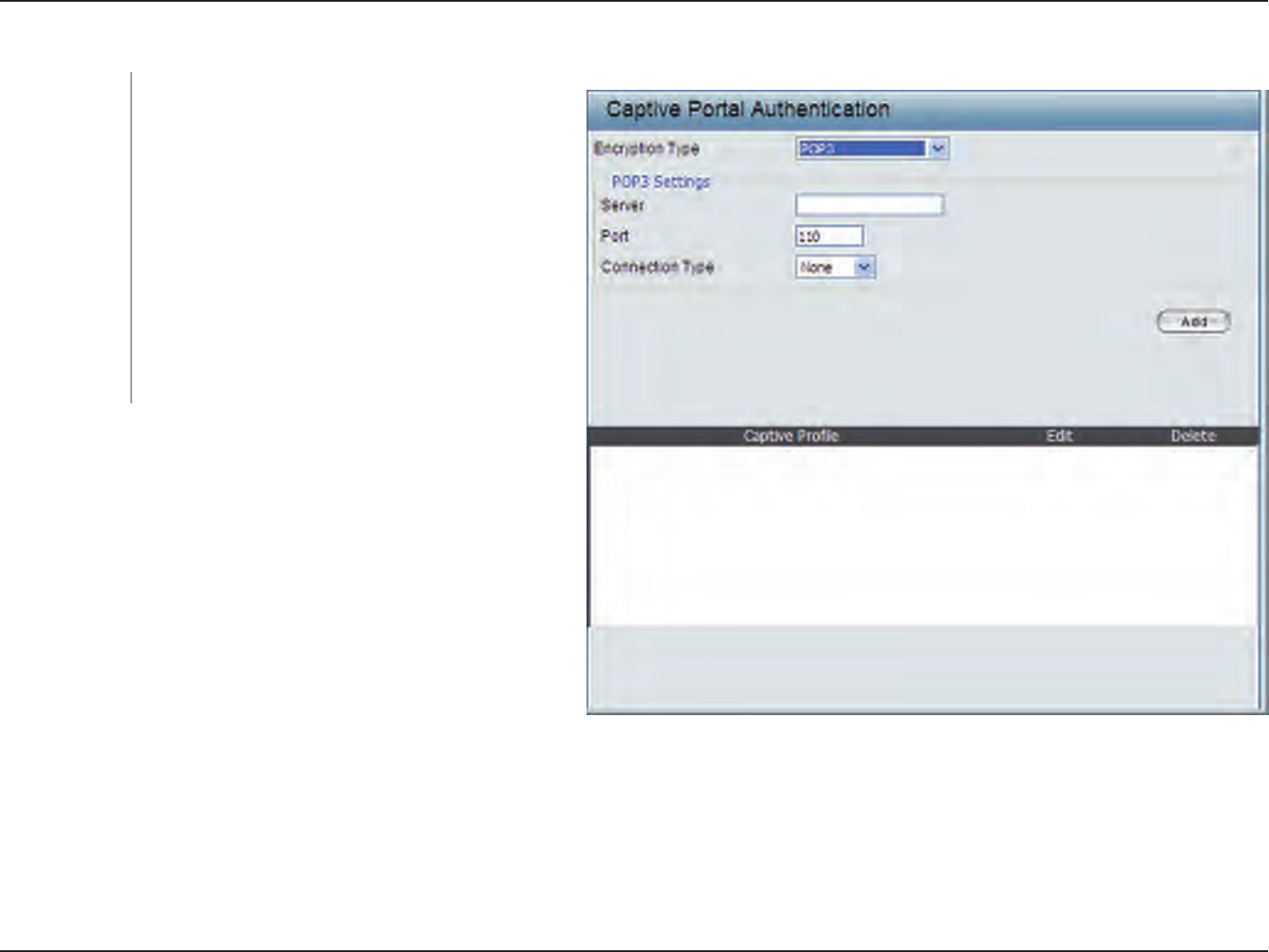
55D-Link DAP-2310 User Manual
Section 3 - Conguration
Authentication Settings - POP3
Select the captive portal encryption type here.
Options to choose from are Ticket, User/Password,
Remote Radius, LDAP and POP3. In this section
we’ll discuss the Ticket option.
Enter the POP3 server’s IP address or domain name
here.
Enter the POP server’s port number here.
Select the connection type here. Options to choose
from are None and SSL/TLS.
Encryption
Type:
Server:
Port:
Connection
Type:
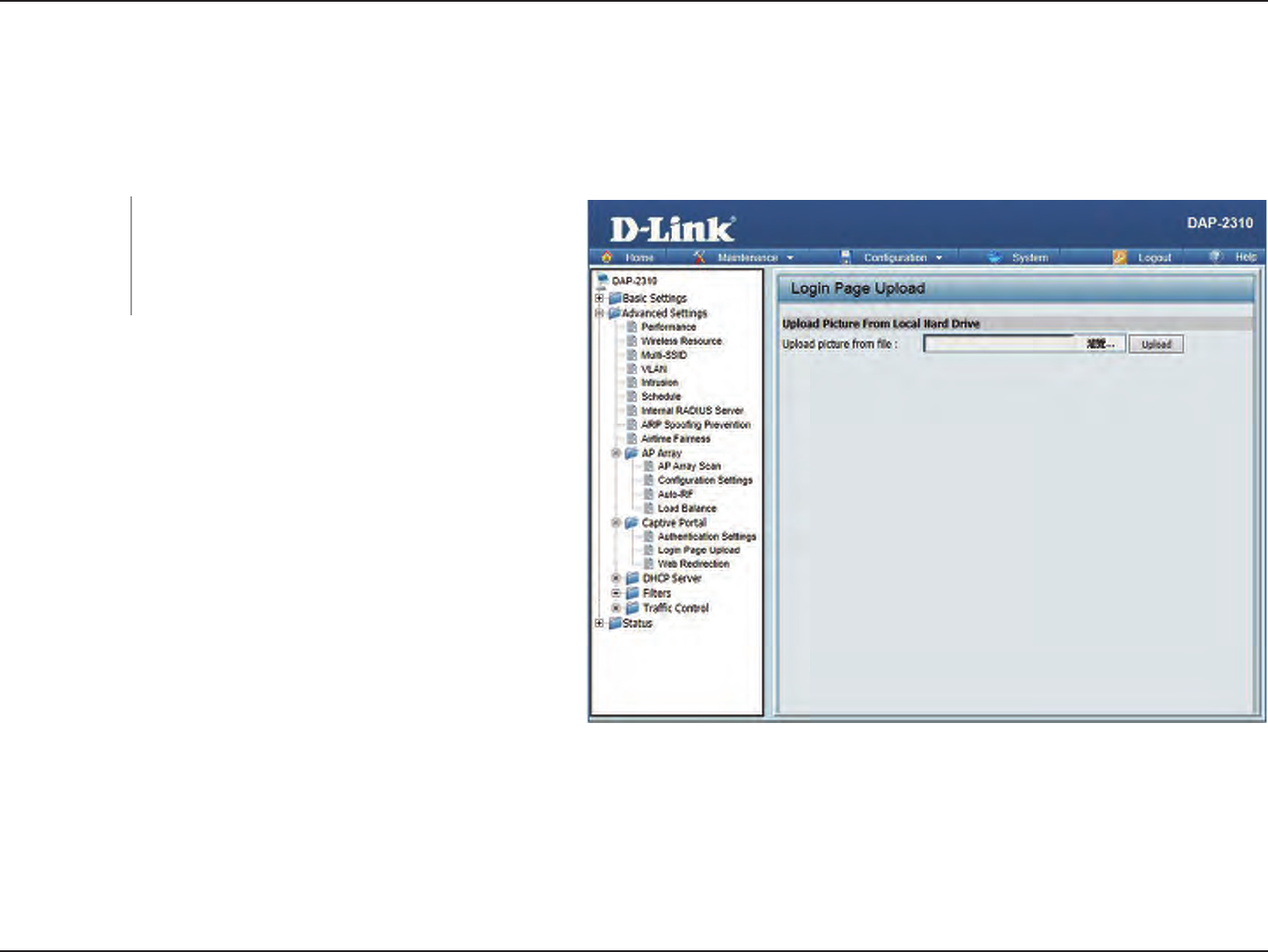
56D-Link DAP-2310 User Manual
Section 3 - Conguration
Login Page Upload
In this window, users can upload a custom login page picture that will be used by the captive portal feature. Click the Browse
button to navigate to the image le, located on the managing computer and then click the Upload button to initiate the upload.
In this eld the path to the image le, that will be
uploaded, will be displayed. Alternatively, the path
can be manually entered here.
Upload picture
from le:
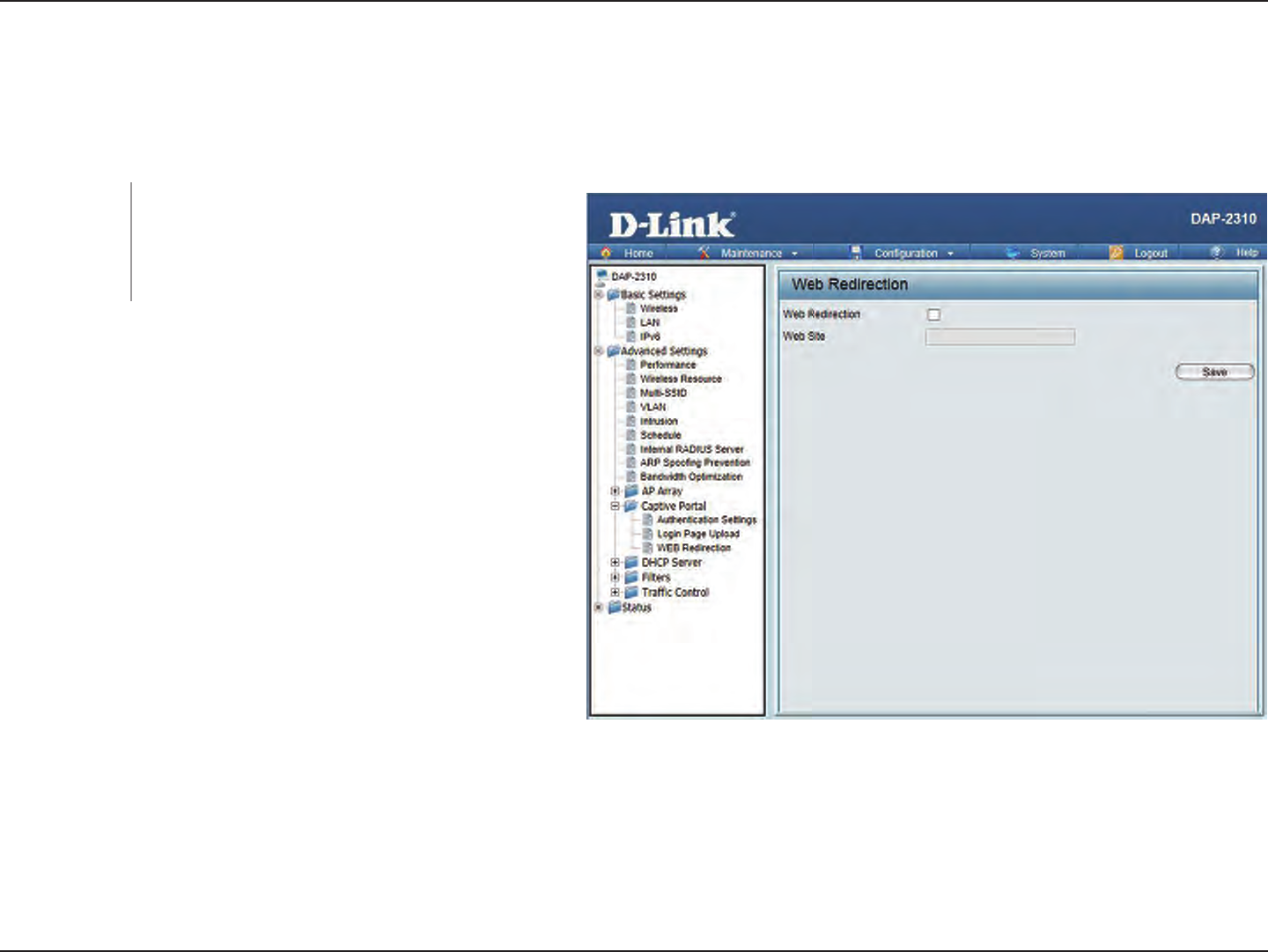
57D-Link DAP-2310 User Manual
Section 3 - Conguration
Web Redirection
In this windows, users can view and congure the Web redirection settings for the captive portal hosted by this access point.
Wireless clients will be redirected to this web site prior and after authentication. Click the Save button to accept the changes
made.
Select this checkbox to enable the Web redirection
feature.
Enter the destination web site’s address here.
Web
Redirection:
Web Site:
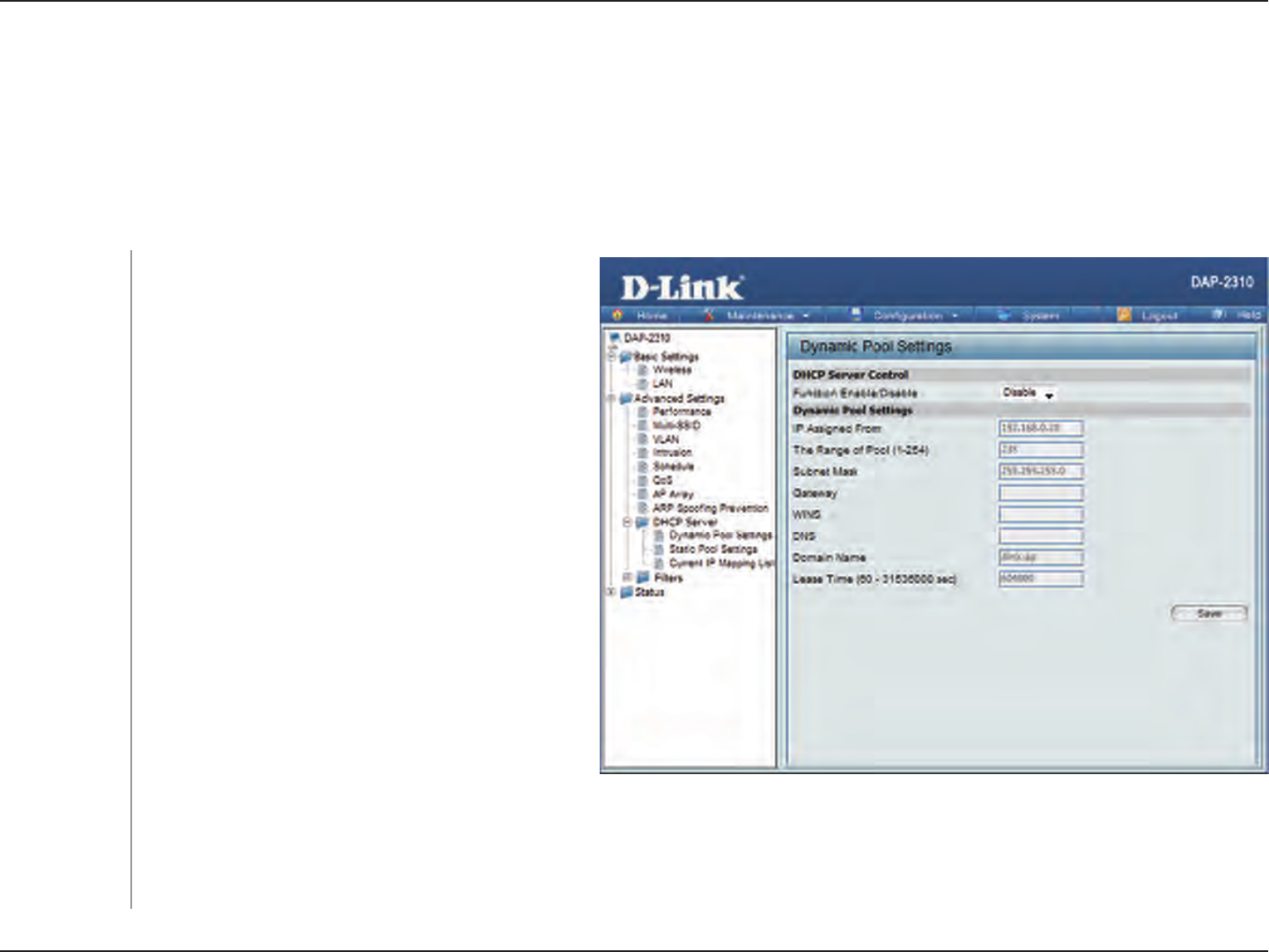
58D-Link DAP-2310 User Manual
Section 3 - Conguration
DHCP Server
Dynamic Pool Settings
The DHCP address pool denes the range of the IP address that can be assigned to stations in the network. A Dynamic Pool
allows wireless stations to receive an available IP with lease time control. If needed or required in the network, the DAP-2310
is capable of acting as a DHCP server.
Dynamic Host Configuration Protocol (DHCP)
assigns dynamic IP addresses to devices on
the network. This protocol simplifies network
management and allows new wireless devices to
receive IP addresses automatically without the need
to manually assign new IP addresses. Select Enable
to allow the DAP-2310 to function as a DHCP server.
Input the rst IP address available for assignment
on your network.
Enter the number of IP addresses available for
assignment. IP addresses are increments of the IP
address specied in the “IP Assigned From” eld.
All devices in the network must have the same
subnet mask to communicate. Enter the submask
for the network here.
Enter the IP address of the gateway on the network.
Specify the Windows Internet Naming Service (WINS) server address for the wireless network. WINS is a system that determines
the IP address of a network computer that has a dynamically assigned IP address.
Function
Enable/Disable:
IP Assigned
From:
The Range of
Pool (1-254):
Subnet Mask:
Gateway:
WINS:

59D-Link DAP-2310 User Manual
Section 3 - Conguration
Enter the IP address of the Domain Name System (DNS) server. The DNS server translates domain names such as
www.dlink.com into IP addresses.
Enter the domain name of the network, if applicable. (An example of a domain name is: www.dlink.com.)
The lease time is the period of time before the DHCP server will assign new IP addresses.
DNS:
Domain Name:
Lease Time
(60-31536000
sec):
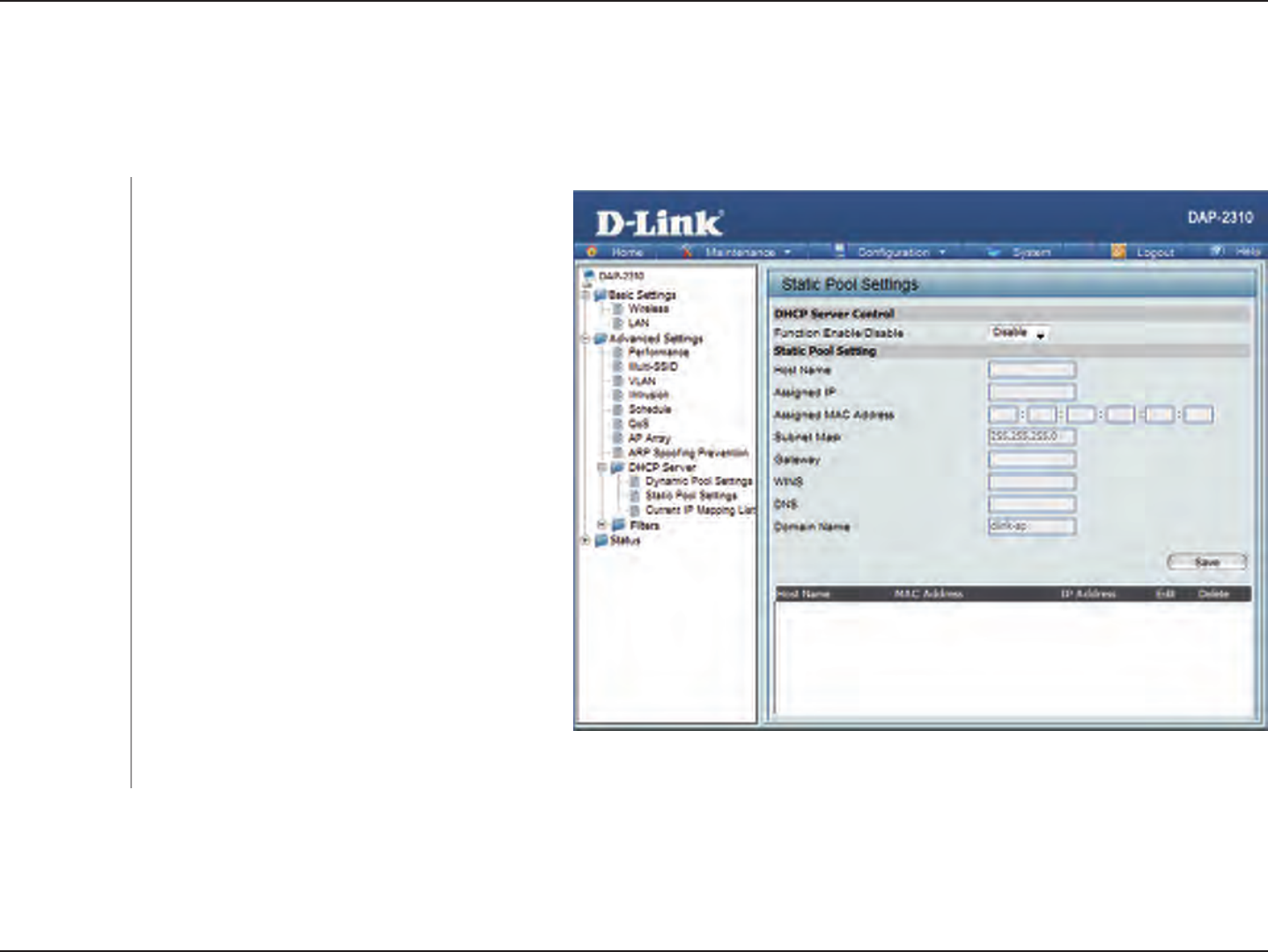
60D-Link DAP-2310 User Manual
Section 3 - Conguration
Static Pool Setting
The DHCP address pool denes the range of IP addresses that can be assigned to stations on the network. A static pool allows
specic wireless stations to receive a xed IP without time control.
Dynamic Host Conguration Protocol (DHCP)
assigns IP addresses to wireless devices on
the network. This protocol simplies network
management and allows new wireless devices
to receive IP addresses automatically without
the need to manually assign IP addresses. Select
Enable to allow the DAP-2310 to function as a
DHCP server.
Use the Static Pool Settings to assign the same IP
address to a device every time you start up. The
IP addresses assigned in the Static Pool list must
NOT be in the same IP range as the Dynamic
Pool. After you have assigned a static IP address
to a device via its MAC address, click Save; the
device will appear in the Assigned Static Pool at
the bottom of the screen. You can edit or delete
the device in this list.
Enter the MAC address of the device requesting
association here.
Dene the submask of the IP address specied
in the “IP Assigned From” eld.
Function
Enable/Disable:
Assigned IP:
Assigned MAC
Address:
Subnet Mask:

61D-Link DAP-2310 User Manual
Section 3 - Conguration
Specify the Gateway address for the wireless network.
Specify the Windows Internet Naming Service (WINS) server address for the wireless network. WINS is a system that determines
the IP address of a network computer with a dynamically assigned IP address, if applicable.
Enter the Domain Name System (DNS) server address for the wireless network. The DNS server translates domain names such as
www.dlink.com into IP addresses.
Specify the domain name for the network.
Gateway:
WINS:
DNS:
Domain Name:
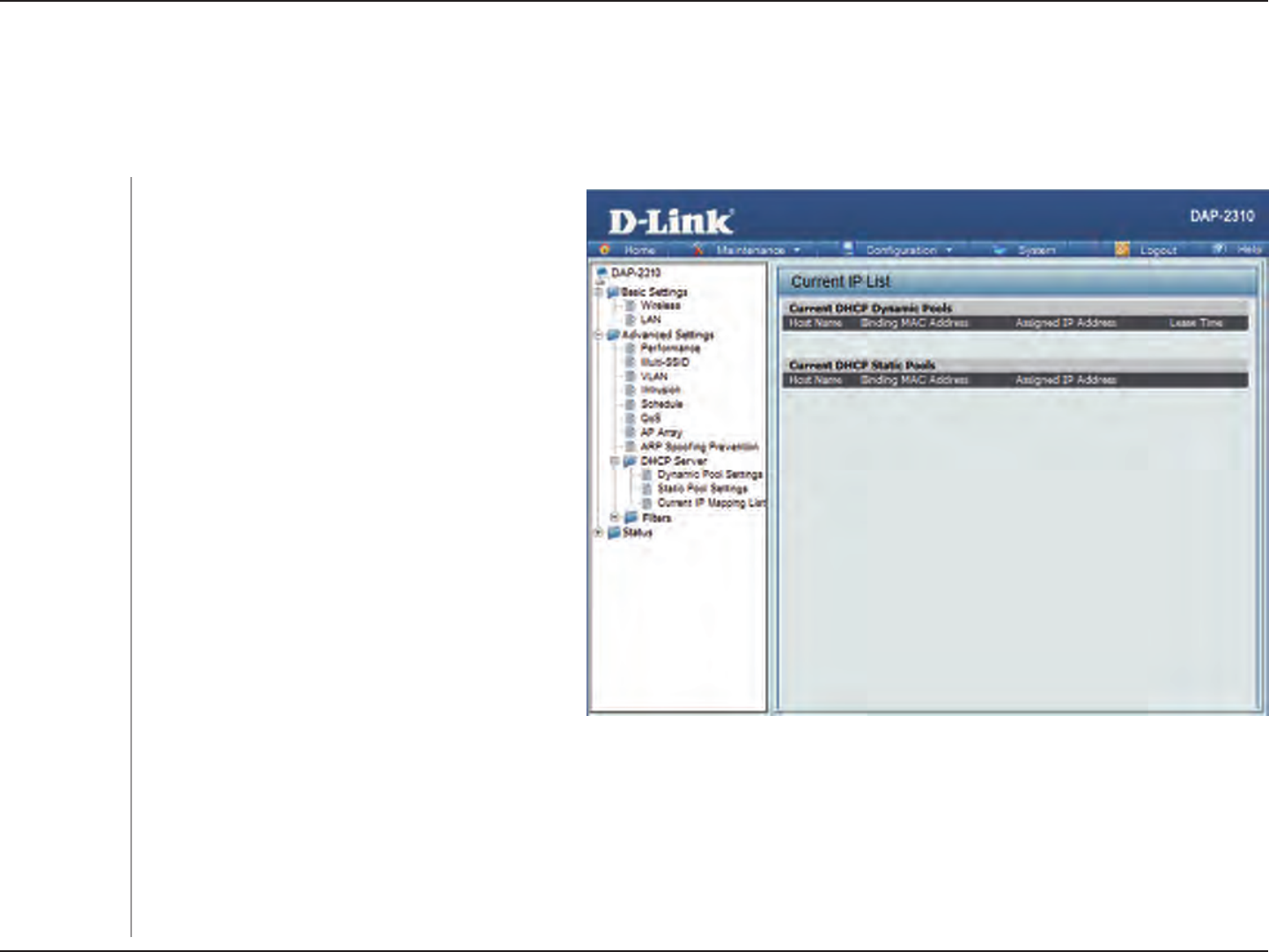
62D-Link DAP-2310 User Manual
Section 3 - Conguration
Current IP Mapping List
This window displays information about the current assigned DHCP dynamic and static IP address pools. This information is
available when you enable DHCP server on the AP and assign dynamic and static IP address pools.
These are IP address pools the DHCP server has
assigned using the dynamic pool setting.
The host name of a device on the network that is
assigned an IP address from the DHCP dynamic
pool.
The MAC address of a device on the network that
is assigned an IP address from the DHCP dynamic
pool.
The current corresponding DHCP-assigned IP
address of the device.
The length of time that the dynamic IP address
will be valid.
These are the IP address pools of the DHCP server
assigned through the static pool settings.
The host name of a device on the network that is assigned an IP address from the DHCP dynamic pool.
The MAC address of a device on the network that is within the DHCP static IP address pool.
The current corresponding DHCP-assigned static IP address of the device.
Current DHCP
Dynamic
Prole:
Host Name:
Binding MAC
Address:
Assigned IP
Address:
Lease Time:
Current DHCP
Static Pools:
Host Name:
Binding MAC
Address:
Assigned IP
Address:
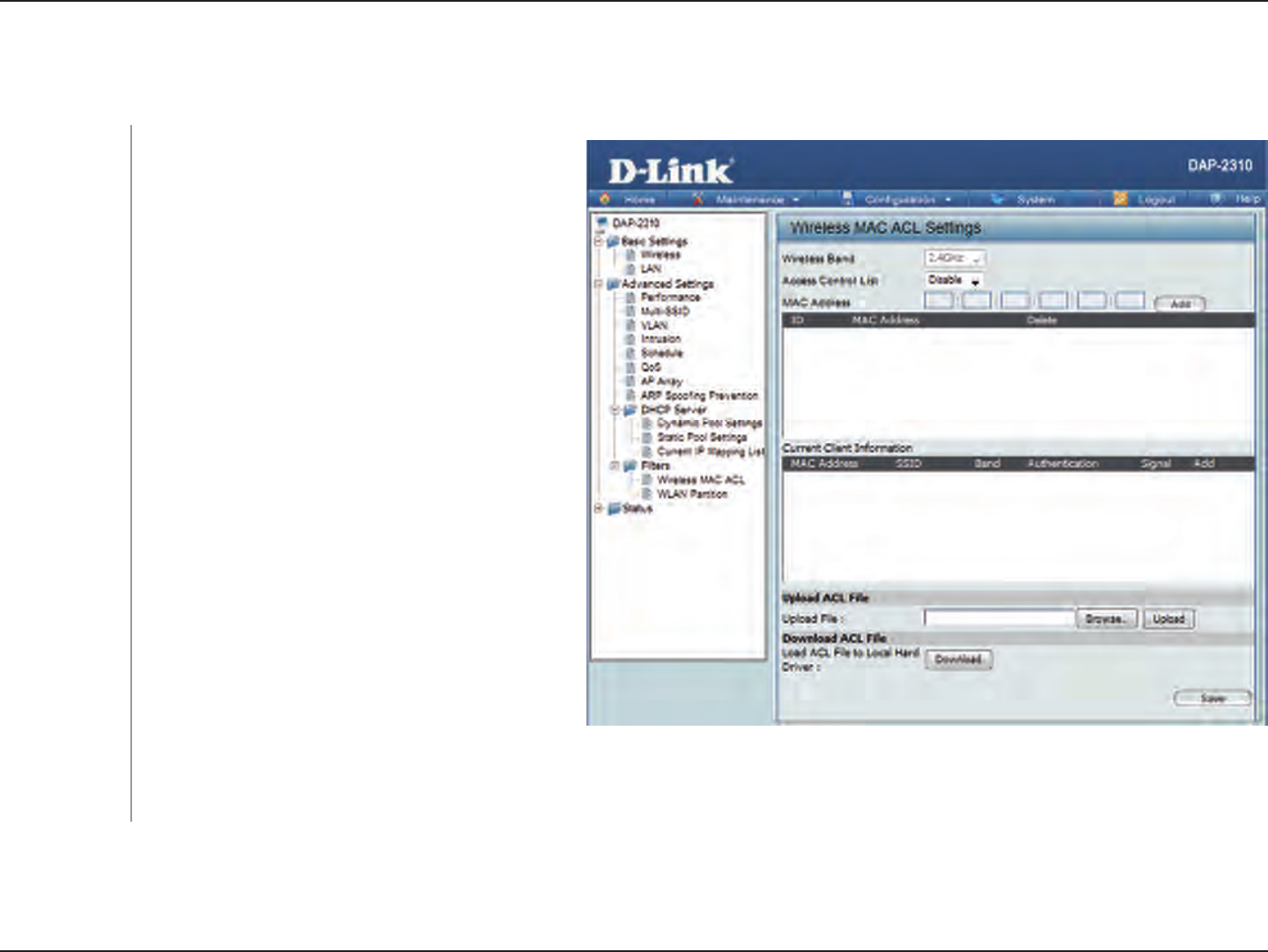
63D-Link DAP-2310 User Manual
Section 3 - Conguration
Filters
Wireless MAC ACL
Displays the current wireless band rate.
Select Disable to disable the lters function.
Select Accept to accept only those devices with
MAC addresses in the Access Control List. All
other devices not on the list will be rejected.
Select Reject to reject the devices with MAC
addresses on the Access Control List. All other
devices not on the list will be accepted.
Enter each MAC address that you wish to include
in your lter list, and click Add.
When you enter a MAC address, it appears in this
list. Highlight a MAC address and click Delete to
remove it from this list.
You may create an ACL list and upload it to the
access point instead of manually entering the
information. Once created, click the Browse
button and locate your le. Select it and then
click Upload.
Click Download to export the ACL to a le on
your computer.
Wireless Band:
Access Control
List:
MAC Address:
MAC Address
List:
Upload ACL File:
Download ACL
File:
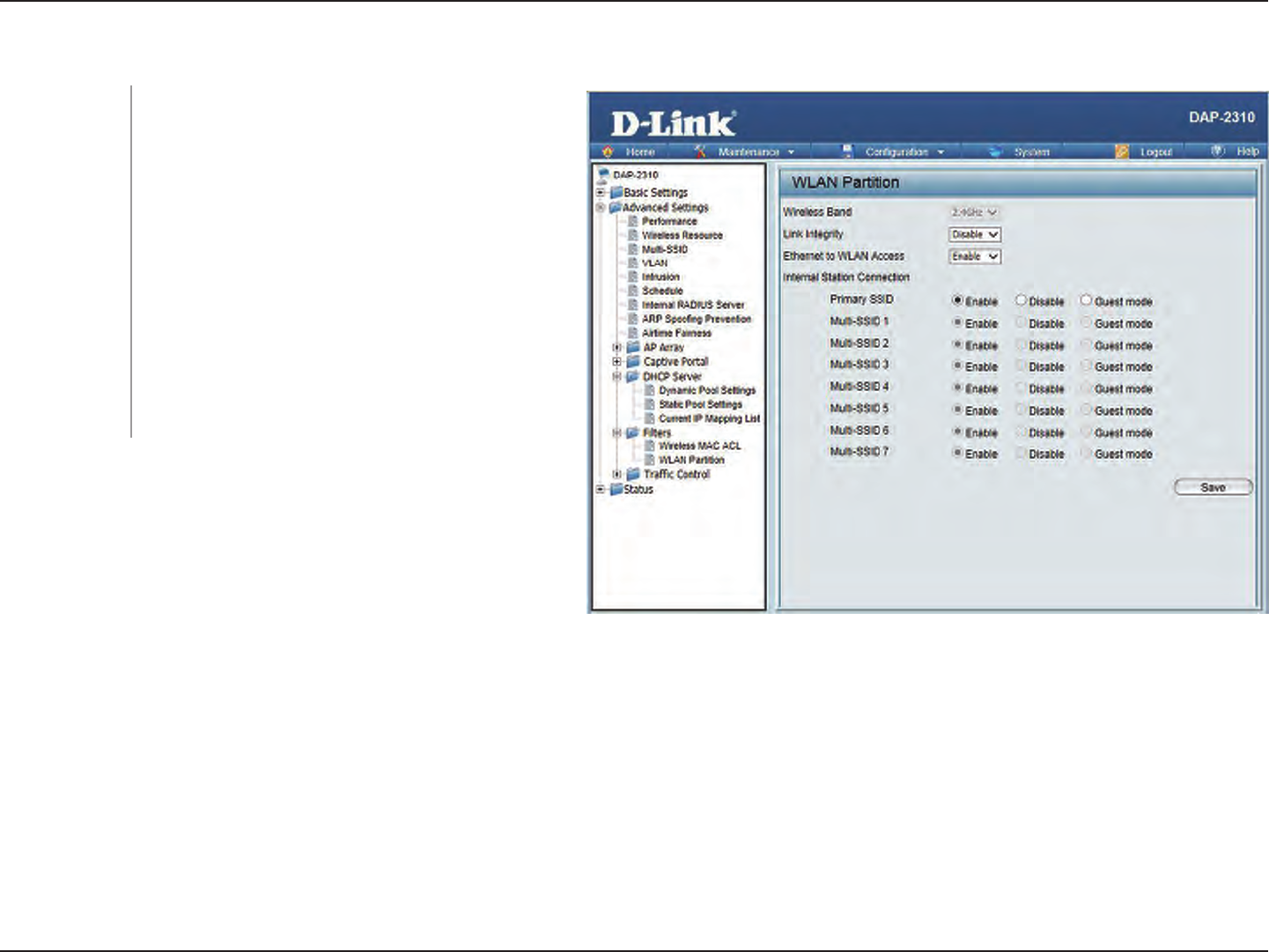
64D-Link DAP-2310 User Manual
Section 3 - Conguration
WLAN Partition
Displays the current wireless band rate.
Select Enable or Disable.
The default is Enable. When disabled, all data
from the Ethernet to associated wireless devices
will be blocked. Wireless devices can still send
data to the Ethernet.
The default value is Enable, which allows stations
to inter-communicate by connecting to a target
AP. When disabled, wireless stations cannot
exchange data through the AP.
Wireless Band:
Link Integrity:
Ethernet to
WLAN Access:
Internal Station
Connection:
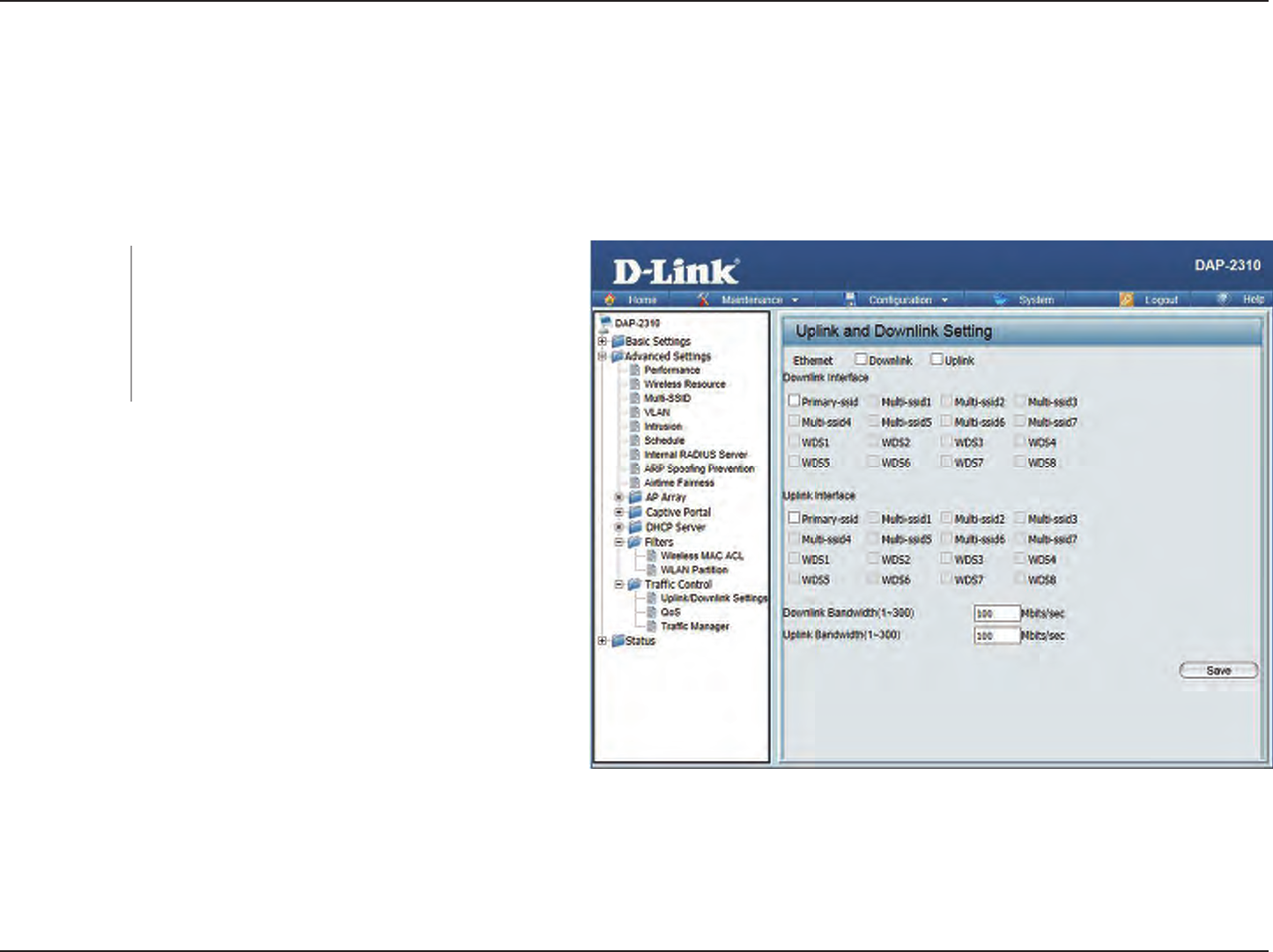
65D-Link DAP-2310 User Manual
Section 3 - Conguration
Trac Control
Uplink/Downlink Settings
The uplink/downlink setting allows users to customize the downlink and uplink interfaces including specifying downlink/uplink
bandwidth rates in Mbits per second. These values are also used in the QoS and Trac Manager windows. Once the desired
uplink and downlink settings are nished, click the Save button to let your changes take eect.
Downlink
Bandwidth:
Uplink
Bandwidth:
The downlink bandwidth in Mbits per second.
Uplink Bandwidth: The uplink bandwidth in
Mbits per second.
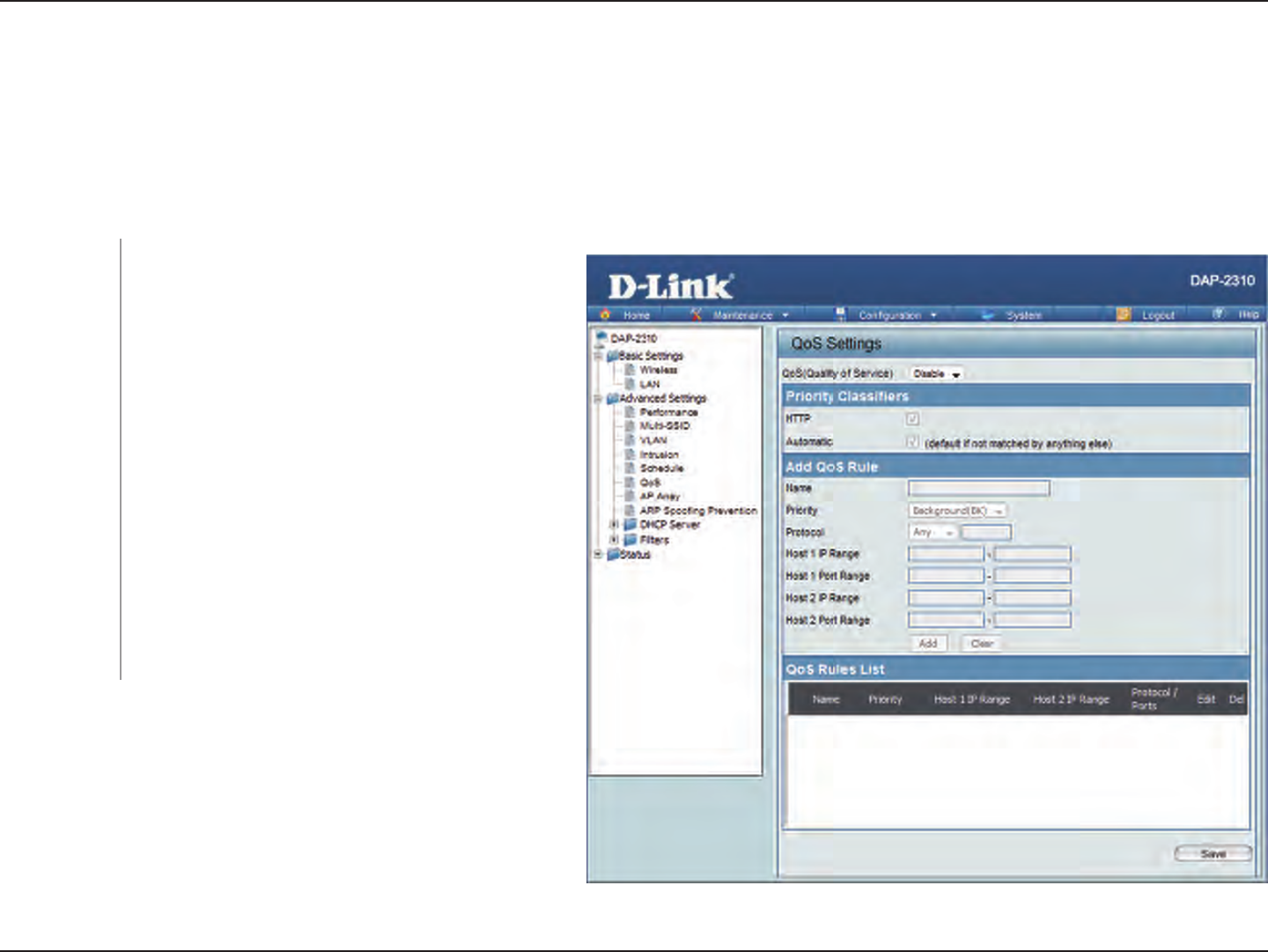
66D-Link DAP-2310 User Manual
Section 3 - Conguration
QoS
Quality of Service (QoS) enhances the experience of using a network by prioritizing the trac of dierent applications. A QoS
Rule identies a specic message ow and assigns a priority to that ow. For most applications, the priority classiers ensure
the right priorities and specic QoS Rules are not required. QoS supports overlaps between rules. If more than one rule matches
a specic message ow, the rule with the highest priority will be used.
Enable this option if you want to allow QoS to
prioritize your trac Priority Classiers.
Allows the access point to recognize HTTP
transfers for many common audio and video
streams and prioritize them above other trac.
Such streams are frequently used by digital media
players.
When enabled, this option causes the access
point to automatically attempt to prioritize trac
streams that it does not otherwise recognize,
based on the behavior that the streams exhibit.
This acts to de-prioritize streams that exhibit bulk
transfer characteristics, such as le transfers, while
leaving interactive trac, such as gaming or VoIP,
running at a normal priority.
QoS (Quality of
Service):
HTTP:
Automatic:
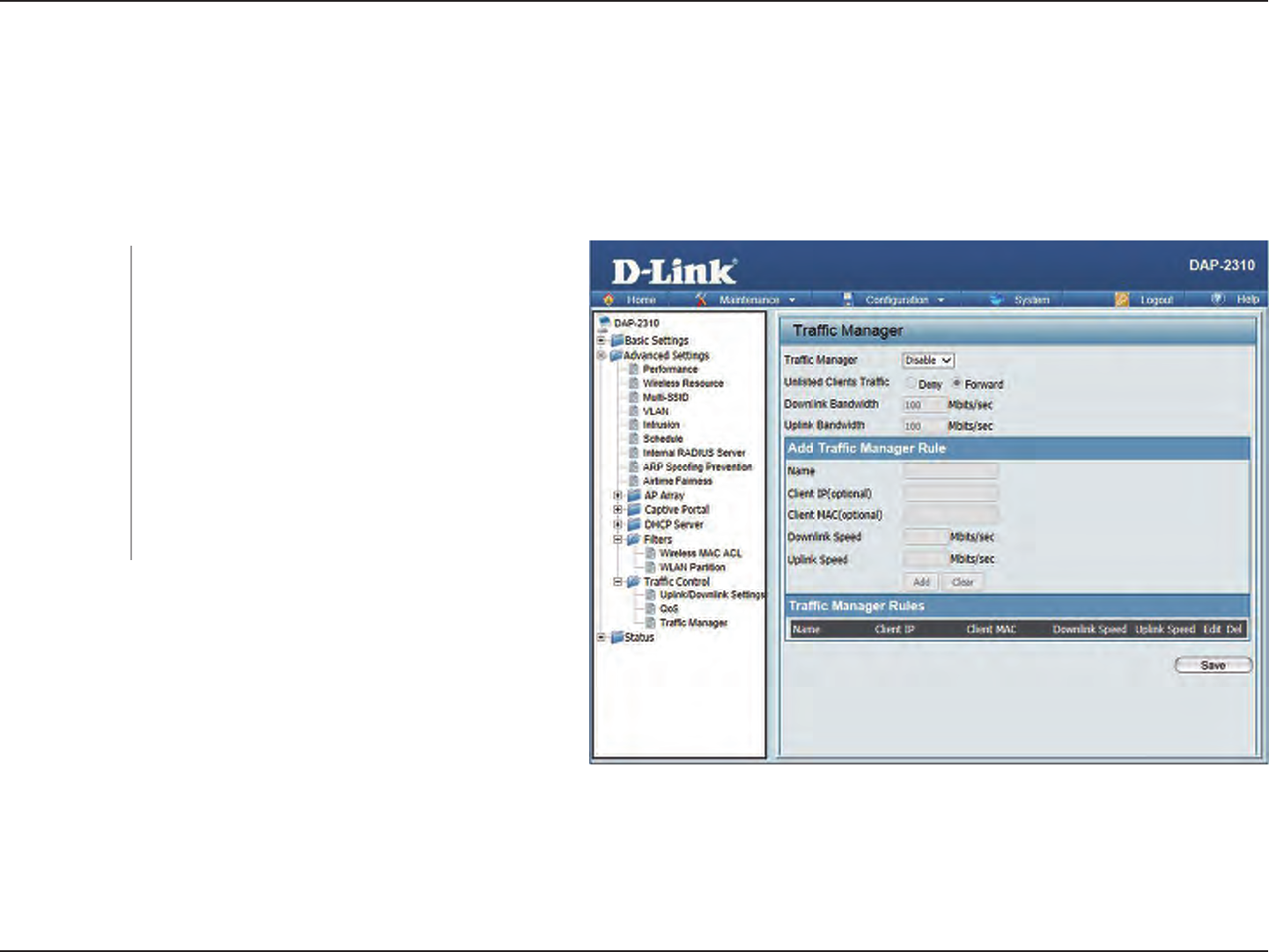
67D-Link DAP-2310 User Manual
Section 3 - Conguration
Trac Manager
The trac manager feature allows users to create trac management rules that specify how to deal with listed client trac
and specify downlink/ uplink speed for new trac manager rules. Click the Save button to let your changes take eect.
Trac
Manager:
Unlisted Client
Trac:
Downlink
Bandwidth:
Uplink
Bandwidth:
Use the drop-down menu to Enable the trac
manager feature.
Select Deny or Forward to determine how to
deal with unlisted client trac.
The downlink bandwidth in Mbits per second.
This value is entered in the Uplink/Downlink
Setting window.
Uplink Bandwidth:The uplink bandwidth in
Mbits per second. This value is entered in the
Uplink/Downlink Setting window.
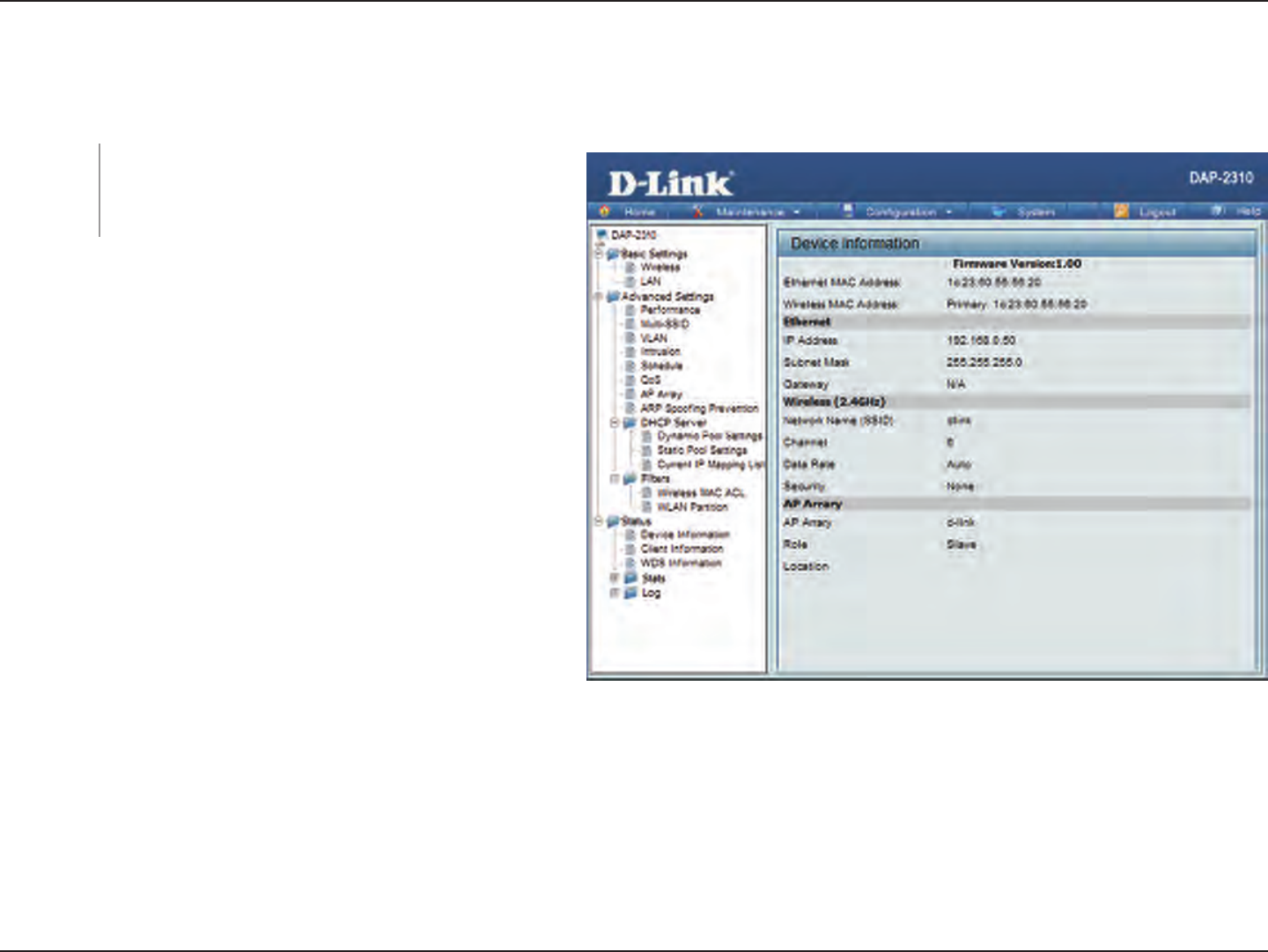
68D-Link DAP-2310 User Manual
Section 3 - Conguration
Status
Device Information
This read-only window displays the configuration
settings of the DAP-2310, including the firmware
version and the device's MAC address.
Device
Information:
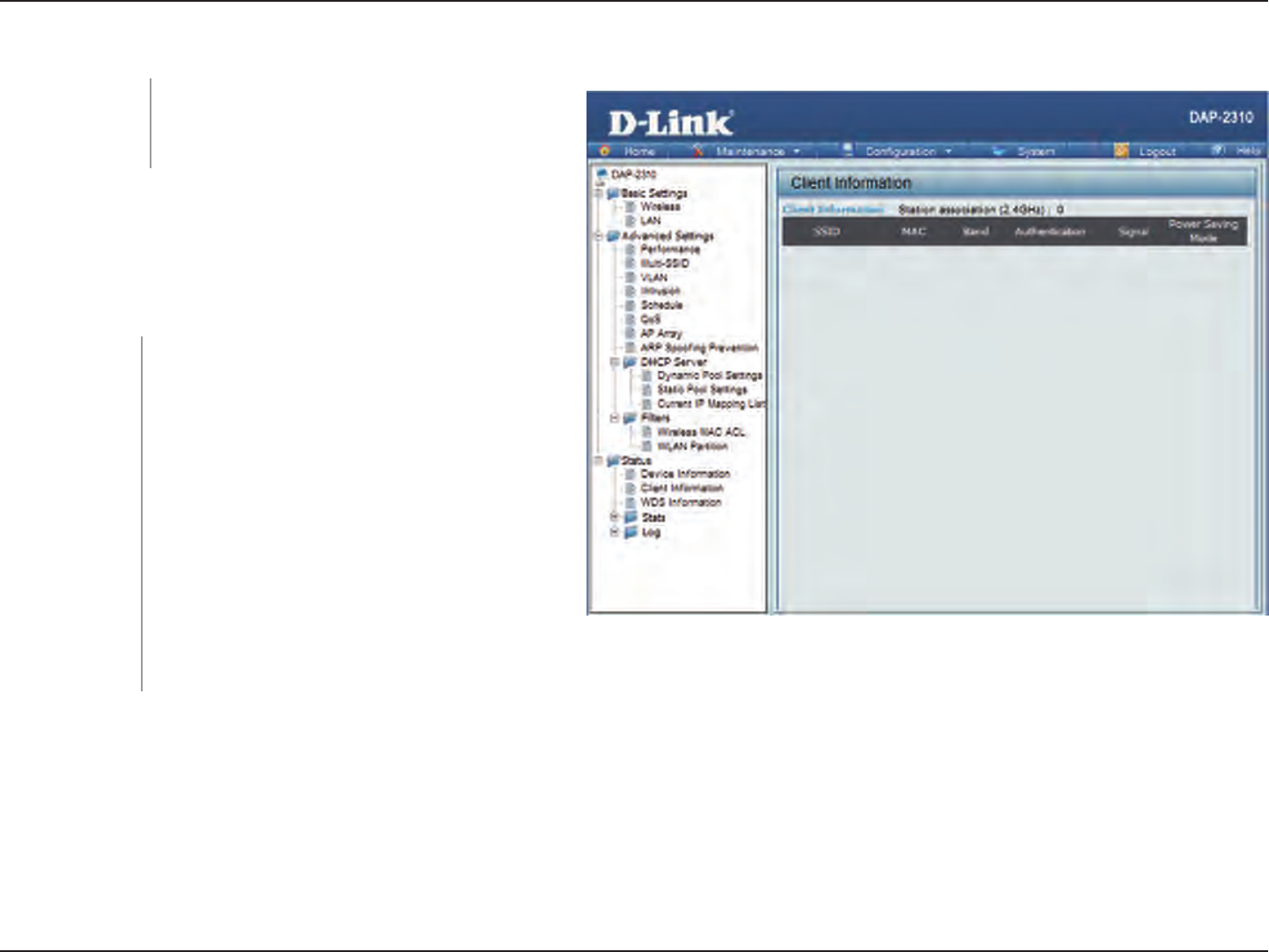
69D-Link DAP-2310 User Manual
Section 3 - Conguration
The following information is available for each client
communicating with the DAP-2310.
Client Information
This window displays the wireless client
information for clients currently connected
to the DAP-2310.
Client Information:
Displays the SSID of the client.
Displays the MAC address of the client.
Displays the wireless band that the client is
connected to.
Displays the type of authentication being
used.
Displays the client's signal strength.
Displays the status of the power saving
feature.
SSID:
MAC:
Band:
Authentication:
Signal:
Power Saving
Mode:
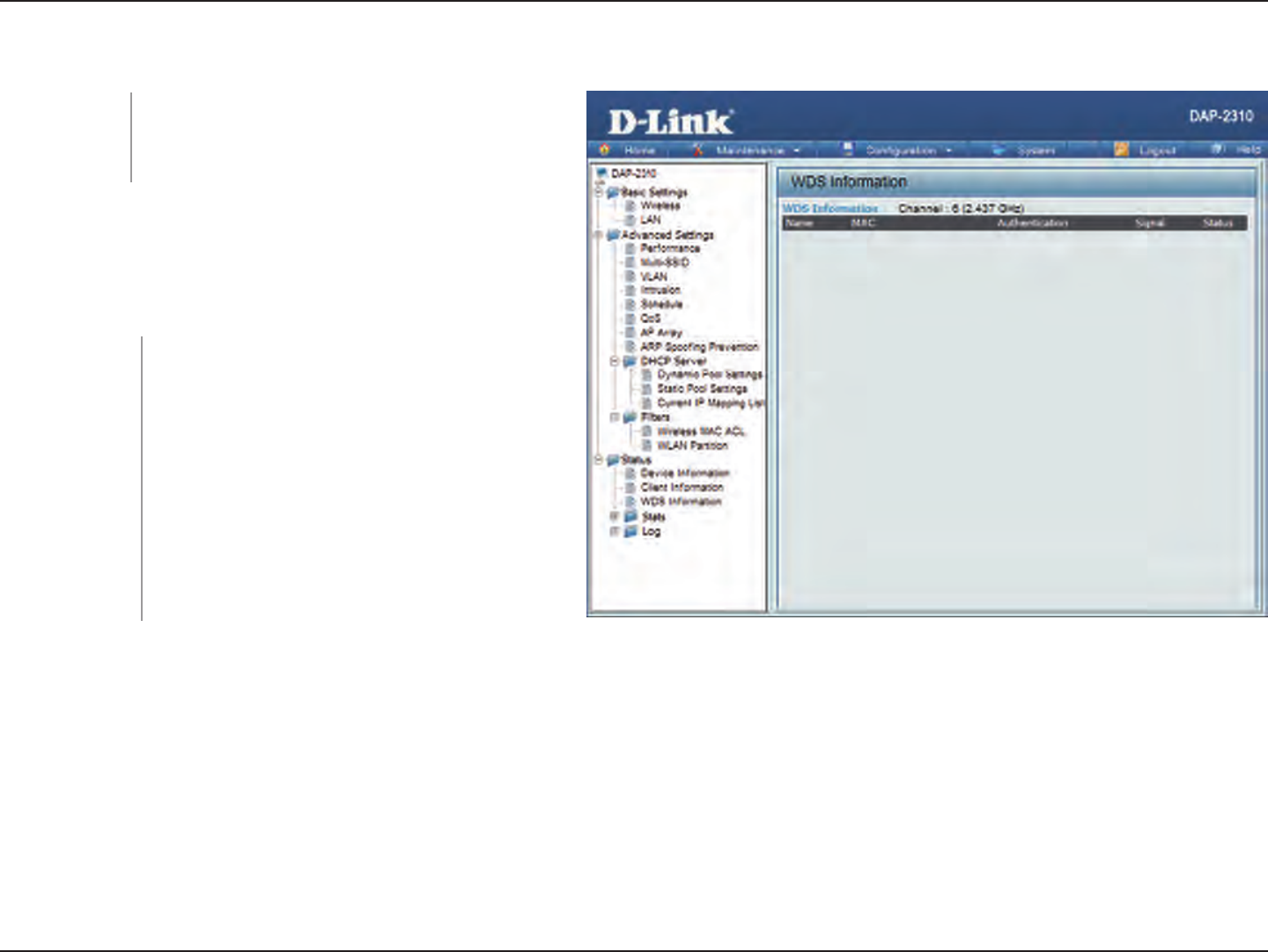
70D-Link DAP-2310 User Manual
Section 3 - Conguration
WDS Information
The following information is available for each client
communicating with the DAP-2310.
This window displays the Wireless
Distribution System information for clients
currently connected to the DAP-2310.
WDS
Information:
Displays the SSID of the client.
Displays the MAC address of the client.
Displays the type of authentication being
used.
Displays the client's signal strength.
Displays the status of the power saving
feature.
Name:
MAC:
Authentication:
Signal:
Status:
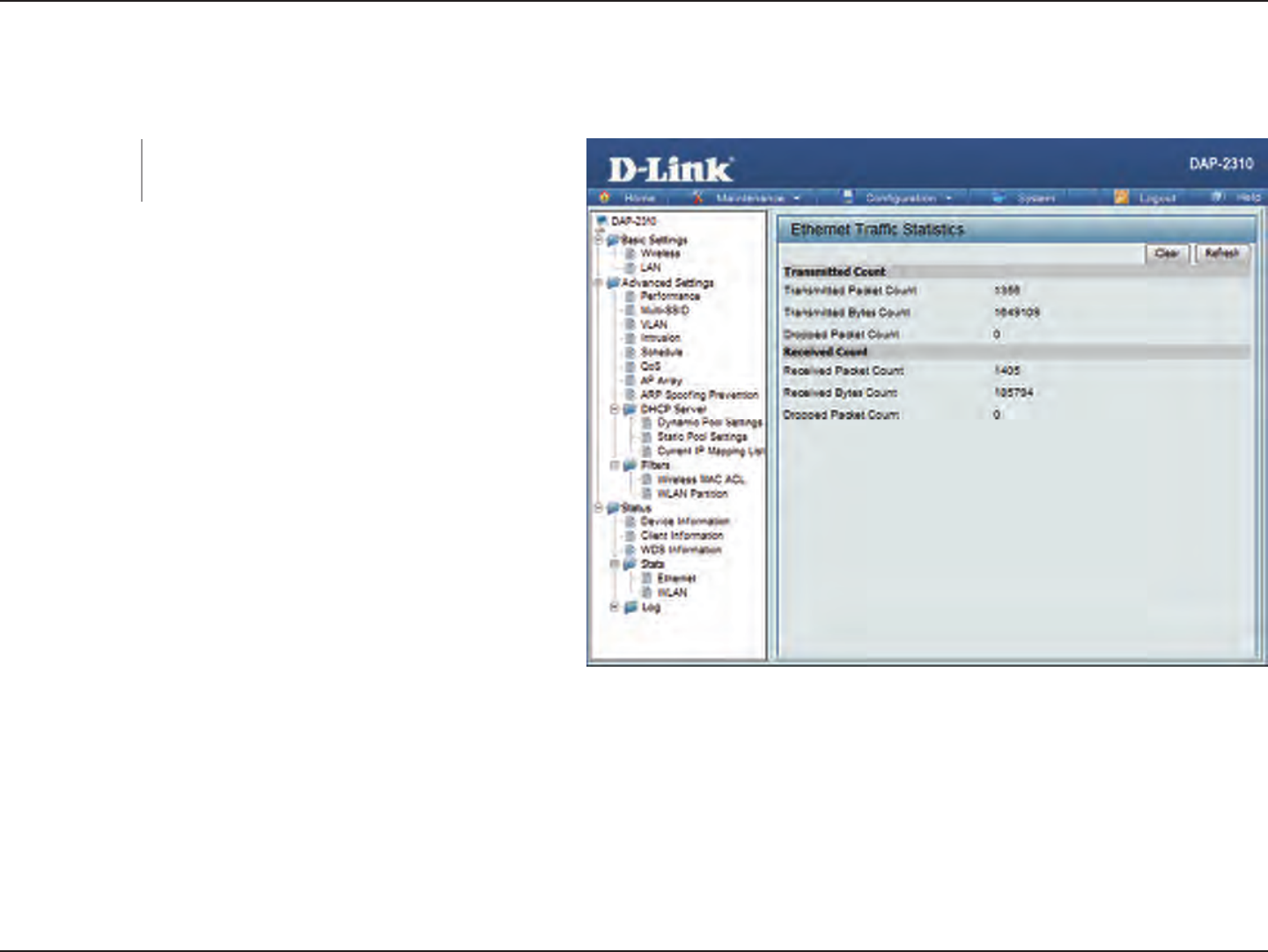
71D-Link DAP-2310 User Manual
Section 3 - Conguration
Stats
Ethernet
This page displays transmitted and received
count statistics for packets and bytes.
Ethernet Trac
Statistics:
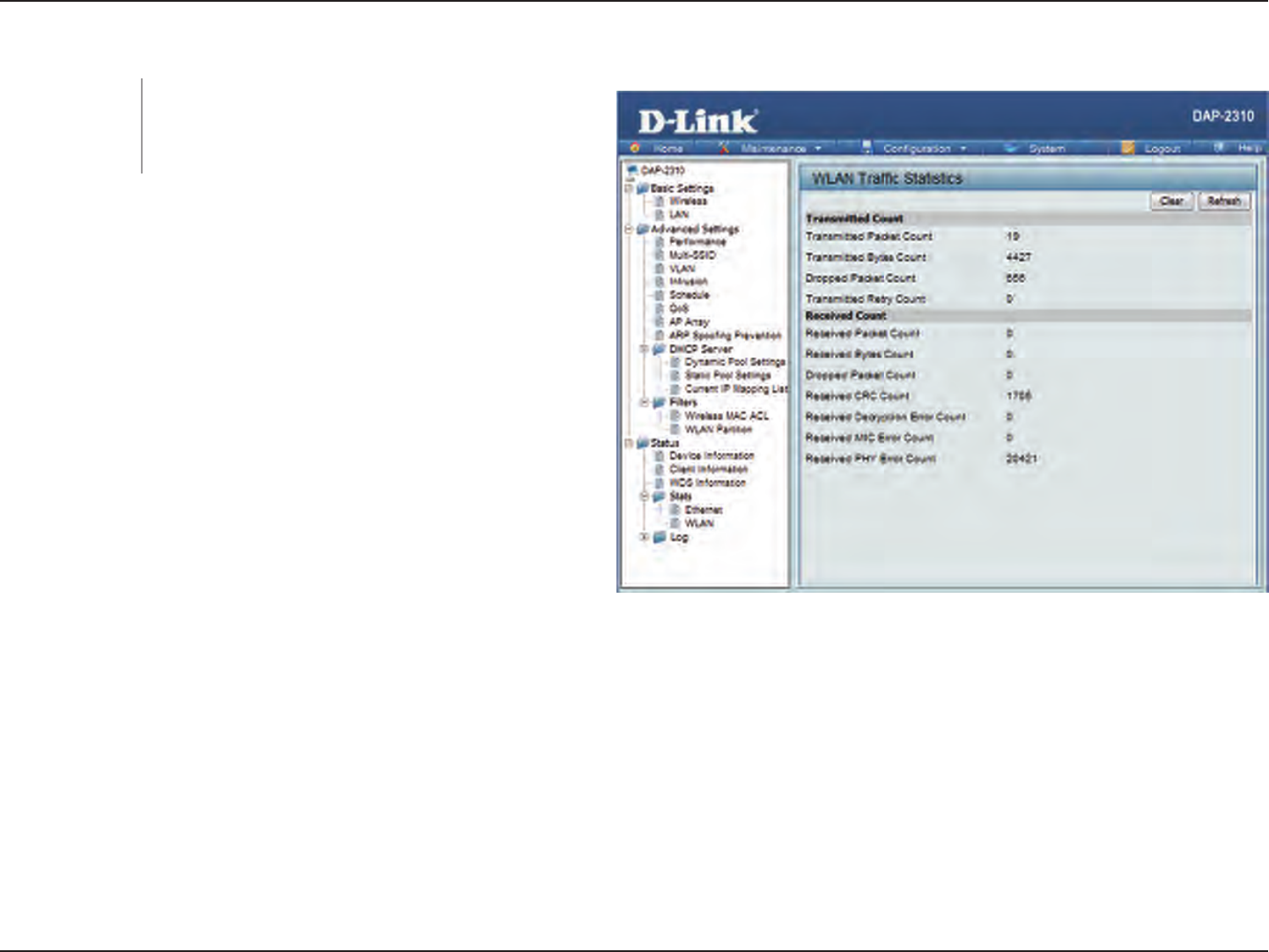
72D-Link DAP-2310 User Manual
Section 3 - Conguration
WLAN Trac
This page displays wireless network statistics
for data throughput, transmitted and received
frames, and frame errors.
WLAN Trac
Statistics:
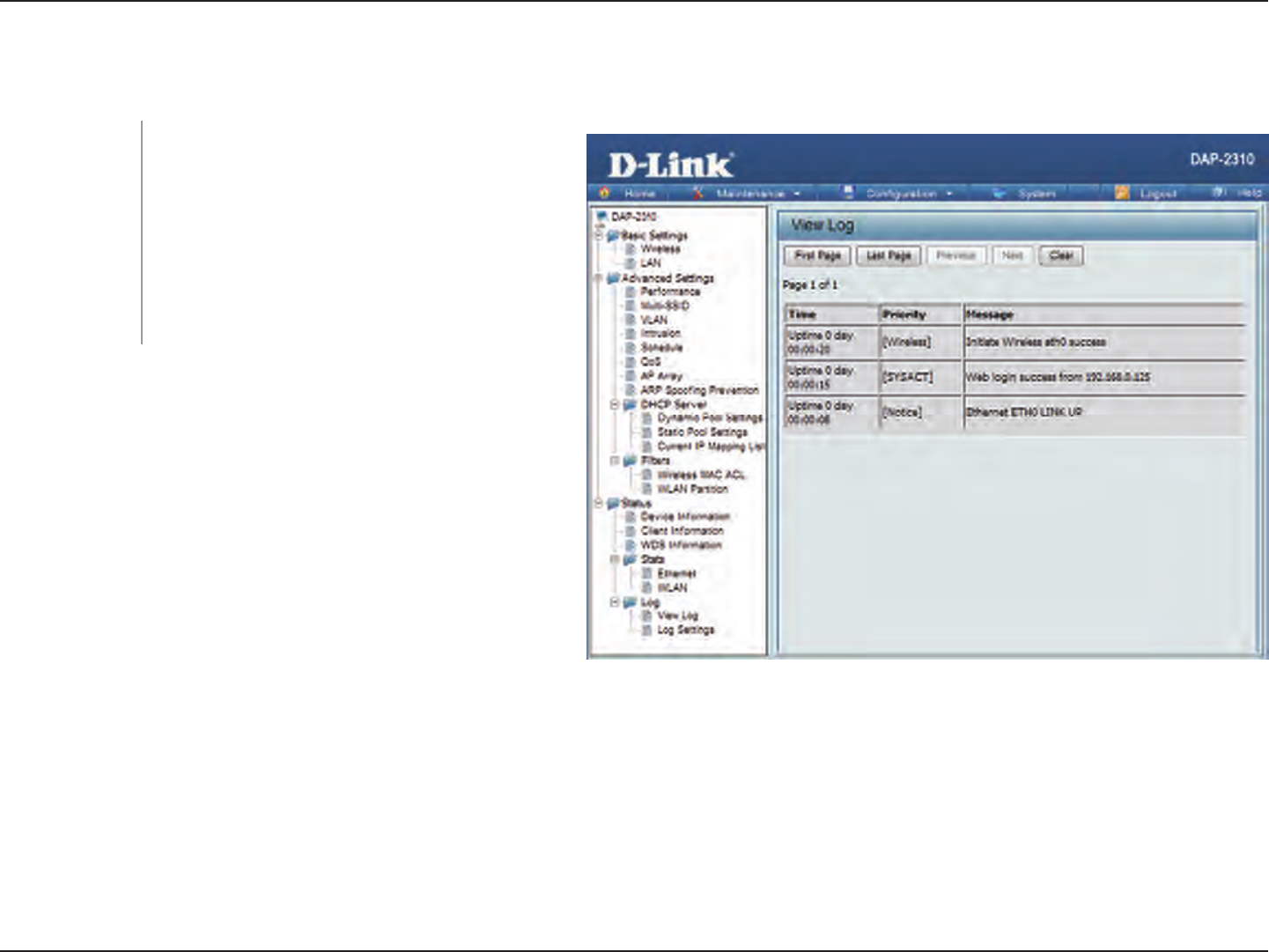
73D-Link DAP-2310 User Manual
Section 3 - Conguration
Log
View Log
The AP’s embedded memory displays system
and network messages including a time stamp
and message type. The log information includes
but is not limited to the following items: cold
start AP, upgrading rmware, client associate
and disassociate with AP, and web login. The
web page holds up to 500 logs.
View Log:
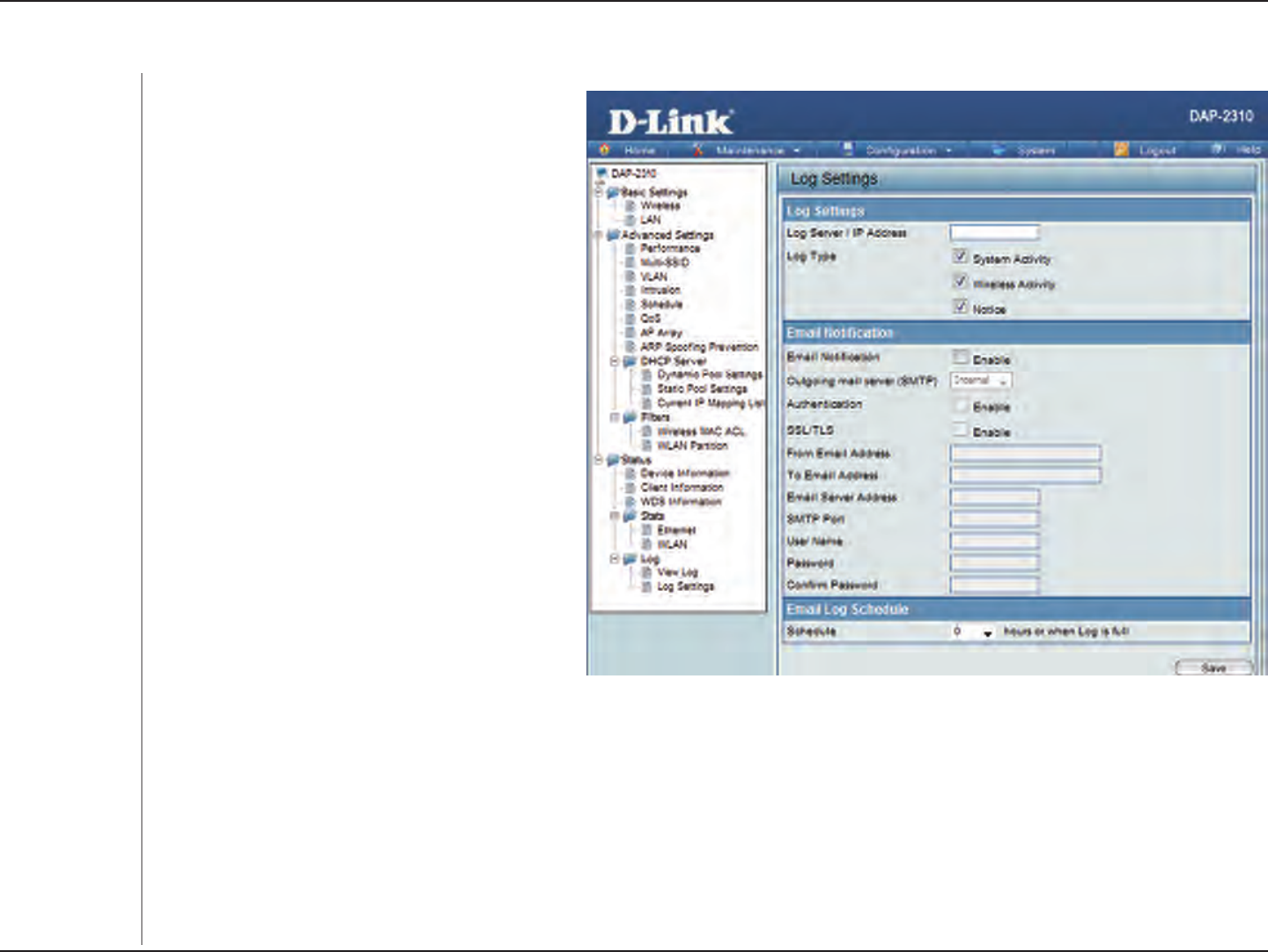
74D-Link DAP-2310 User Manual
Section 3 - Conguration
Log Settings
Enter the IP address of the server you would
like to send the DAP-2310 log to.
Check the box for the type of activity you want
to log. There are three types: System Activity,
Wireless Activity, and Notice.
Check to enable Email notication.
Select the SMTP server from the drop-down
menu.
Check to enable authentication.
Check to enable SSL/TLS authentication.
Enter the “From” email address.
Enter the destination email address.
Enter the Email Server Address.
Enter the SMTP port.
Enter your email username.
Enter your email password.
Enter your email password again.
Select when to send the log to your email (in
hours). You will receive an email when the log
is full too.
Log Server/IP
Address:
Log Type:
Email Notication:
Outgoing Mail
Server (SMTP):
Authentication:
SSL / TLS:
From Email
Address:
To Email Address:
Email Server
Address:
SMTP Port:
Username:
Password:
Conrm Password:
Schedule:
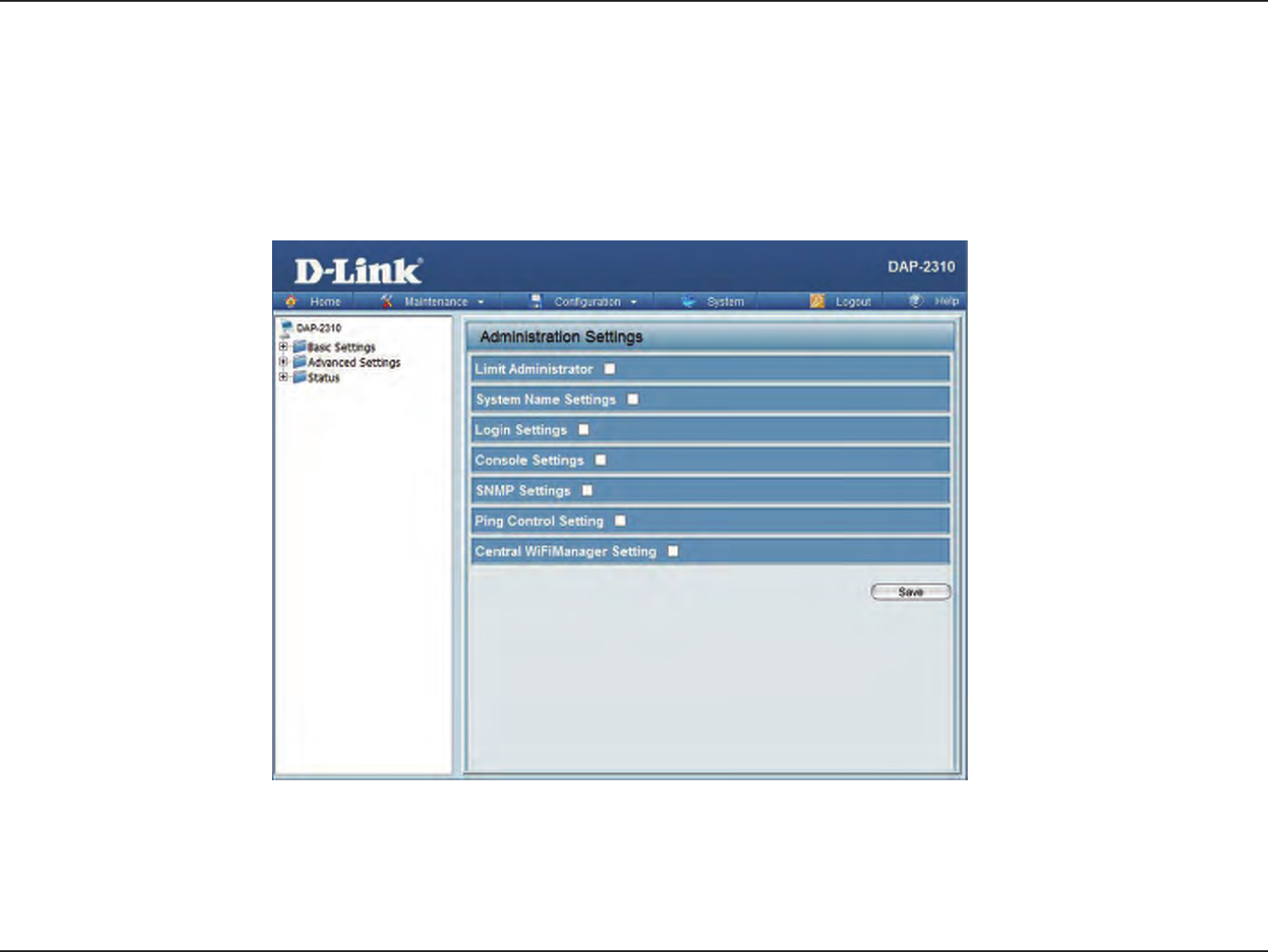
75D-Link DAP-2310 User Manual
Section 3 - Conguration
Check one or more of the five main categories to display the various hidden administrator parameters and settings
displayed on the next ve pages.
Maintenance
Administration Settings
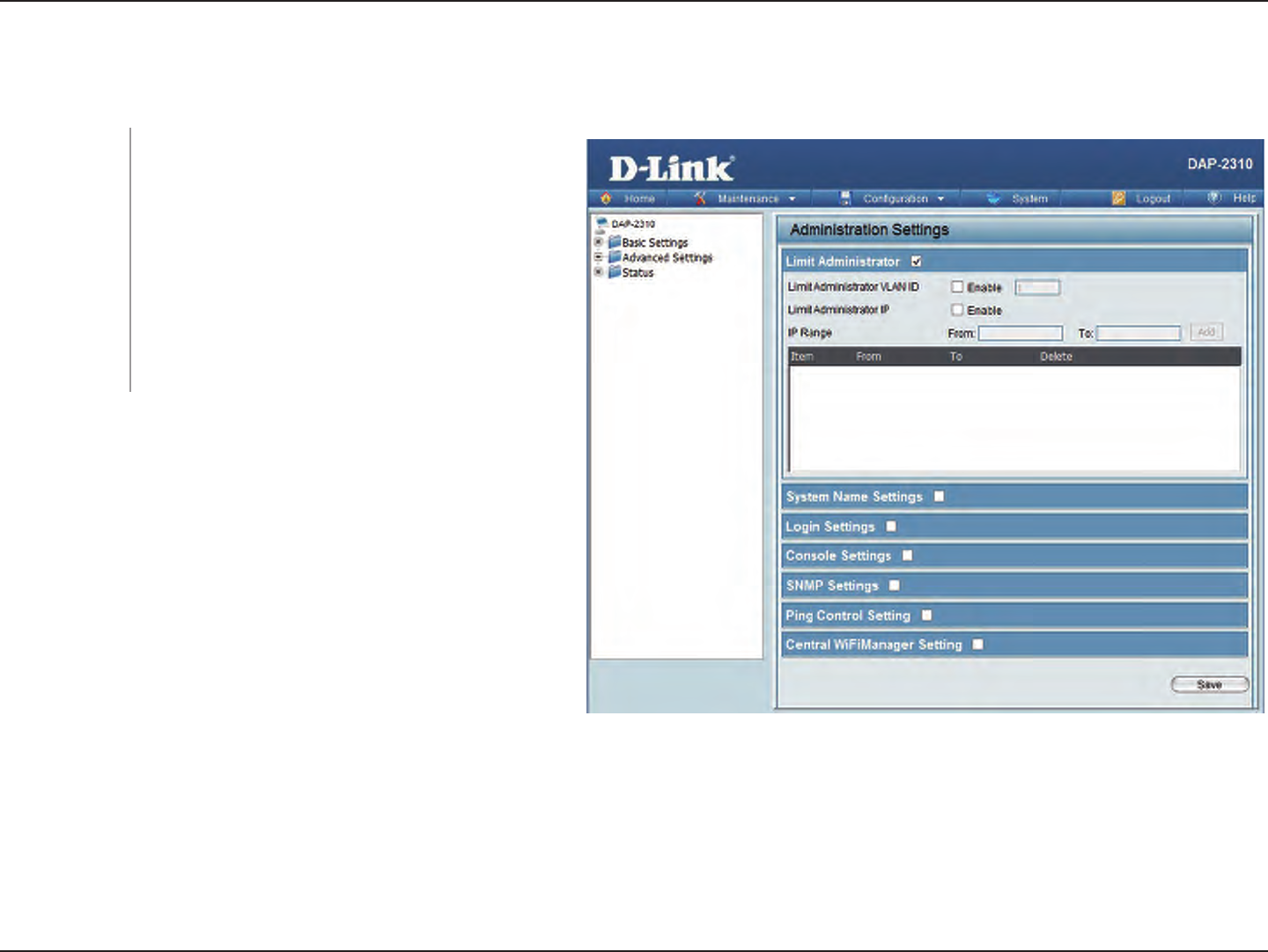
76D-Link DAP-2310 User Manual
Section 3 - Conguration
Limit Administrator
Each of the ve main categories display various hidden administrator parameters and settings.
Check the box provided and the enter the
specic VLAN ID that the administrator will be
allowed to log in from.
Check to enable the Limit Administrator IP
address.
Enter the IP address range that the administrator
will be allowed to log in from and then click the
Add button.
Limit
Administrator
VLAN ID:
Limit
Administrator IP:
IP Range:
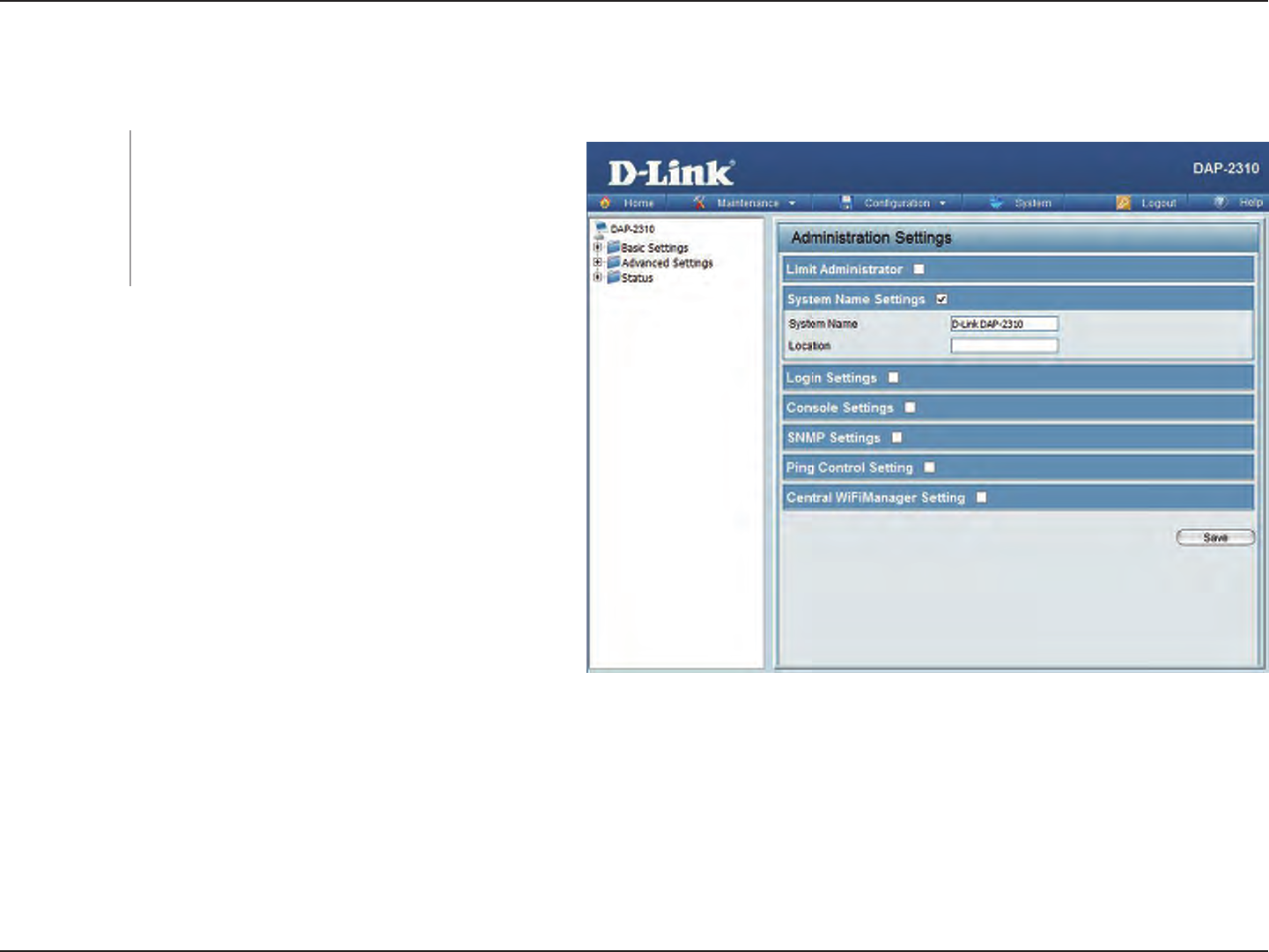
77D-Link DAP-2310 User Manual
Section 3 - Conguration
System Name Settings
Each of the ve main categories display various hidden administrator parameters and settings.
The name of the device. The default name is
D-Link DAP-2310.
The physical location of the device, e.g. 72nd
Floor, D-Link HQ.
System Name:
Location:
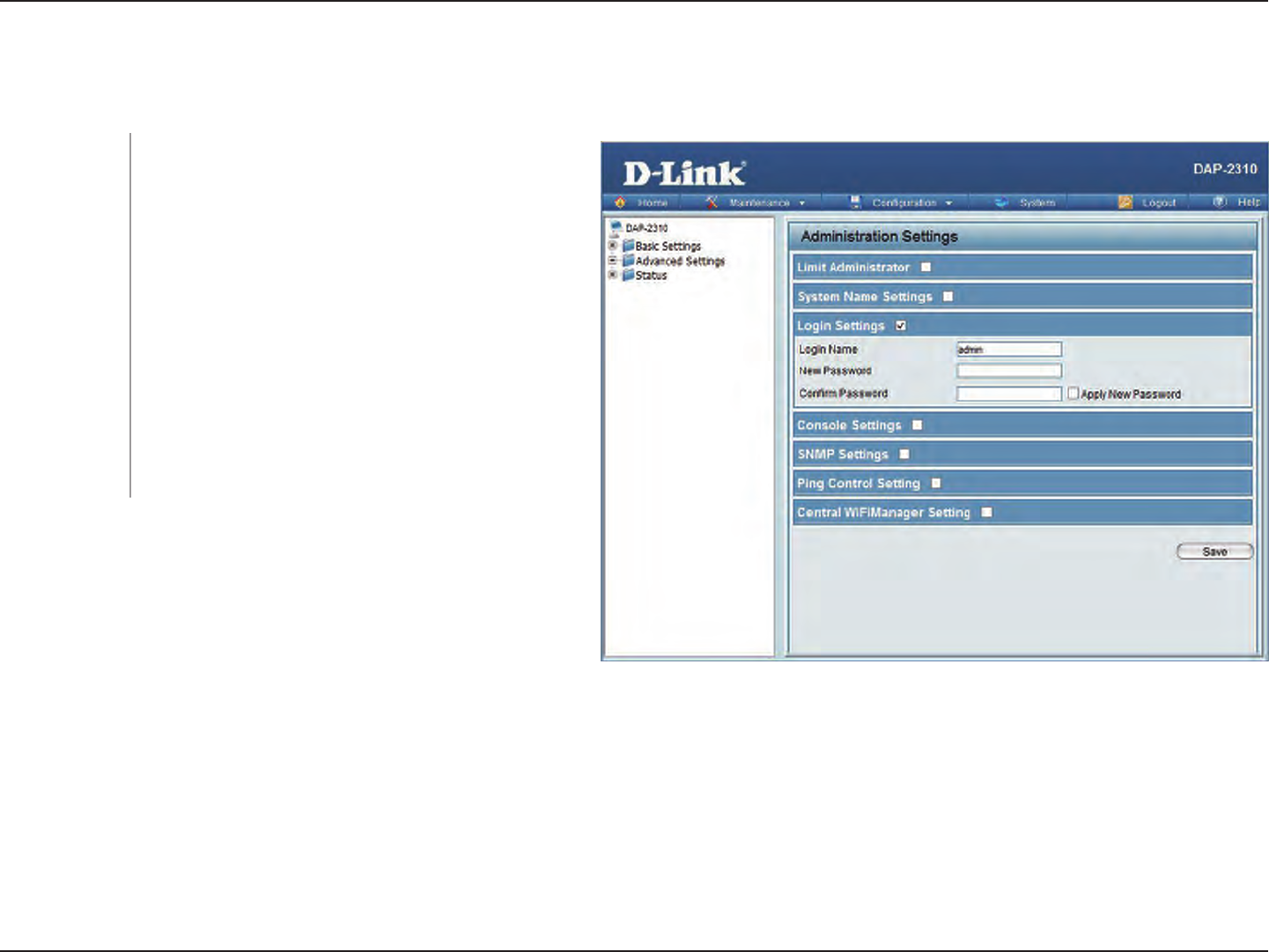
78D-Link DAP-2310 User Manual
Section 3 - Conguration
Login Settings
Each of the ve main categories display various hidden administrator parameters and settings.
Enter a user name. The default is admin.
When changing your password, enter the old
password here.
When changing your password, enter the new
password here. The password is case-sensitive. “A”
is a dierent character than “a.” The length should
be between 0 and 12 characters.
Enter the new password a second time for
conrmation purposes.
Login Name:
Old Password:
New Password:
Conrm
Password:
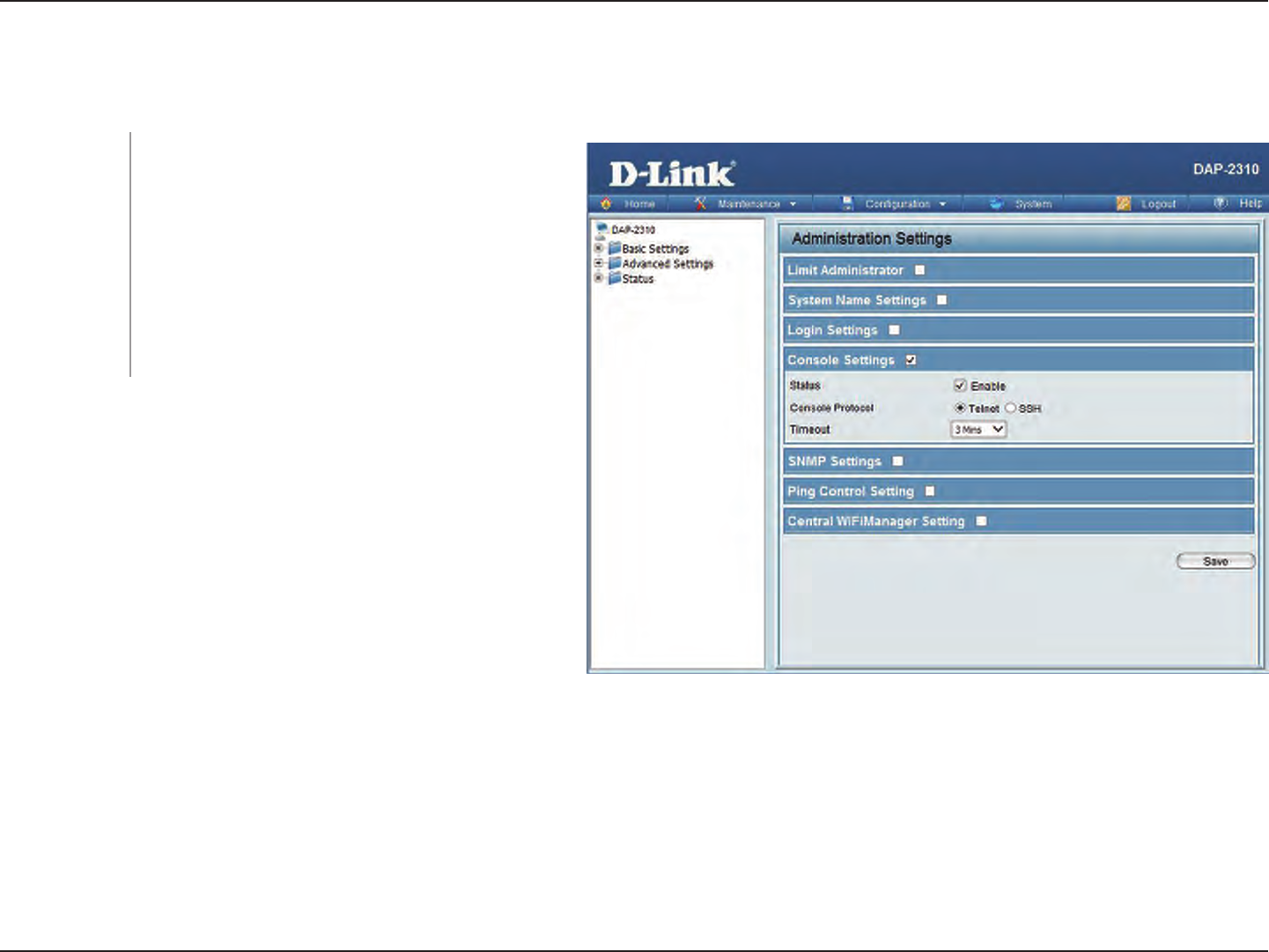
79D-Link DAP-2310 User Manual
Section 3 - Conguration
Console Settings
Each of the ve main categories display various hidden administrator parameters and settings.
Status is enabled by default. Uncheck the box to
disable the console.
Select the type of protocol you would like to use,
Telnet or SSH.
Set to 1 Min, 3 Mins, 5 Mins, 10 Mins, 15 Mins
or Never.
Status:
Console
Protocol:
Timeout:
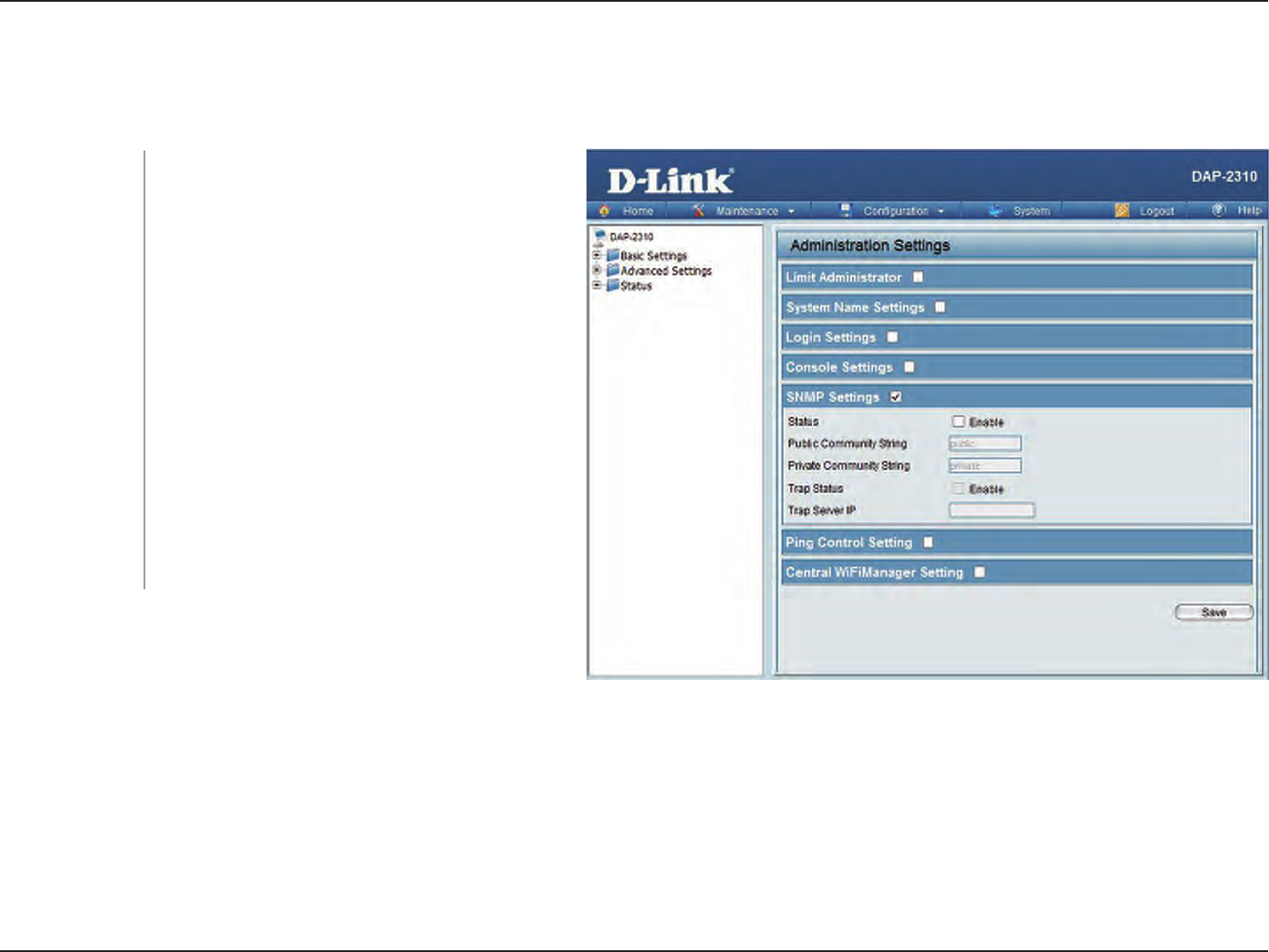
80D-Link DAP-2310 User Manual
Section 3 - Conguration
SNMP Settings
Each of the ve main categories display various hidden administrator parameters and settings.
Check the box to enable the SNMP
functions. This option is disabled by
default.
Enter the public SNMP community string.
Enter the private SNMP community string.
Check the box to enable Trap Status.
Enter the Trap Server IP address.
Status:
Public Community
String:
Private
Community
String:
Trap Status:
Trap Server IP:
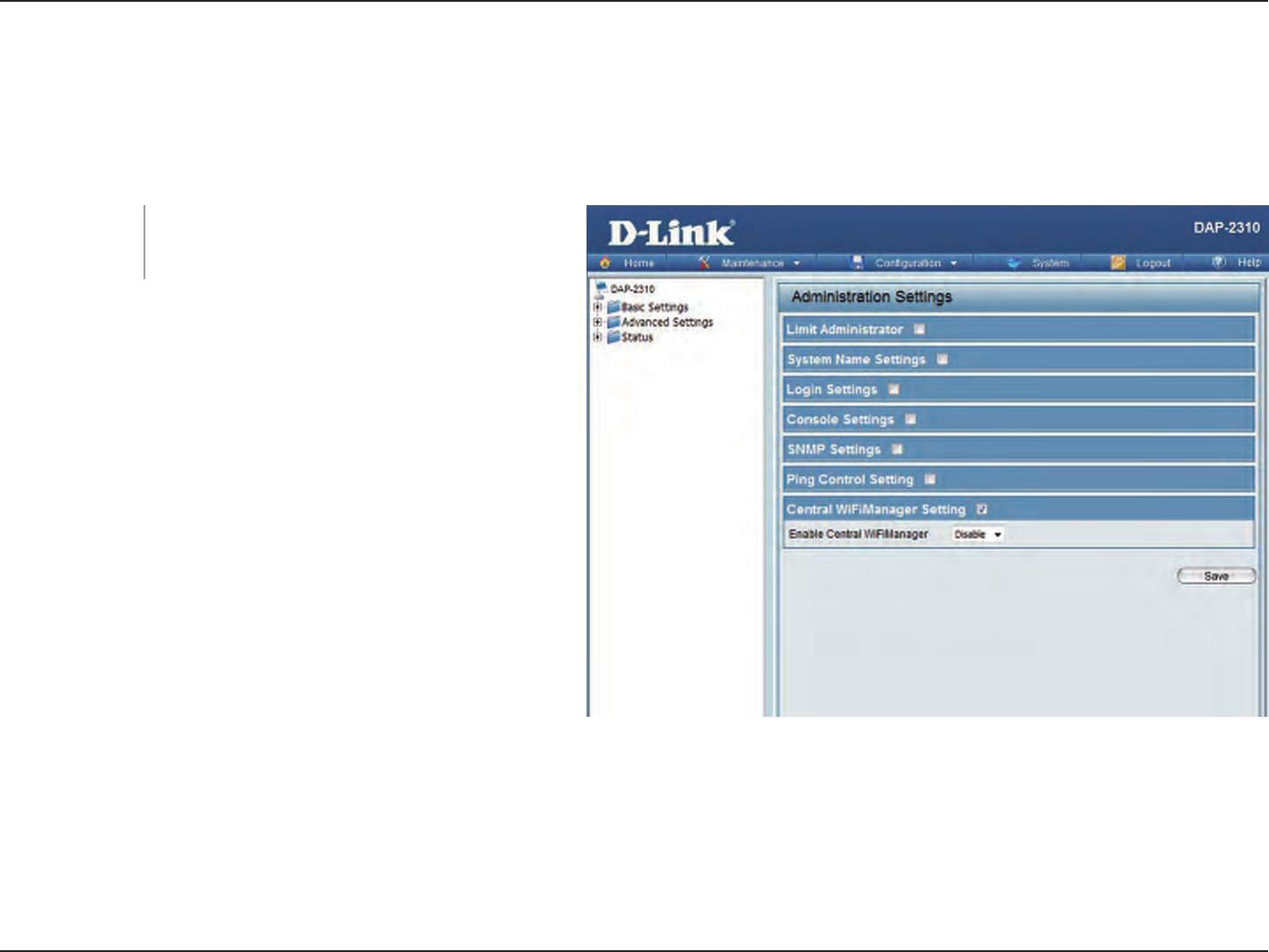
81D-Link DAP-2310 User Manual
Section 3 - Conguration
Enable Central
WiFiManager:
Central WiFiManager Settings
The Central WiFiManager section is used to create a set of APs on the Internet to be organized into a single group in order to
increase ease of management. Central WiFiManager and AP Array are mutually exclusive functions.
Select to enable or disable the Central
WiFiManager.
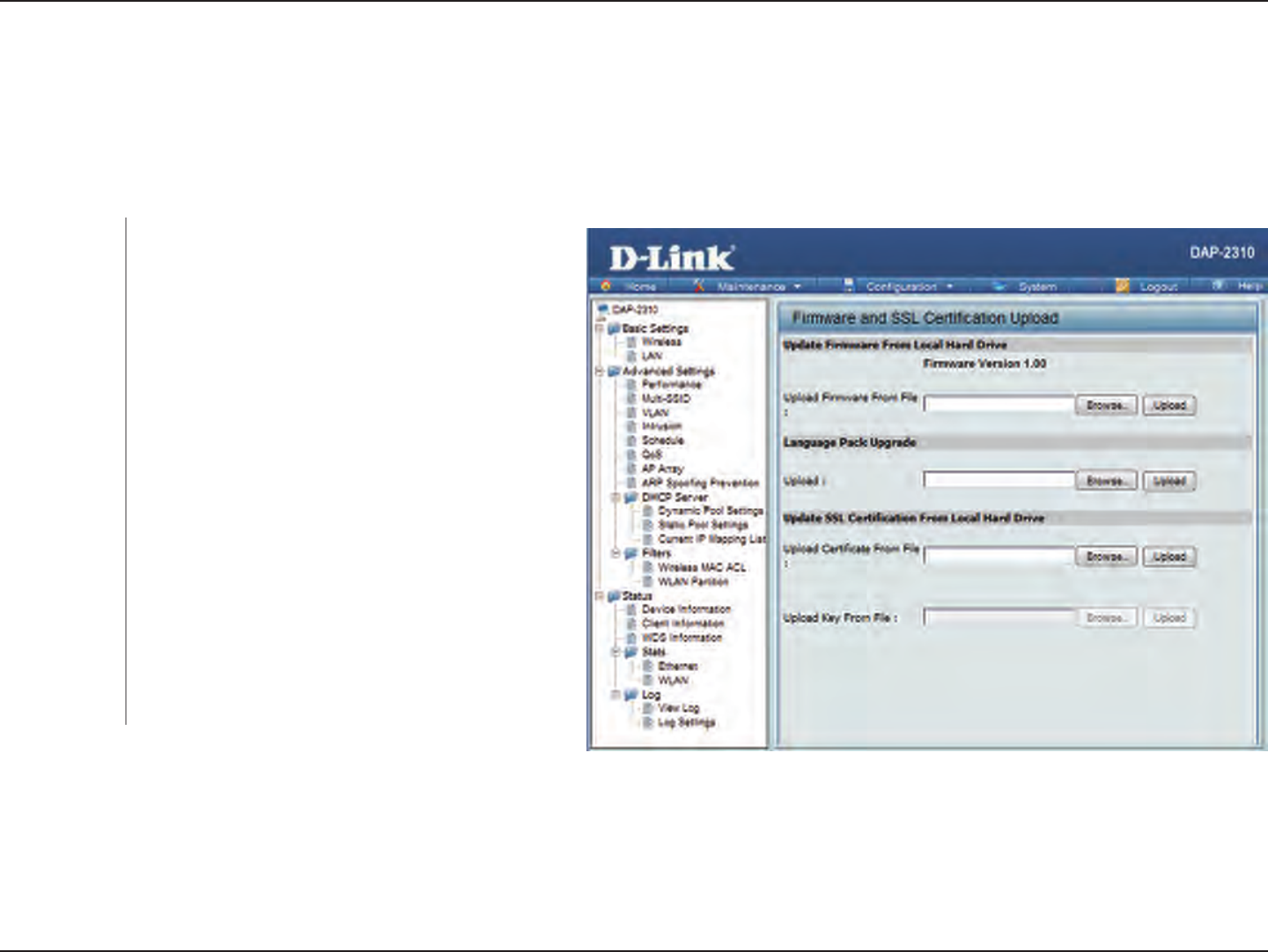
82D-Link DAP-2310 User Manual
Section 3 - Conguration
Firmware and SSL Certication Upload
The current firmware version is displayed
above the le location eld. After downloading
the most recent version of firmware for the
DAP-2310 from http://support.dlink.com to your
local computer, use the Browse button to locate
the rmware le on your computer. Click Upload
to update the rmware version. Please don’t turn
the power o while upgrading.
You may load a language pack to display the
utility in another language. Click Browse to
locate the language pack file on your local
computer. After selecting and opening the
file, click Upload to upload the file to the
DAP-2310.
Click Browse to locate the SSL Certication le on
your local computer. After selecting and opening
the le, click Upload to upload the le to the
DAP-2310.
Upload
Firmware From
Local Hard Drive:
Language Pack
Upgrade:
Upload SSL
Certication
From Local Hard
Drive:
This page allows the user to perform a rmware upgrade. A Firmware upgrade is a function that upgrade the running software
used by the access point. This is a useful feature that prevents future bugs and allows for new features to be added to this
product. Please go to your local D-Link website to see if there is a newer version rmware available.
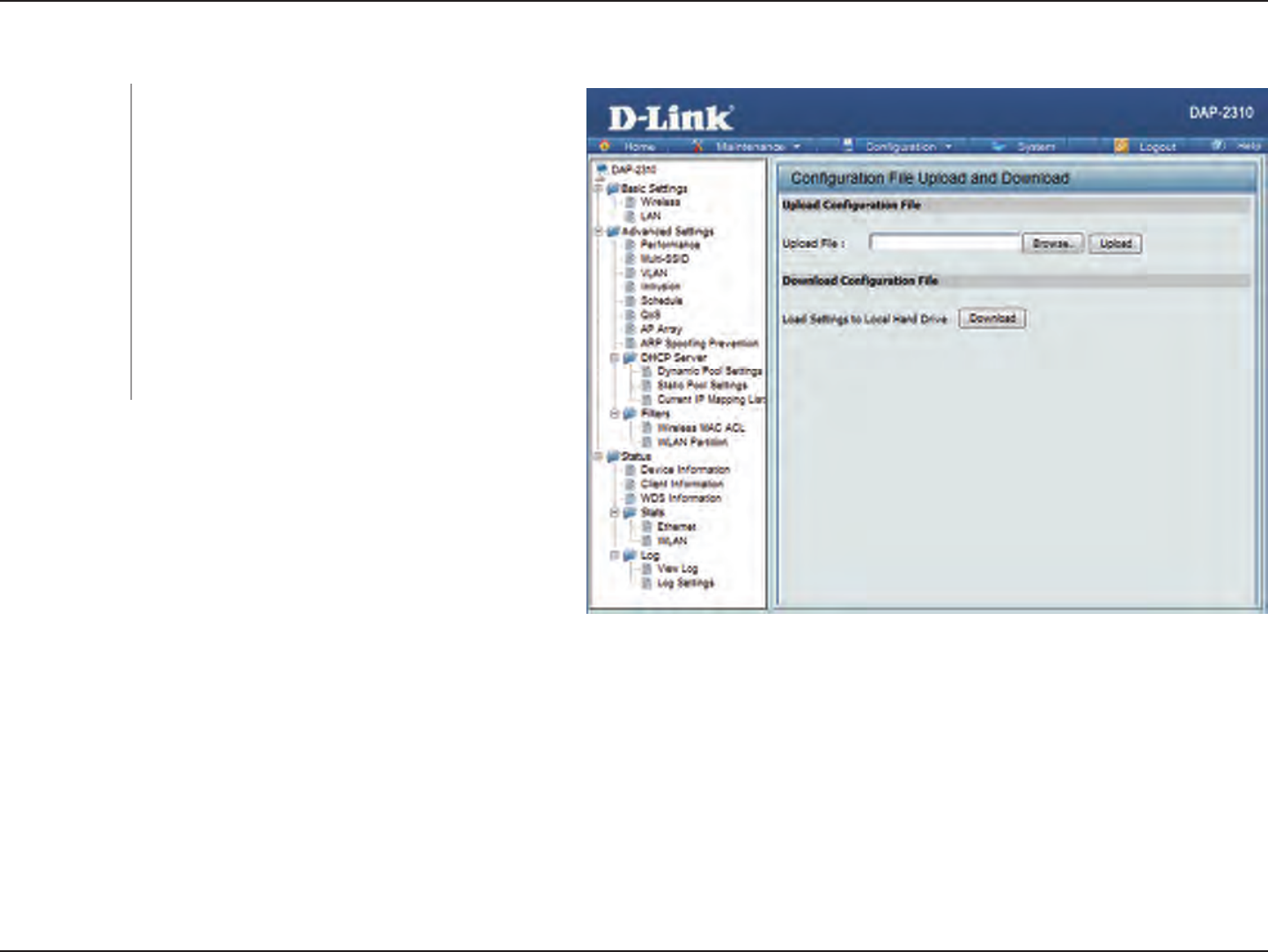
83D-Link DAP-2310 User Manual
Section 3 - Conguration
Conguration File Upload
Click the Browse button to locate a previously
saved conguration le on your local computer.
After selecting the le, click Upload to apply the
conguration settings to the DAP-2310.
Click Download to save the current DAP-2310
configuration to your local computer. Note
that if you save one configuration with the
administrator’s password now, after resetting
your DAP-2310, and then updating to this saved
conguration le, the password will be gone.
Upload File:
Download
Conguration
File:
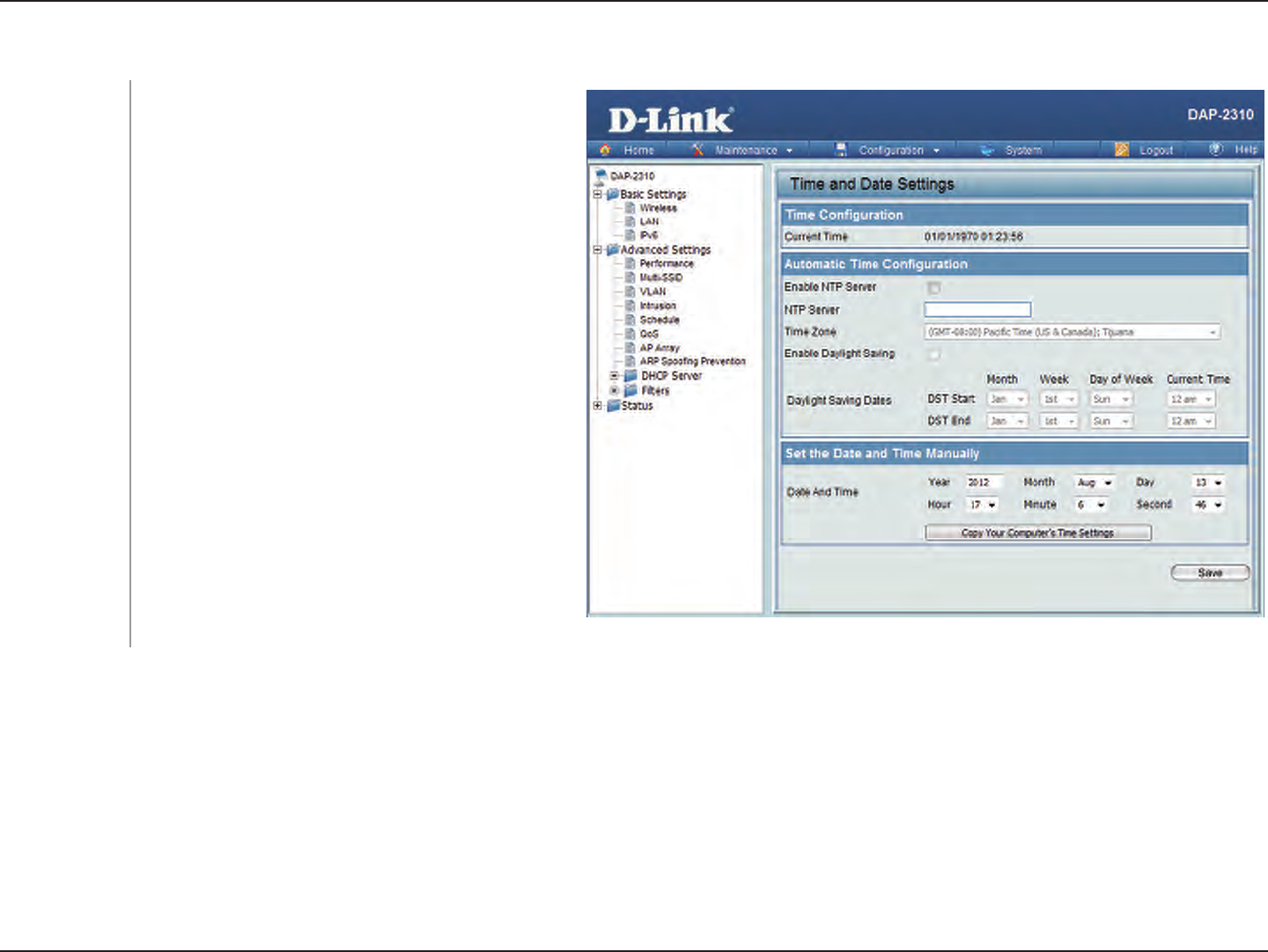
84D-Link DAP-2310 User Manual
Section 3 - Conguration
Time and Date
Displays the current time and date settings.
Check to enable the AP to get system time from
an NTP server.
Enter the NTP server URL or IP address.
Use the drop-down menu to select your correct
Time Zone.
Check the box to Enable Daylight Saving Time.
Use the drop-down menu to select the correct
Daylight Saving oset.
You can either manually set the time for your AP
here, or you can click the Copy Your Computer’s
Time Settings button to copy the time from
the computer you are using (Make sure that the
computer’s time is set correctly).
Current Time:
Enable NTP
Server:
NTP Server:
Time Zone:
Enable Daylight
Saving:
Daylight Saving
Dates:
Set the Date
and Time
Manually:
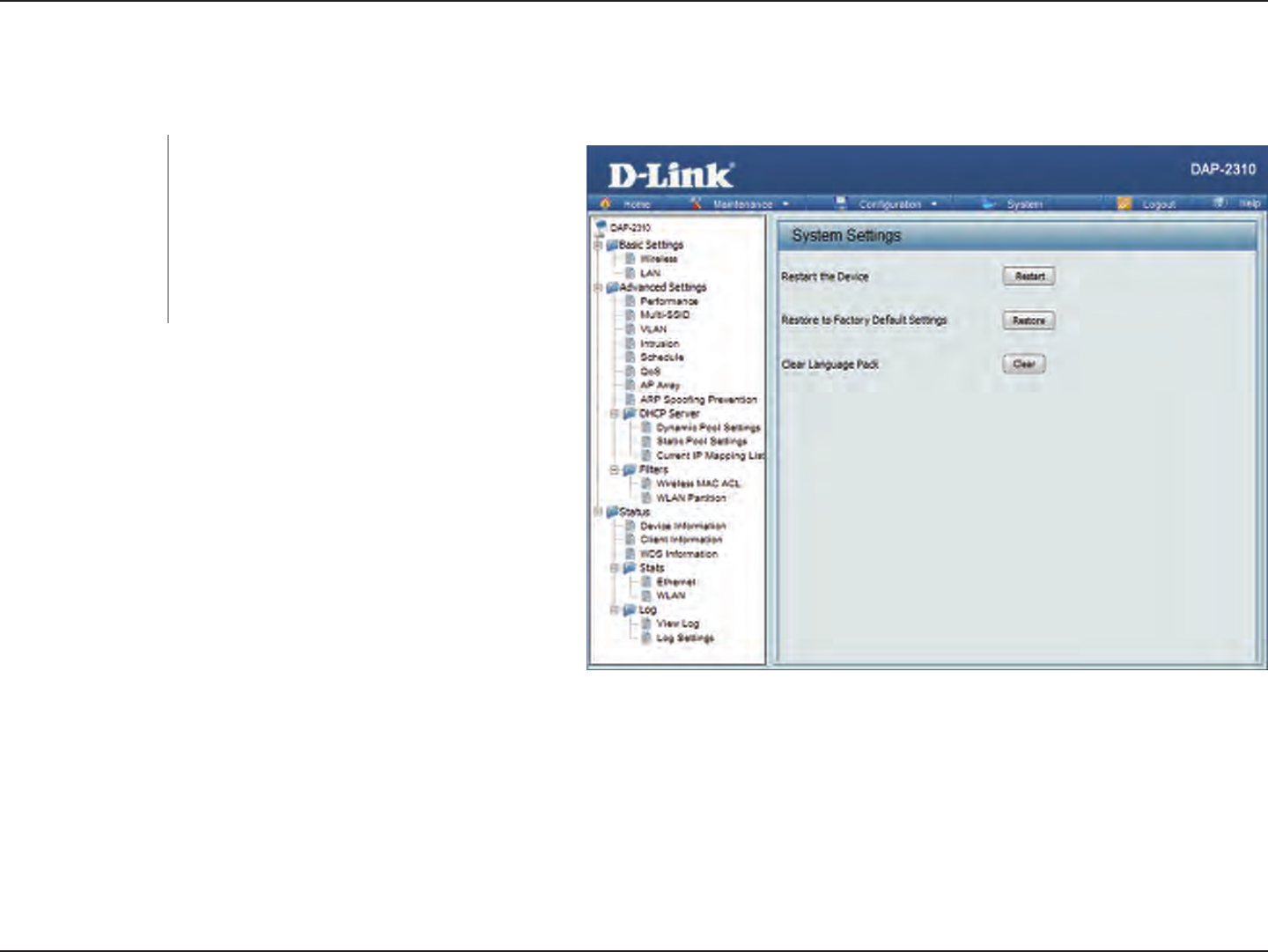
85D-Link DAP-2310 User Manual
Section 3 - Conguration
System
System Settings
Click Restart to restart the DAP-2310.
Click Restore to restore the DAP-2310 back
to factory default settings.
Click Clear to remove any loaded language
packs.
Restart the Device:
Restore to Factory
Default Settings:
Clear Language Pack:
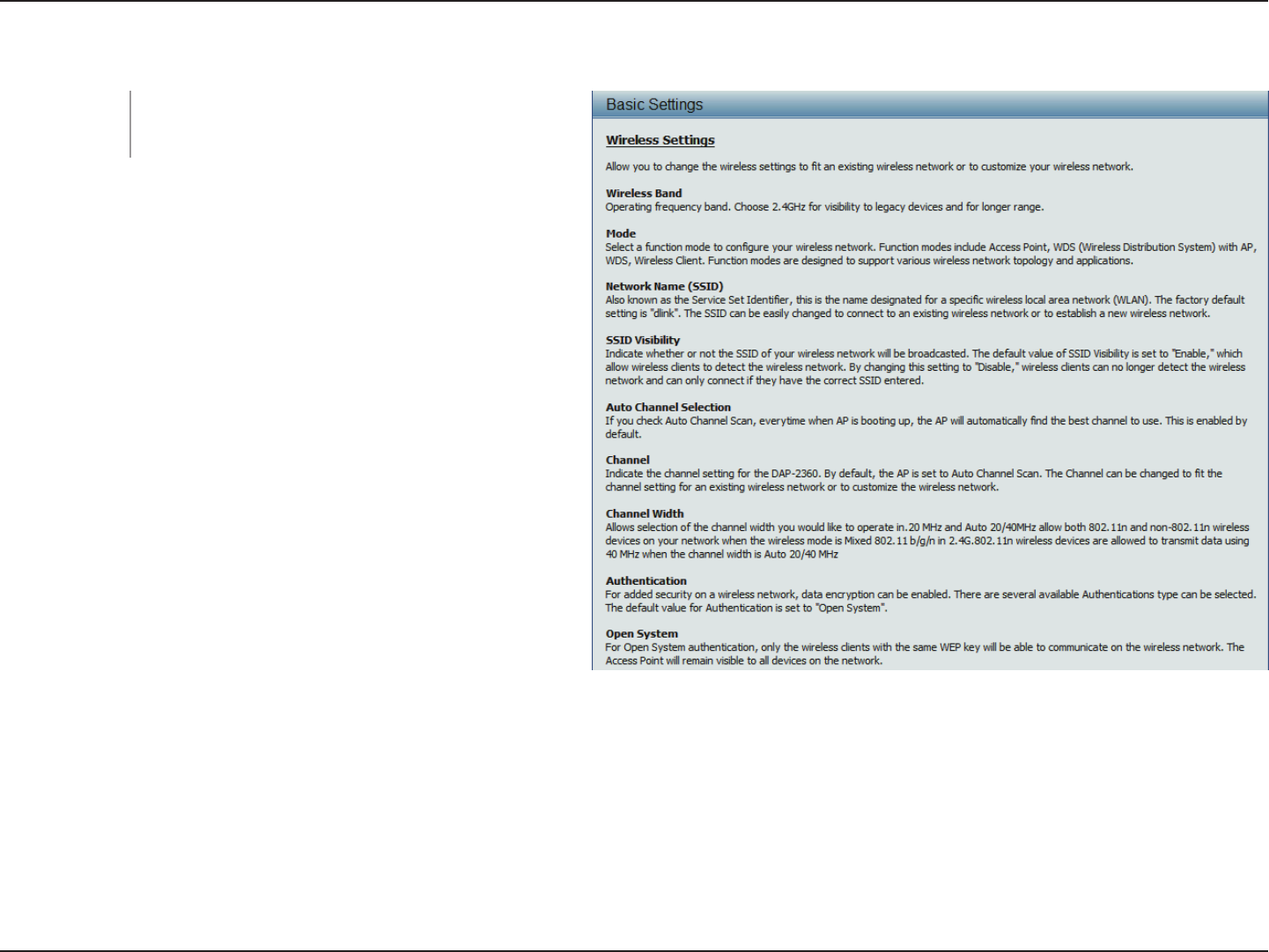
86D-Link DAP-2310 User Manual
Section 3 - Conguration
Help
Scroll down the Help page for topics and
explanations.
Help:
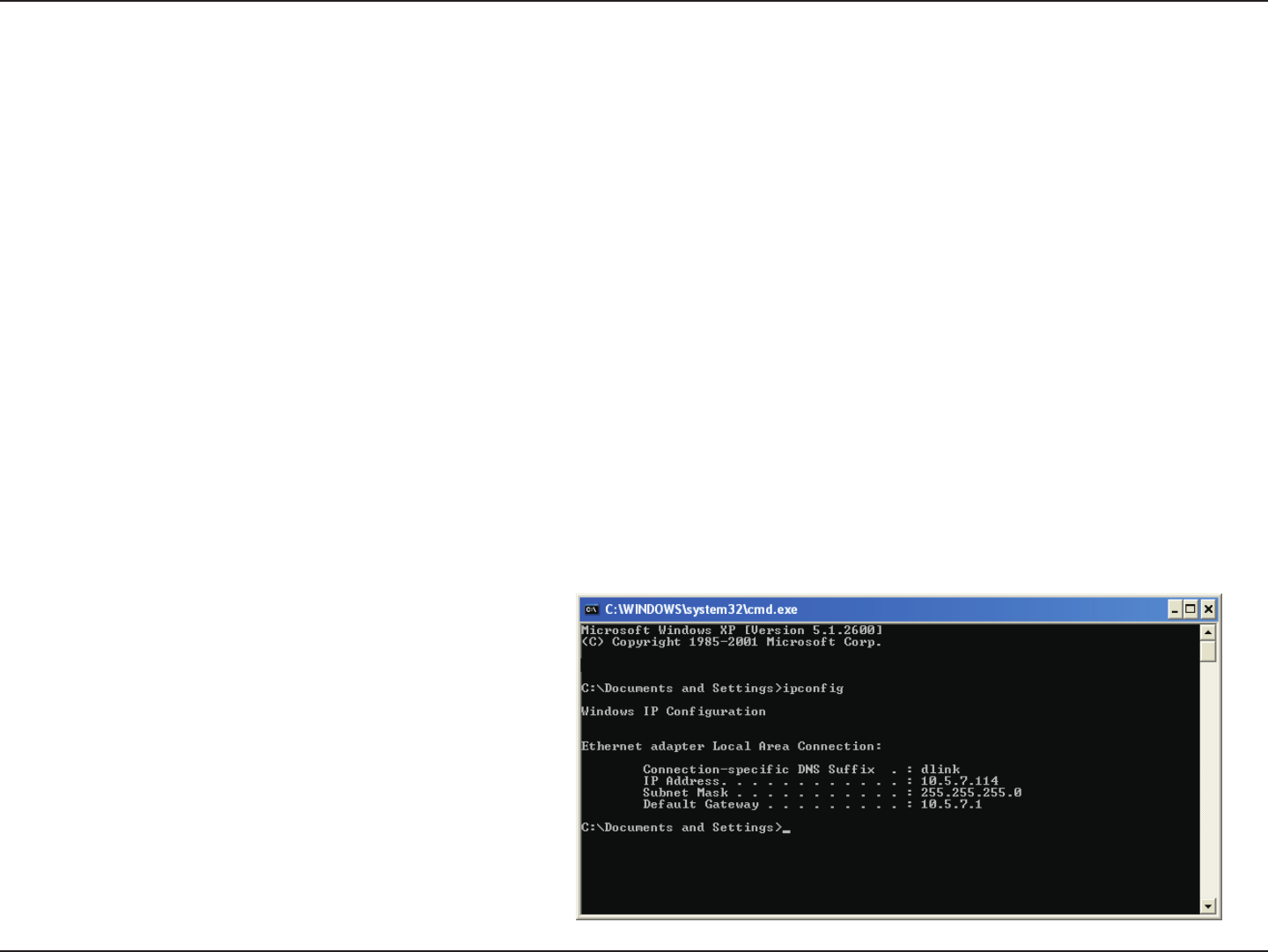
87D-Link DAP-2310 User Manual
Section 6 - Troubleshooting
Troubleshooting
This chapter provides solutions to problems that can occur during the installation and operation of the DAP-2310. Read the
following descriptions if you are having problems. (The examples below are illustrated in Windows® XP. If you have a dierent
operating system, the screenshots on your computer will look similar to the following examples.)
1. Why can’t I access the web-based conguration utility?
When entering the IP address of the D-Link access point (192.168.0.50 for example), you are not connecting to a website on
the Internet nor do you have to be connected to the Internet.
Networking Basics
Check your IP address
After you install your network adapter, by default, the TCP/IP settings should be set to obtain an IP address from a DHCP server
(i.e. wireless router) automatically. To verify your IP
address, please follow the steps below.
Click on Start > Run. In the run box type cmd and click
OK.
At the prompt, type ipcong and press Enter.
This will display the IP address, subnet mask, and the
default gateway of your adapter.

88D-Link DAP-2310 User Manual
Section 6 - Troubleshooting
If the address is 0.0.0.0, check your adapter installation, security settings, and the settings on your router. Some rewall software
programs may block a DHCP request on newly installed adapters.
• Make sure you have an updated Java-enabled web browser. We recommend the following:
- Microsoft Internet Explorer® 6.0 and higher
- Mozilla Firefox 3.0 and higher
- Google™ Chrome 2.0 and higher
- Apple Safari 3.0 and higher
• Verify physical connectivity by checking for solid link lights on the device. If you do not get a solid link light, try using a dierent
cable or connect to a dierent port on the device if possible. If the computer is turned o, the link light may not be on.
• Disable any internet security software running on the computer. Software rewalls such as Zone Alarm, Black Ice, Sygate,
Norton Personal Firewall, and Windows® XP rewall may block access to the conguration pages. Check the help les included
with your rewall software for more information on disabling or conguring it.

89D-Link DAP-2310 User Manual
Appendix B - Networking Basics
Statically Assign an IP address
If you are not using a DHCP capable gateway/router, or you need to assign a static IP address, please follow the steps below:
Step 1
Windows® 2000: Click on Start > Settings > Control Panel > Network Connections
Windows® XP: Click on Start > Control Panel > Network Connections
Windows Vista®: Click on Start > Control Panel > Network and Internet > Network and Sharing Center > Manage network
connections
Step 2
Right-click on the Local Area Connection which represents your network adapter and select Properties.
Step 3
Highlight Internet Protocol (TCP/IP) and click Properties.
Step 4
Click Use the following IP address and enter an IP address that is on the same subnet as your network or the LAN IP address
on your router.
Example: If the router’s LAN IP address is 192.168.0.1, make your IP address 192.168.0.X where X is a number between 2
and 99. Make sure that the number you choose is not in use on the network. Set Default Gateway the same as the LAN IP
address of your router (192.168.0.1).
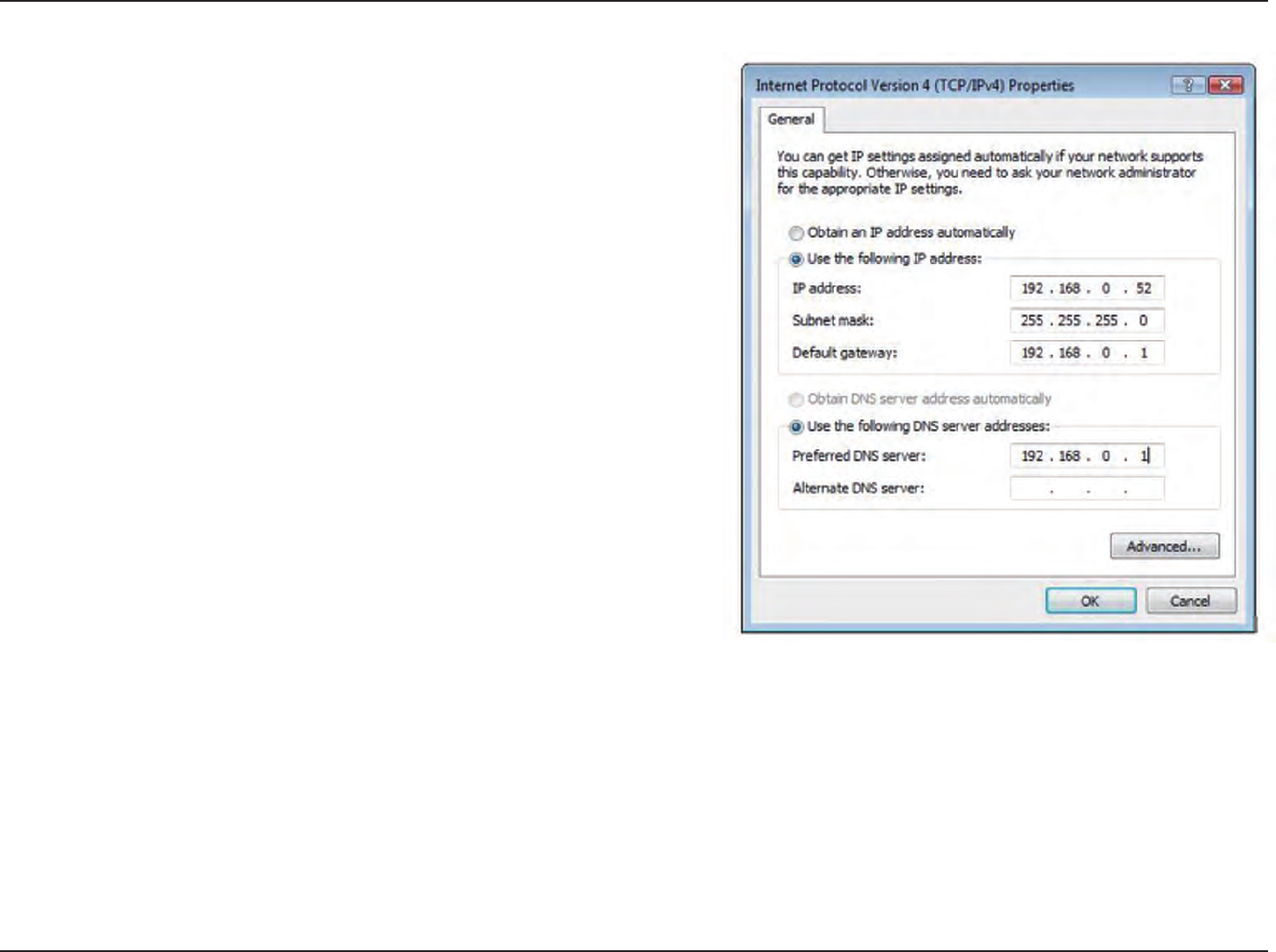
90D-Link DAP-2310 User Manual
Appendix B - Networking Basics
Set Primary DNS the same as the LAN IP address of your router
(192.168.0.1). The Secondary DNS is not needed or you may enter a
DNS server from your ISP.
Step 5
Click OK twice to save your settings.

91D-Link DAP-2310 User Manual
Appendix B - Networking Basics
• Congure your Internet settings:
• Go to Start > Settings > Control Panel. Double-click the Internet Options Icon. From the Security tab, click the
button to restore the settings to their defaults.
• Click the Connection tab and set the dial-up option to Never Dial a Connection. Click the LAN Settings button.
Make sure nothing is checked. Click OK.
• Go to the Advanced tab and click the button to restore these settings to their defaults. Click OK three times.
• Close your web browser (if open) and open it.
• Access the web management. Open your web browser and enter the IP address of your D-Link access point in the address
bar. This should open the login page for your the web management.
• If you still cannot access the conguration, unplug the power to the access point for 10 seconds and plug back in. Wait about
30 seconds and try accessing the conguration. If you have multiple computers, try connecting using a dierent computer.
2. What can I do if I forgot my password?
If you forgot your password, you must reset your access point. Unfortunately, this process will change all your settings back
to the factory defaults.
To reset the access point, locate the reset button (hole) on the rear panel of the unit. With the access point powered on, use a
paperclip to hold the button down for 10 seconds. Release the button and the access point will go through its reboot process.
Wait about 30 seconds to access the access point. The default IP address is 192.168.0.50. When logging in, the username is
admin and leave the password box empty.

92D-Link DAP-2310 User Manual
Appendix C - Technical Specications
Technical Specications
Standards
• IEEE 802.11b
• IEEE 802.11g
• IEEE 802.11n
• IEEE 802.3
• IEEE 802.3u
• IEEE 802.3ab
• IEEE 802.3af
Network Management
• Web Browser interface
HTTP
Secure HTTP (HTTPS)
• Central WiFiManager
• AP Array Tool
• SNMP Support
Private MIB
• Command Line Interface
Telnet
Secure SSH Telnet
Data Rates*
For 802.11b:
• 11, 5.5, 2, and 1 Mbps
For 802.11g:
• 54, 48, 36, 24, 18, 12, 9, and 6 Mbps
For 802.11n:
HT20/HT40
• 144.4/300, 130/270, 117/243, 104/216, 78/162, 66/135, 58.5/121.5, 52/108,
39/81, 26/54, 19.5/40.5, 12/27, and 6.5/13.5 Mbps
Security
• WPA™ Personal/Enterprise
• WPA2™ Personal/Enterprise
• 802.1x
• WEP™ 64-/128-bit
• SSID Broadcast Disable
• MAC Address Access Control
Wireless Frequency Range
• 2.4 to 2.4835 GHz
Operating Voltage
• 48V DC +/- 10% for PoE*** or 12V/1A
Radio and Modulation Type
For 802.11g/n:
BPSK, QPSK, 16QAM, and 64QAM with OFDM
For 802.11b:
DQPSK, DBPSK, DSSS, and CCK
Operating Frequency**
For 802.11b/g:
2.4 ~ 2.4835 GHz
For 802.11n:
2.4 GHz Band: 2.4 ~ 2.4835 GHz
Dipole Antenna
• 2dBi Gain @2.4 GHz
Max Transmit Output Power (Dual Chain)
• FCC: 26dBm
• ETSI: 17dBm
Max Power Consumption
• Max. 8W with 12V/DC
• Max. 9W with PoE***
* Maximum wireless signal rate derived from IEEE Standard 802.11g and 802.11n specications. Actual data throughput will vary. Network conditions and environmental factors,
including volume of network trac, building materials and construction, and network overhead, lower actual data throughput rate. Environmental factors will adversely aect
wireless signal range.
• 5dBi Gain @2.4 GHz

93D-Link DAP-2310 User Manual
Appendix E - Warranty
LEDs
• Power
• LAN
• 2.4 GHz
Temperature
• Operating: 0˚C to 40˚C
• Storing: -20˚C to 65˚C
Humidity
• Operating: 10%~90% (non-condensing)
• Storing: 5%~95% (non-condensing)
Certications
Dimensions
• L = 148mm
• W = 111mm
• H = 28mm
Weight
• 227g
FCC Statement:
Federal Communication Commission Interference Statement
This equipment has been tested and found to comply with the limits for a Class B digital device, pursuant to Part 15 of the FCC Rules. These limits
are designed to provide reasonable protection against harmful interference in a residential installation. This equipment generates, uses and can
radiate radio frequency energy and, if not installed and used in accordance with the instructions, may cause harmful interference to radio
communications. However, there is no guarantee that interference will not occur in a particular installation. If this equipment does cause harmful
interference to radio or television reception, which can be determined by turning the equipment off and on, the user is encouraged to try to correct the
interference by one of the following measures:
● Reorient or relocate the receiving antenna.
● Increase the separation between the equipment and receiver.
● Connect the equipment into an outlet on a circuit different from that to which the receiver is connected.
● Consult the dealer or an experienced radio/TV technician for help.
FCC Caution: Any changes or modifications not expressly approved by the party
responsible for compliance could void the user’s authority to operate this equipment.
This device complies with Part 15 of the FCC Rules. Operation is subject to the following two conditions: (1) This device may not cause harmful
interference, and (2) this device must accept any interference received, including interference that may cause undesired operation.
For product available in the USA/Canada market, only channel 1~11 can be operated. Selection of other channels is not possible.
This device and it's antennas(s) must not be co-located or operating in conjunction with any other antenna or transmitter except in accordance with
FCC multi-transmitter product procedures.
IMPORTANT NOTE:
FCC Radiation Exposure Statement:
This equipment complies with FCC radiation exposure limits set forth for an uncontrolled environment. This equipment should be installed and
operated with minimum distance 20cm between the radiator & your body.
IC Statement:
This device complies with Industry Canada licence-exempt RSS standard(s). Operation is subject to the following two conditions: (1) this device may not cause
interference, and (2) this device must accept any interference, including interference that may cause undesired operation of the device.
Le présent appareil est conforme aux CNR d'Industrie Canada applicables aux appareils radio exempts de licence. L'exploitation est autorisée aux deux
conditions suivantes : (1) l'appareil ne doit pas produire de brouillage, et (2) l'utilisateur de l'appareil doit accepter tout brouillage radioélectrique subi, même si
le brouillage est susceptible d'en compromettre le fonctionnement.
The device meets the exemption from the routine evaluation limits in section 2.5 of RSS 102 and compliance with RSS-102 RF exposure, users can obtain
Canadian information on RF exposure and compliance.
Le dispositif rencontre l'exemption des limites courantes d'évaluation dans la section 2.5 de RSS 102 et la conformité à l'exposition de RSS-102 rf, utilisateurs
peut obtenir l'information canadienne sur l'exposition et la conformité de rf.
This transmitter must not be co-located or operating in conjunction with any other antenna or transmitter. This equipment should be installed and operated with
a minimum distance of 20 centimeters between the radiator and your body.
Cet émetteur ne doit pas être Co-placé ou ne fonctionnant en même temps qu'aucune autre antenne ou émetteur. Cet équipement devrait être installé et
actionné avec une distance minimum de 20 centimètres entre le radiateur et votre corps.
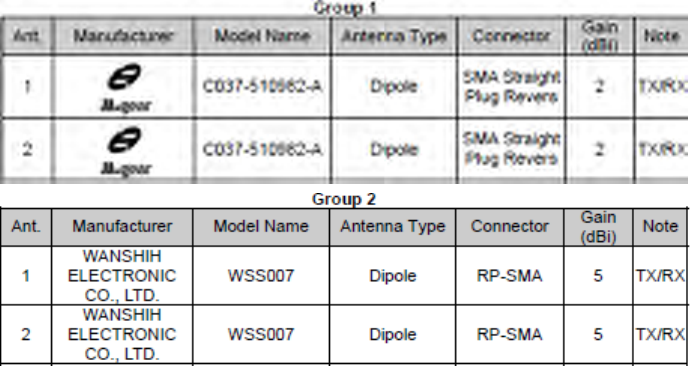
Thisradiotransmitter(C037‐510982‐A/WSS007)hasbeenapprovedbyIndustryCanadato
operatewiththeantennatypeslistedbelowwiththemaximumpermissiblegainandrequired
antennaimpedanceforeachantennatypeindicated.Antennatypesnotincludedinthislist,
havingagaingreaterthanthemaximumgainindicatedforthattype,arestrictlyprohibitedfor
usewiththisdevice.
Leprésentémetteurradio(C037‐510982‐A/WSS007)aétéapprouvéparIndustrieCanadapour
fonctionneraveclestypesd'antenneénumérésci‐dessousetayantungainadmissiblemaximalet
l'impédancerequisepourchaquetyped'antenne.Lestypesd'antennenoninclusdanscetteliste,
oudontlegainestsupérieuraugainmaximalindiqué,sontstrictementinterditspourl'exploitation
del'émetteur.
NCC 警告語
本產品符合低功率電波輻射性電機管理辦法:
第十二條
經形式認證合格之低功率射頻電機,非經許可,公司、商號或使用者均不得擅自變更頻率、加大功率或變更原設計之特性及功能。
第十四條
低功率射頻電機之使用不得影響飛航安全及干擾合法通信;經發現有干擾現象時,應立即停用,並改善至無干擾時方的繼續使用。
前項合法通信,指依電信規定作業之無線電信。低功率射頻電機須忍受合法通信或工業、科學及醫療用電波輻射性電機設備之干擾。
電磁波曝露量 MPE 標準值 1mW/cm2,送測產品實測值為 0.6165 mW/cm2